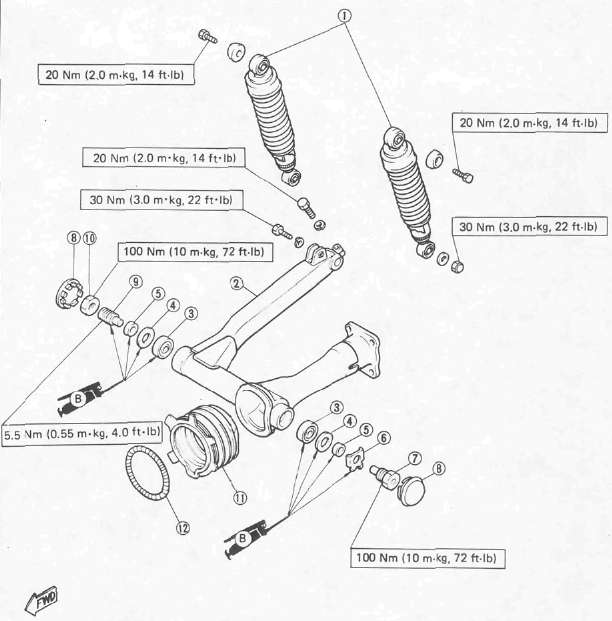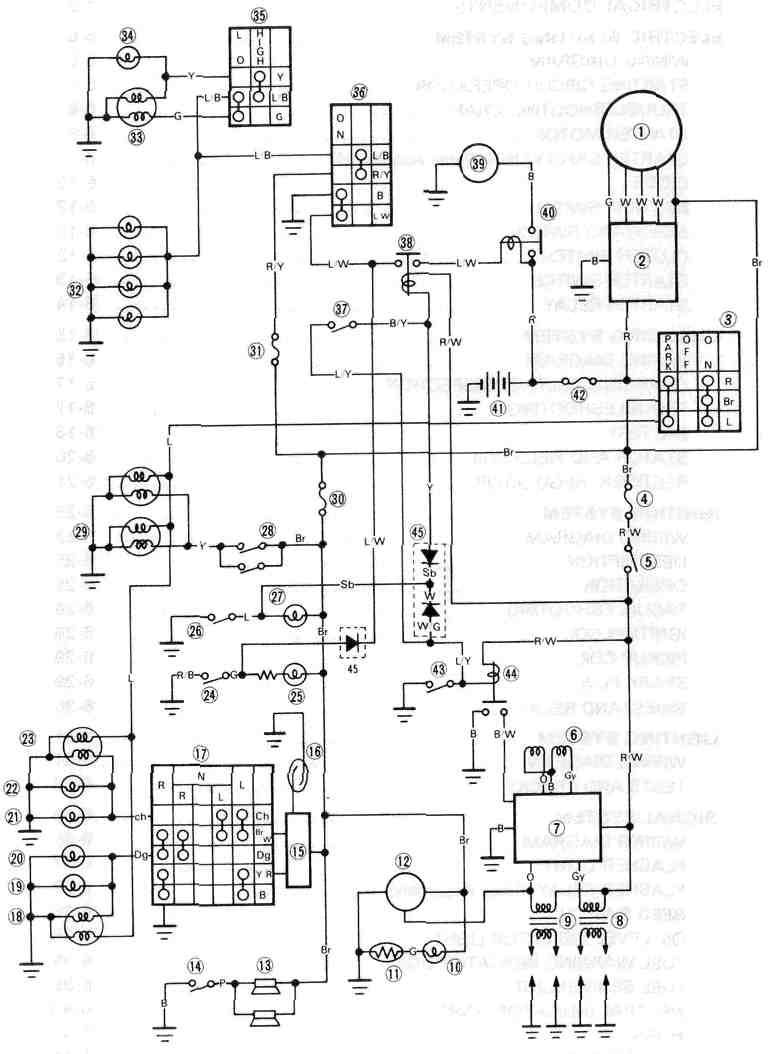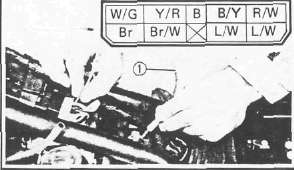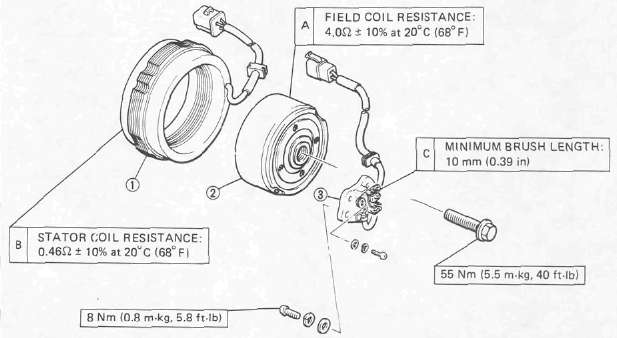XJ700N & XJ700NC Service Manual
XJ700N & XJ700NC Service ManualTABLE OF CONTENTS:
Chapter 1, INTRODUCTION
Chapter 1, INTRODUCTION
YAMAHA XJ700N/NC
GENERAL INFORMATION
MOTORCYCLE IDENTIFICATION
VEHICLE IDENTIFICATION NUMBER
The vehicle identification number (1) is stamped into the right side of the steering head pipe.
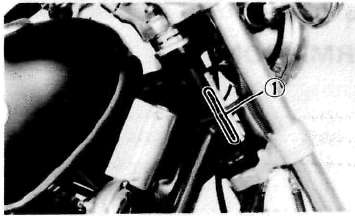
NOTE:
The vehicle identification number is used to identify your motorcycle and may be used to register your motorcycle with the licensing authority in your province or state.
Vehicle Identification Number:
XJ700N (Except for California): JYA1FG00*EA000101
XJ700NC (For California): JYA1JJ00*EA000101
ENGINE SERIAL NUMBER
The engine serial number (1) is stamped into the elevated part of the left rear section of the engine.
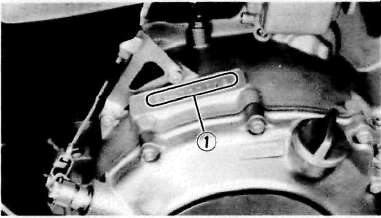
NOTE:
The first three digits of these numbers are for model identifications; the remaining digits are the unit production number.
Starting Serial Number: XJ700N (Except for California)
............... 1FJ-000101
XJ700NC (For California)
............... 1JJ-000101
NOTE:
Designs and specifications are subject to change without notice.
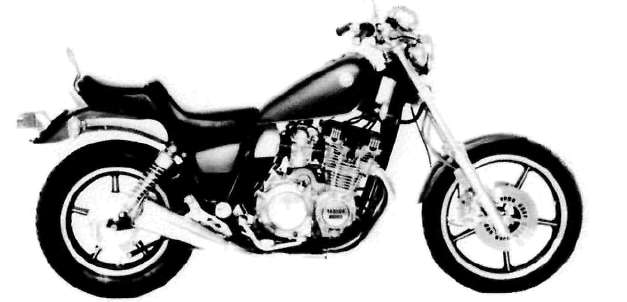
IMPORTANT INFORMATION
ALL REPLACEMENT PARTS
1. We recommend to use Yamaha genuine parts for all replacements. Use oil and/or grease recommended by Yamaha for assembly and adjustment.
GASKETS, OIL SEALS, AND O-RINGS
1. All gaskets, seals, and O-rings should be replaced when an engine is overhauled. All gasket surfaces, oil seal lips, and 0-rings must be cleaned.
2. Properly oil all mating parts and bearings during reassembly. Apply grease to the oil seal lips.
LOCK WASHERS/PLATES AND COTTER PINS
1. All lock washers/plates (f, and cotter pins must be replaced when they are removed. Lock tab(s) should be bent along the bolt or nut flat(s) after the bolt or nut has been properly tightened.
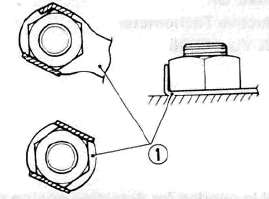
BEARINGS AND OIL SEALS
1. Install the bearing(s) (1) and oil seal(s) (2) with their manufacturer's marks or numbers facing outward. (In other words, the stamped letters must be on the side exposed to view.) When installing oil seal(s), apply a light coating of light-weight lithium base grease to the seal lip(s). Oil the bearings liberally when installing.
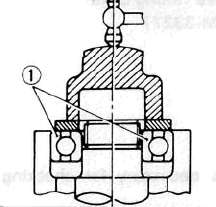
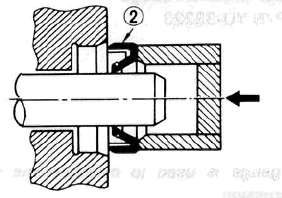
Do not use compressed air to spin the bearings dry. This causes damage to the bearing surfaces.
CIRCLIPS
1. All circlips should be inspected carefully before reassembly. Always replace piston pin clips after one use. Replace distorted circlips. When installing a circlip (1), make sure that the sharp-edged corner (2) is positioned opposite to the thrust (3) it receives. See the sectional view. (4) Shaft
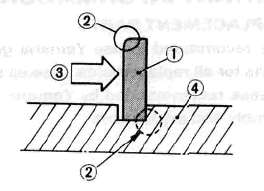
SPECIAL TOOLS
The proper special tools are necessary for complete and accurate tune-up and assembly. Using the correct special tool will help prevent damage caused by the use of improper tools or improvised techniques.
FOR TUNE UP
1. Inductive Tachometer P/N YU-08036
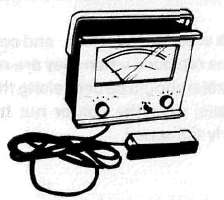
This tool is needed for detecting engine rpm.
2. Inductive Timing Light P/N YM-33277
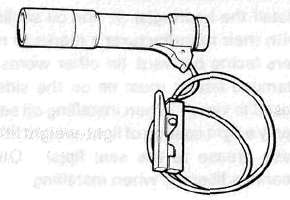
This tool is necessary for checking ignition timing.
3. Compression Gauge P/N YU-33223
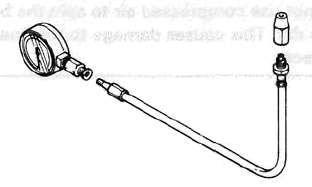
This gauge is used to measure the engine compression.
4. Y.I.CS. ShutoffTool P/N. YM-08025
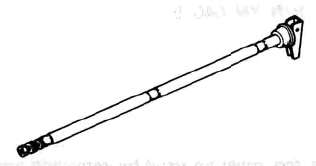
This tool is needed to measure the carburetor fuel level.
5. Vacuum gauge P/N, YU-08030
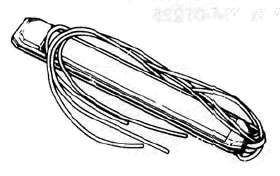
This gauge is needed for carburetor synchronization.
6. Fuel level gauge P/N. YM-01312
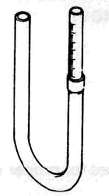
This tool is needed to measure the carburetor fuel level.
FOR ENGINE SERVICE
1. Tappet adjusting tool P/N. YM-01245
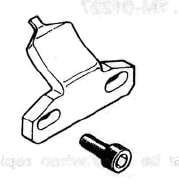
This tool is necessary to replace valve adjusting pads.
2. Universal Clutch Holder P/N.YM-91042
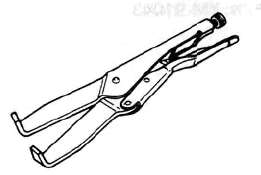
This tool is used to hold the clutch when removing or installing the clutch boss lock nut.
3. Valve spring compressor P/N. YM-04019
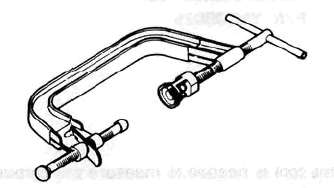
This tool must be used for removing and installing the valve assemblies.
4. Valve guide remover P/N. YM-01225
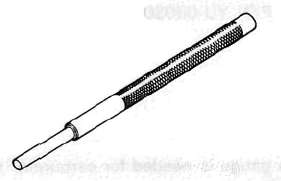
This must be used to remove the valve guides.
5. Valve guide installer P/N. YM-04017
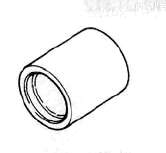
This tool is needed for proper installation of the valve guides.
6. Valve guide reamer P/N. YM-01227
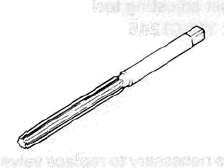
This must be used when replacing the valve guide.
7. Valve seat cutter P/N. YM-91043
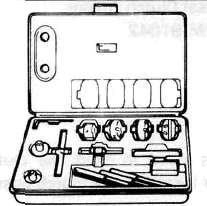
This tool is needed to re-surface the valve seat.
8. Rotor holding tool P/N. YM-04043
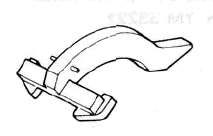
This tool is used to hold the A.C. Generator rotor during removal and installation.
9. Rotor puller P/N. YM-01080
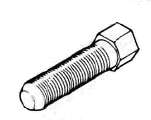
This tool is needed to remove the A.C. Generator.
10. Rotor puller attachment P/N. YM-04052
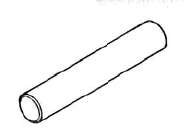
This tool is needed when removing the A.C. Generator rotor together with the rotor puller.
11. Piston ring compressor P/N. YM-04044
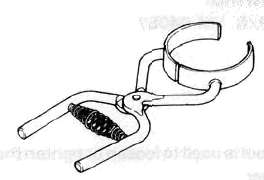
This is used to compress piston rings when installing the cylinder.
12. Piston base P/N. YM-01067
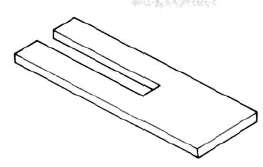
Use 4 of these to hold the pistons during cylinder installation.
FOR SHAFT DRIVE SERVICE
1. Middle drive pinion holder P/N. YM-33222
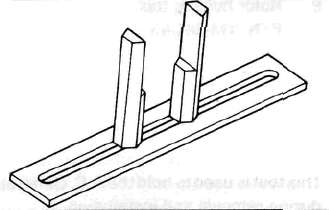
This tool is needed when measuring gear lash.
2. Dial Gauge P/N. YU-03097
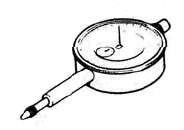
This gauge is used to measure gear lash.
3. Damper Spring Compressor P/N. YM-33286
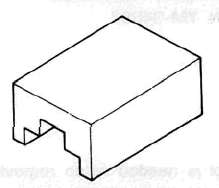
This tool is needed to disassemble and reassemble the middle gear damper.
4. Middle-Drive-Shaft-Bearing-Retainer Wrench P/N. YM-04057
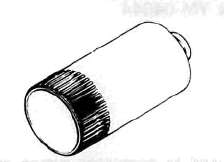
This tool is used to loosen or tighten the bearing retainer.
5. Final Gear Holding Tool P/N. YM-01254
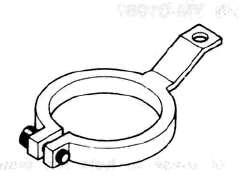
This tool is needed when measuring gear lash.
6. Final-Drive Gear Lash Measurement Tool P/N. YM-01230
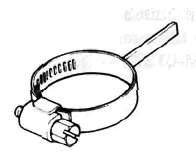
This tool is used to measure gear lash.
7. Middle and Final Gear Holding Tool P/N.YM-01229
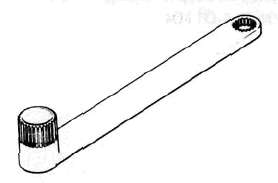
This tool is used when measuring gear lash.
8. Final Drive Shaft Bearing Retainer Wrench P/N. YM-40450
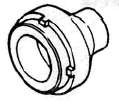
This tool is used to remove and install the bearing retainer.
FOR CHASSIS SERVICE
1. T-Handle P/N. YM-01326— (1) Fork Damper Rod Holder P/N. YM-33298—(2)
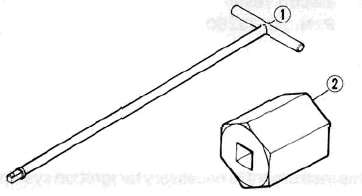
These tools are used to loosen and tighten the front fork cylinder holding bolt.
2. Ring Nut Wrench P/N. YU-01268 — (1) YU-33975 — (2)
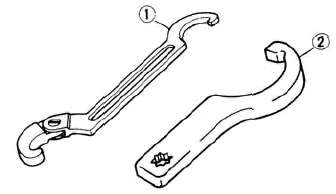
These tools are used to loosen and tighten the steering ring nut.
3. Front Fork Seal Driver (weight) P/N. YM-33963 — (1) Adapter (38 mm) P/N. YM-01372 —(2)
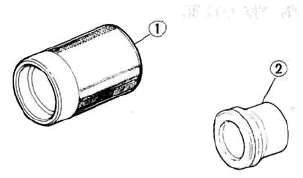
These tools are used when installing the fork seat.
4. Front Fork Cap Socket (17 mm) P/N. YM-01104
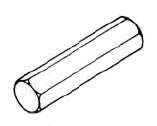
This tool is used when removing the cap bolt.
FOR ELECTRICAL COMPONENTS
1. Pocket Tester P/N.YU-03112
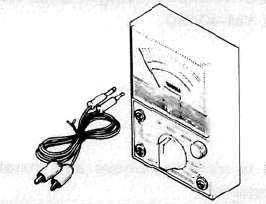
This instrument is invaluable for electrical system inspection and adjustment.
2. Electro Tester P/N.YU-33260
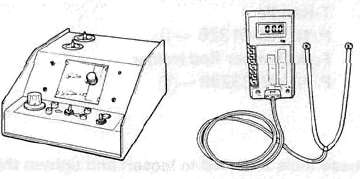
This instrument is necessary for ignition system inspection.
Chapter 2, Periodic Maintenance, Inspections and Adjustments
Chapter 2, Periodic Maintenance, Inspections and AdjustmentsINTRODUCTION
This chapter includes all information necessary to perform recommended inspections and adjustments. These preventive maintenance procedures, if followed, will ensure more reliable vehicle operation and a longer service life. The need for costly overhaul work will be greatly reduced. This information applies to vehicles already in service as well as new vehicles that are being prepared for sale. All service technicians should be familiar with this entire chapter.
Electrical Maintenance
Electrical MaintenanceBATTERY
1. Disconnect:
• Negative lead (1)
• Positive lead (2)
• Breather hose (3)
2. Pull:
• Battery

3. Check:
• Fluid level
Incorrect — Refill.
Fluid level should be between upper (1) and lower (2) level marks.

Refill with distilled water only; tap water contains minerals harmful to a battery.
2. Connect:
• Breather hose
Be sure the hose is properly attached and routed.
3. Inspect:
• Breather hose Obstruction — Remove. Damage — Replace.

HOW TO ROUTE BATTERY BREATHER PIPE.
CAUTION:
Always charge a new battery before using it to ensure maximum performance.
Charging Current: 1.4 amps/10 hrs
Specific Gravity: 1.280 at 20°C(68°F)
Battery electrolyte is dangerous; it contains sulfuric acid and therefore is poisonous and highly caustic. Always follow these preventive measure:
• Avoid bodily contact with electrolyte as it can cause severe burns or permanent eye injury.
• Wear protective eye gear when handling or working near batteries.
Antidote (EXTERNAL):
• SKIN — Flush with water.
• EYES — Flush with water for 15 minutes and get immediate medical attention.
Antidote (INTERNAL):
• Drink large quantities of water or milk follow with milk of magnesia) beaten egg, or vegetable oil. Get immediate medical attention.
Batteries also generate explosive hydrogen gas, therefore, you should always follow these preventive measures:
• Charge batteries in a well-ventilated area.
• Keep batteries away from fire, sparks, or open flames (e.g., welding equipment, lighted cigarettes, etc.)
• DO NOT SMOKE when charging or handling batteries.
KEEP BATTERIES AND ELECTROLYTE OUT OF REACH OF CHILDREN.
HEADLIGHT
Headlight Bulb Replacement
1. Remove:
• Securing screws (1) (from light unit assembly/headlight body.)
2. Disconnect:
• Lead wire

3. Remove:
• Light unit assembly
4. Rotate:
• Bulb holder (1) Turn it counterclockwise.
5. Remove:
• Defective bulb
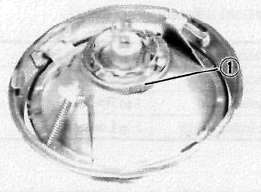
6. Install:
• Bulb (New)
Secure with bulb holder.
• Avoid touching glass part of bulb.
• Keep the bulb free from oil otherwise, transparency of glass, bulb life, and illumi-nous flux will be adversely affected.
• If oil gets on bulb, clean it with a cloth moistened thoroughly with alcohol or lacquer thinner.

Do not touch the headlight bulb when it is on, as the bulb generates enormous heat; keep flammable objects away.
7. Install:
• Light unit assembly (to headlight body.)
Headlight Beam Adjustment
Horizontal adjustment:
1. Rotate:
• Horizontal adjusting screw (1)

|
Horizontal Adjustment of Headlight Beam |
|
|
Adjusting screw |
Beam direction |
|
Turn clockwise |
- to Right |
|
Turn counterclockwise |
- to Left |
Vertical adjustment:
1. Rotate:
• Vertical adjusting screw (2)
|
Vertical Adjustment of Headlight Beam |
|
|
Adjusting screw |
Beam direction |
|
Turn clockwise |
1 to Raise |
|
Turn counterclockwise |
1 to Lower |
FUSE
The fuse box is under the indicator light panel. The main fuse is under the seat.
(1) Main fuse
(2) Other fuse block
(3) Spare fuses


Blown fuse replacement steps.
• Turn off ignition and the circuit.
• Install a new fuse of proper amperage.
• Turn on switches to verify operation of electrical device.
• If fuse blows immediately again, check circuit in question.
Do not use fuses of higher amperage rating than recommended. Extensive electrical system damage and fire could result from substitution of a fuse of improper amperage.
Maintenance Intervals Charts
Maintenance Intervals ChartsProper periodic maintenance is important. Especially important are the maintenance services related to emissions control. These controls not only function to ensure cleaner air but are also vital to proper engine operation and maximum performance. In the following maintenance tables, the services related to emissions control are grouped separately.
PERIODIC MAINTENANCE EMISSION CONTROL SYSTEM
|
ITEM |
REMARKS |
INITIAL ODOMETER READING |
|||||
|
1.000 km (600 mi) or 1 month |
*#1 7.000 km (4.400 mi) or 7 months |
"2 13,000 km (8,200 mi) or 13 months |
19,000 km {12.000 mi) or 19 months |
25,000 km [15,800 mi) or 25 months |
31,000 km <19.600m or 31 months |
||
|
Valve clearance |
Check and adjust valve clearance when engine is cold. |
o |
|||||
|
Spark plug |
Check condition. Adjust gap and clean. Replace at 13,000 km (or 13 months) and thereafter every 12,000 km (or 12 months). |
o |
Replace |
o |
Replace |
o |
|
|
Crankcase ventilation system |
Check ventilation hose for cracks or damage. Replace if necessary. |
o |
o |
o |
|||
|
Fuel line |
Check fuel hose and vacuum pipe for cracks or damage. Replace if necessary. |
|
o |
o |
o |
o |
|
|
Exhaust system |
Check for leakage. Retighten if necessary. Replace gasket(s) if necessary. |
o |
o |
o |
o |
o |
|
|
Idle speed |
Check and adjust engine idle speed. Adjust cable free play. |
o |
o |
o |
o |
o |
|
|
Carburetor synchronization |
Adjust synchronization of carburetors. |
o |
o |
o |
o |
o |
o |
|
•It is recommended that these items be serviced by a Yamaha dealer or other qualified mechanic. |
NOTE:
For farther odometer reading, repeat the above maintenance at the period establish; **1: Every 6.000 km (3,800 mi) "2. Every 12,000 km (7,600 mi) intervals.
GENERAL MAINTENANCE/LUBRICATION
|
No. |
ITEM |
REMARKS |
TYPE |
INITIAL ODOMETER READINGS |
|||||
|
1,000 km (600 mi) or 1 month |
**1 7,000 km (4,400 mi) or 7 months |
**2 13,000 km (8,200 mi) or 13 months |
**3 19,000 km (12,000 mi) or 19 months |
**4 25,000 km (15.800 mi) or 25 months |
31,000 km (19,600 mi or 31 months |
||||
|
1 |
Engine oil |
Warm-up engine before draining. |
See page 12 |
o |
o |
o |
o |
o |
o |
|
2 |
Oil filter |
Replace. |
— |
o |
o |
o |
|||
|
3 |
Air filter |
Clean with compressed air. Replace if necessary. |
— |
o |
o |
o |
o |
o |
|
|
4 |
Brake system |
Adjust free play. Replace pads if necessary. (Front) Replace shoes if necessary (Rear) |
o |
o |
o |
o |
o |
o |
|
|
5 |
Clutch |
Adjust free play. |
— |
o |
o |
o |
o |
o |
o |
|
6 |
Final gear oil |
Check oil level and leakage. Replace every 24,000 km (15,000 mi) or 24 months. |
SAE80 API GL-4 hypoid gear oil |
Replace |
o |
Replace |
|||
|
7 |
Control and meter cable |
Apply chain lube thoroughly. |
Yamaha chain and cable lube or SAE 10W30 motor oil. |
° |
o |
o |
o |
o |
o |
|
8 |
Rear arm pivot shaft |
Check bearings assembly for looseness. Moderately repack every 24,000 km (15,200 mi) |
Medium weight wheel bearing grease |
o |
|||||
|
9 |
Brake/ Clutch ever pivot shaft. |
Apply chain lube lightly. |
Yamaha chain and cable lube or SAE 10W30 motor oil. |
o |
o |
o |
o |
o |
|
|
10 |
Brake pedal and change pedal shaft |
Lubricate Apply chain lube lightly. |
Yamaha chain and cable lube or SAE 10W30 motor oil. |
o |
o |
o |
o |
o |
|
|
11 |
Center/Side stant pivots |
Check operation and lubricate. Apply chain lube lightly. |
Yamaha chain and cable lube or SAE 10W30 motor oil. |
o |
o |
o |
o |
o |
|
|
12 |
Front fork oil |
Check operation and leakage. |
— |
o |
o |
o |
o |
o |
|
|
13 |
Steering bearings |
Check bearings assembly for looseness. Moderately repack every 24,000 km (15,000 mi) |
Medium weight wheel bearing grease |
O |
o |
o |
o |
o |
|
|
14 |
Wheel bearings |
Check bearings for smooth rotation. |
— |
o |
o |
O |
o |
o |
|
|
15 |
Battery |
Check specific gravity and breather pipe for proper operation. |
— |
o |
o |
o |
o |
o |
|
|
16 |
A.C. Generator |
Replace generator brushes. |
o |
o |
|||||
|
17 |
Sidestand switch |
Check and clean or replace if necessary. |
O |
o |
o |
o |
o |
o |
|
■ it is recommended that these items be serviced by a Yamaha Dealer or other qualified mechanic.
NOTE:
For greater odometer readings repeat the above maintenance at the period established, IE: **1: Every 6,000 km (3,800 mi), **2: Every 12,000 km (7,600 mi), **3: Every 18,000 km (11,400 mi), **4: Every, 24,000 km (15,200 mi) intervals.
Engine
EngineContents of Engine Maintenance:
Valve Adjustments
Valve AdjustmentsVALVE CLEARANCE ADJUSTMENT
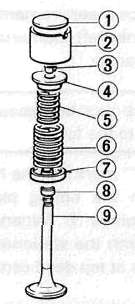
(1)Pad (2) Valve lifter (3) Valve retainer (4)Spring seat (5)inner spring (6) Outer spring (7) Spring seat (8) Oil seal (9) Valve
|
A |
VALVE CLEARANCE (COLD): |
|
|
B |
Intake: |
0.11 -0.15 mm (0.0043-0.0059 in) |
|
C |
Exhaust: |
0.16-0.20 mm (0.0063-0.0079 in) |
Removal
1. Remove:
• Seat
• Fuel tank
• Ignition coil covers (1)
• Horns with stay (2)
2. Disconnect:
• Spark plug caps
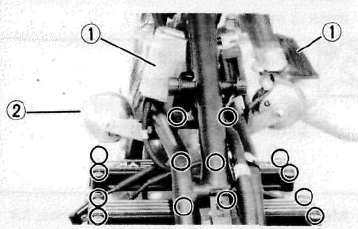
3. Remove:
• Spark plugs
• Cylinder head cover
4. Remove:
• Emblem plate (Left)
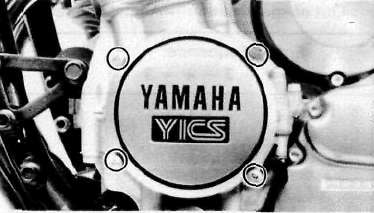
Inspection and Adjustment
1. Measure:
• Valve clearance
NOTE:
Be sure piston is at Top Dead Center (TDC) on compression stroke when measuring clearance.
Valve clearance measurement steps:
• Turn the crankshaft counterclockwise with a 19 mm spanner (1) .
NOTE:
Valve clearance must be measured when the engine is cool to the touch.
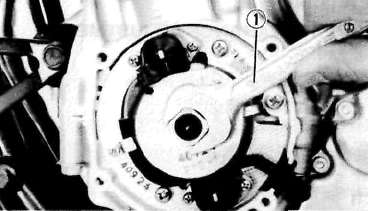
• Align the "T" mark (for the No. 1 or No. 4 cylinder) on the timing plate with the stationary pointer (2). When the "T" mark is aligned with the stationary pointer (2), the piston is at top dead center TDC.
(3) Firing range for No. 1 cylinder
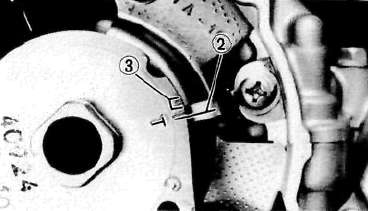
• Measure the valve clearance using a Feeler Gauge.
• Record the measured amount if the clearance is incorrect.
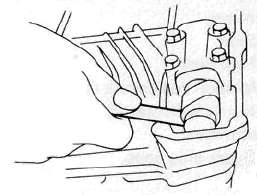
Intake Valve (cold): 0.11 —0.15 mm (0.0043 ~ 0.0059 in)
Exhaust Valve (cold): 0.16 —0.20 mm (0.0063 ~ 0.0079 in)
• Measure valve clearance, in sequence, for Nos. 2, 4, and No. 3 cylinders. Out of specification — Adjust clearance.
Firing Sequence: 1-2-4-3
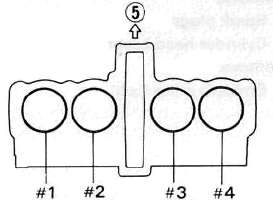
(5) Front
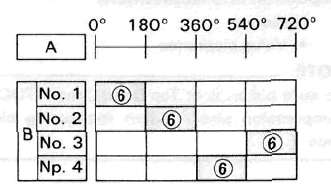
A Crankshaft counterclockwise turning angle.
B Cylinder
(6) Combustion
2. Adjust:
• Valve clearance
Valve clearance adjustment steps:
• Position the valve lifter slots (intake and exhaust) opposite each other.
• Turn the camshaft until the lobe fully depresses the valve lifter and opens the valve.
• Attach the Tappet Adjusting Tool (1) (YM-01245) onto the cylinder head.
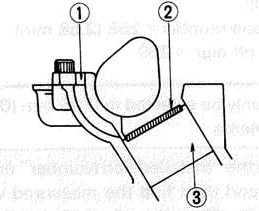
NOTE:
Make sure that the tool contacts the lifter (3) only, and not the pad (2).
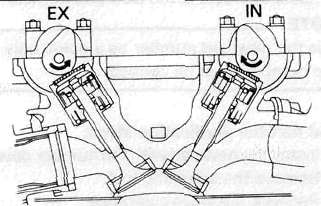
• Carefully rotate the camshaft so that the pads can be removed. To avoid cam touching the adjusting tool, turn cams as shown.
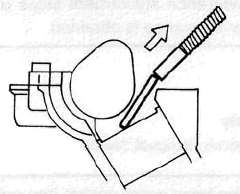
Intake: Carefully rotate CLOCKWISE. Exhaust: Carefully rotate COUNTERCLOCKWISE.
• Remove the pads (2) from the lifters. Use a small screwdriver and a magnetic rod for removal.Note pad numbers.
• Select the proper valve adjusting pad from the chart below:
|
Pad range |
Pad Availability: 25 increments |
|
No. 200 - 2.00mm (0.079 in) |
Pad stepped in 0.05 mm (0.002 in) increments |
NOTE:
Thickness of each pad is marked on the pad face that contacts the valve lifter (not the cam).
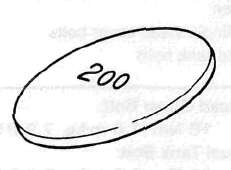
• Round off the hundredths digit of the original pad number to the nearest 0.05 mm increment.
|
Hundredths digit |
Rounded valve |
|
0 or 2 |
0 |
|
5 |
NOT ROUNDED OFF |
|
8 |
10 |
EXAMPLE:
Original pad number = 258 (2.58 mm)
Rounded off digit = 260
NOTE:
Pad can only be selected in 0.05 mm (0.002 in) increments.
Determine the required replacement pad thickness by one of the two following methods:
Shim calculation method:
Since all shims come in .05mm (.002") increments, you can quickly calculate the required size without a chart.
If the measured clearance is within 0.05mm (0.002") of the required clearance, then no change is needed.
If the measured clearance greater than 0.05mm (0.002") but 0.10mm (0.004") or less different than the required clearance then the next size shim is required.
If the measured clearance greater than 0.10mm (0.004") but 0.15mm (0.006") or less different than the required clearance then the next size shim is required.
Clearances that are too small require thinner shims. Clearances that are too large require thicker shims.
Example: Required exhaust valve clearance is 0.16~0.20mm. Measured clearance is 0.12mm (gap too small). Installed shim is Y270. Required shim is one size thinner: Y265.
Shim Chart Lookup Method:
• Locate the "Installed Pad Number" on the chart, and then find the measured valve clearance. The point where these coordinates intersect is the new pad number.
NOTE:
Use the new pad number as a guide only as the number must be verified.
Pad number verification steps:
• Install the new pad with the number down.
• Remove the adjusting tool.
• Recheck the valve clearance.
• If the clearance is incorrect, repeat all of the clearance adjustment steps until the proper clearance is obtained.
Assembly
1. Reverse removal steps.
NOTE:
Inspect the head cover gasket and replace it if damaged.
2. Tighten:
• Cylinder head cover bolts
• Fuel tank bolts
Head Cover Bolt:
10Nm(1.0mkg, 7.2 ftlb)
Fuel Tank Bolt:
10Nm(1.0rrvkg, 7.2 ftlb)
INTAKE
|
MEASURED |
INSTALLED PAD NUMBER |
||||||||||||||||||||||||
|
200 |
205 |
210 |
215 |
220 |
225 |
230 |
235 |
240 |
245 |
250 |
255 |
260 |
265 |
270 |
275 |
280 |
285 |
290 |
295 |
300 |
305 |
310 |
315 |
320 |
|
|
0.00 - 0 05 |
200 |
205 |
210 |
215 |
220 |
225 |
230 |
235 |
240 |
245 |
250 |
255 |
260 |
265 |
270 |
275 |
280 |
285 |
290 |
295 |
300 |
305 |
310 |
||
|
0.06 - 0 10 |
200 |
205 |
210 |
215 |
220 |
225 |
230 |
235 |
240 |
240 |
260 |
255 |
260 |
265 |
270 |
275 |
280 |
285 |
290 |
295 |
300 |
305 |
310 |
315 |
|
|
0 11 - 0.15 |
|||||||||||||||||||||||||
|
0 16 - 0.20 |
205 |
210 |
215 |
220 |
225 |
230 |
235 |
240 |
245 |
250 |
255 |
260 |
265 |
270 |
275 |
280 |
285 |
290 |
295 |
300 |
305 |
310 |
315 |
320 |
|
|
0.21 - 0.25 |
210 |
215 |
220 |
225 |
230 |
235 |
240 |
245 |
250 |
255 |
200 |
265 |
270 |
275 |
280 |
285 |
290 |
295 |
300 |
305 |
310 |
315 |
320 |
||
|
0 26 - 0.30 |
215 |
220 |
225 |
230 |
235 |
240 |
245 |
250 |
255 |
260 |
265 |
270 |
275 |
280 |
285 |
290 |
295 |
300 |
305 |
310 |
315 |
320 |
|||
|
0.31 - 0.35 |
220 |
22ft |
230 |
23ft |
240 |
245 |
250 |
255 |
260 |
265 |
270 |
275 |
280 |
285 |
290 |
295 |
300 |
305 |
310 |
315 |
320 |
||||
|
0 36 - 0 40 |
225 |
230 |
235 |
240 |
245 |
250 |
255 |
260 |
265 |
270 |
275 |
280 |
285 |
290 |
295 |
300 |
305 |
310 |
315 |
320 |
|||||
|
0 41 - 0 45 |
230 |
235 |
240 |
245 |
250 |
255 |
260 |
265 |
270 |
275 |
280 |
285 |
290 |
295 |
300 |
305 |
310 |
315 |
320 |
||||||
|
0.46 - 0 50 |
235 |
240 |
245 |
250 |
255 |
260 |
265 |
270 |
275 |
280 |
285 |
290 |
295 |
300 |
305 |
310 |
315 |
320 |
|||||||
|
0 51 - 0.55 |
240 |
245 |
250 |
255 |
260 |
265 |
270 |
275 |
280 |
285 |
290 |
295 |
300 |
305 |
310 |
315 |
320 |
||||||||
|
0 56 - 0 60 |
245 |
250 |
255 |
260 |
265 |
270 |
275 |
280 |
285 |
290 |
295 |
300 |
305 |
310 |
315 |
320 |
|||||||||
|
0.61 - 0.65 |
250 |
255 |
260 |
265 |
270 |
275 |
280 |
285 |
290 |
295 |
300 |
305 |
310 |
315 |
320 |
||||||||||
|
0 66 - 0.70 |
255 |
260 |
265 |
270 |
275 |
280 |
285 |
290 |
295 |
300 |
305 |
310 |
315 |
320 |
|||||||||||
|
0.71 - 0.75 |
260 |
265 |
270 |
275 |
280 |
285 |
290 |
295 |
300 |
305 |
310 |
315 |
320 |
||||||||||||
|
0.76 - 0 80 |
265 |
270 |
275 |
280 |
285 |
290 |
295 |
300 |
305 |
310 |
315 |
320 |
|
||||||||||||
|
0.81 - 0.85 |
270 |
275 |
280 |
285 |
290 |
295 |
300 |
305 |
310 |
315 |
320 |
||||||||||||||
|
0 86 - 0 90 |
275 |
280 |
285 |
290 |
295 |
300 |
305 |
310 |
315 |
320 |
VALVE CLEARANCE (cold): |
||||||||||||||
|
0.91 - 0.95 |
280 |
285 |
290 |
295 |
300 |
305 |
310 |
315 |
320 |
||||||||||||||||
|
0.96 - 1 00 |
285 |
290 |
295 |
300 |
305 |
310 |
315 |
320 |
0.11 to 0.15 mm (0.004 — 0.006 in) |
||||||||||||||||
|
1.01 - 1.05 |
290 |
295 |
300 |
305 |
310 |
315 |
320 |
||||||||||||||||||
|
1.06 - 1.10 |
295 |
300 |
305 |
310 |
315 |
320 |
Measured clearance is 0.32 mm (0.013 in) |
||||||||||||||||||
|
1.11 - 1.15 |
300 |
305 |
310 |
315 |
320 |
||||||||||||||||||||
|
1.16 - 1.20 |
305 |
310 |
315 |
320 |
Pad number : (example) |
||||||||||||||||||||
|
1 21 - 1 25 |
310 |
315 |
320 |
||||||||||||||||||||||
|
1 26 - 1 30 |
315 |
320 |
Pad No. 255 = 2.55 mm (0.100 in) |
||||||||||||||||||||||
|
1.31 - 1 35 |
320 |
||||||||||||||||||||||||
EXHAUST
|
MEASURED |
INSTALLED PAD NUMBER |
||||||||||||||||||||||||
|
200 |
205 |
210 |
215 |
220 |
225 |
230 |
235 |
240 |
245 |
250 |
255 |
260 |
265 |
270 |
275 |
280 |
285 |
290 |
295 |
300 |
305 |
310 |
315 |
320 |
|
| 0.00 - 0 05 |
200 |
205 |
210 |
215 |
220 |
225 |
230 |
235 |
240 |
245 |
250 |
255 |
260 |
265 |
270 |
275 |
280 |
285 |
290 |
295 |
300 |
305 |
|||
|
0.06 - 0 10 |
200 |
205 |
210 |
216 |
220 |
225 |
230 |
235 |
240 |
245 |
250 |
255 |
260 |
265 |
270 |
275 |
280 |
285 |
290 |
295 |
300 |
305 |
310 |
||
|
0 11 - 0.15 |
200 |
205 |
210 |
215 |
220 |
225 |
230 |
235 |
240 |
245 |
250 |
255 |
260 |
265 |
270 |
275 |
280 |
285 |
290 |
295 |
300 |
305 |
310 |
315 |
|
|
0 16 - 0.20 |
|||||||||||||||||||||||||
|
0.21 - 0.25 |
205 |
210 |
215 |
220 |
225 |
230 |
235 |
240 |
246 |
250 |
255 |
260 |
265 |
270 |
275 |
280 |
285 |
290 |
295 |
300 |
305 |
310 |
315 |
320 |
|
|
0 26 - 0.30 |
210 |
215 |
220 |
225 |
230 |
235 |
240 |
245 |
250 |
255 |
260 |
265 |
270 |
275 |
280 |
285 |
290 |
295 |
300 |
305 |
310 |
315 |
320 |
||
|
0.31 - 0.35 |
216 |
220 |
225 |
230 |
235 |
240 |
24ft |
260 |
255 |
2ft0 |
20ft |
270 |
275 |
280 |
285 |
290 |
295 |
300 |
305 |
310 |
315 |
320 |
|||
|
0 36 - 0 40 |
220 |
225 |
230 |
235 |
240 |
245 |
250 |
255 |
260 |
265 |
270 |
275 |
280 |
285 |
290 |
295 |
300 |
305 |
310 |
315 |
320 |
||||
|
0 41 - 0 45 |
225 |
230 |
235 |
240 |
245 |
250 |
255 |
260 |
265 |
^70 |
2'5 |
280 |
285 |
290 |
295 |
300 |
305 |
310 |
315 |
320 |
|||||
|
0.46 - 0 50 |
230 |
235 |
240 |
245 |
250 |
255 |
260 |
265 |
270 |
275 |
280 |
285 |
290 |
295 |
300 |
305 |
310 |
315 |
320 |
|
|||||
|
0 51 - 0.55 |
235 |
240 |
245 |
250 |
255 |
260 |
265 |
270 |
275 |
280 |
285 |
290 |
295 |
300 |
305 |
310 |
315 |
320 |
|||||||
|
0 56 - 0 60 |
240 |
245 |
250 |
255 |
260 |
265 |
270 |
275 |
280 |
285 |
290 |
295 |
300 |
305 |
310 |
315 |
320 |
||||||||
|
0.61 - 0.65 |
245 |
250 |
265 |
260 |
265 |
270 |
275 |
280 |
285 |
290 |
295 |
300 |
305 |
310 |
315 |
320 |
|||||||||
|
0 66 - 0.70 |
250 |
255 |
260 |
265 |
270 |
275 |
280 |
285 |
290 |
295 |
300 |
305 |
310 |
315 |
320 |
||||||||||
|
0.71 - 0.75 |
255 |
260 |
265 |
270 |
275 |
280 |
285 |
290 |
295 |
300 |
305 |
310 |
315 |
320 |
|||||||||||
|
0.76 - 0 80 |
260 |
265 |
270 |
275 |
280 |
285 |
290 |
295 |
300 |
305 |
310 |
315 |
320 |
||||||||||||
|
0.81 - 0.85 |
265 |
2 70 |
275 |
280 |
285 |
290 |
295 |
300 |
306 |
310 |
315 |
320 |
|||||||||||||
|
0 86 - 0 90 |
270 |
275 |
280 |
285 |
290 |
295 |
300 |
305 |
310 |
316 |
320 |
VALVE CLEARANCE (cold): |
|||||||||||||
|
0.91 - 0.95 |
276 |
280 |
285 |
290 |
295 |
300 |
305 |
310 |
316 |
320 |
|||||||||||||||
|
0.96 - 1 00 |
280 |
285 |
290 |
295 |
300 |
305 |
310 |
315 |
320 |
0.16 - 0.20 mm (0.006 - 0.008 in) |
|||||||||||||||
|
1.01 - 1.05 |
285 |
290 |
295 |
300 |
305 |
310 |
315 |
320 |
|||||||||||||||||
|
1.06 - 1. 10 |
290 |
295 |
300 |
305 |
310 |
315 |
320 |
Measured clearance is 0.32 mm (0.013 in) |
|||||||||||||||||
|
1. 11 - 1. 15 |
295 |
300 |
305 |
310 |
315 |
320 |
|||||||||||||||||||
|
1. 16 - 1. 20 |
300 |
305 |
310 |
315 |
320 |
Pad number : (example) |
|||||||||||||||||||
|
1 21 - 1 25 |
305 |
310 |
315 |
320 |
|||||||||||||||||||||
|
1 26 - 1 30 |
310 |
315 |
320 |
Pad No. 255 = 2.55 mm (0.100 in) |
|||||||||||||||||||||
|
1.31 - 1 35 |
320 |
||||||||||||||||||||||||
Spark Plug, Emmissions, Exhaust and Carburetor
Spark Plug, Emmissions, Exhaust and Carburetor
SPARK PLUG
1. Remove:
• Spark plug(s)
2. Inspect:
• Electrode (1) Wear/Damage — Replace.
• Insulator color (2)
3. Measure:
• Plug gap (3)
Use a Wire Gauge or Feeler Gauge. Out of specification — Regap.
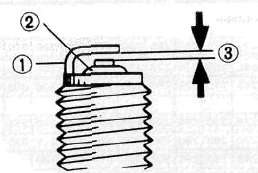
0.7 ~ 0.8 mm (0.028 - 0.31 in)
Clean the plug with a spark plug cleaner if necessary-
Standard Spark Plug: BP8 ES (NGK) W24EP-U (NIPPONDENSO)
Before installing a spark plug, clean the gasket surface and plug surface.
4. Tighten:
• Spark plug(s)
20 Nm (2.0 mkg, 14ftlb)
NOTE:
Finger-tighten the spark plug(s) before torquing to specification.
CANISTER (For California Only)
This model is equipped with a canister to prevent the discharging of fuel vapor into the atmosphere.
1. Inspect:
• Hoses (1) (2) (5) Cracks/Damage — Replace. Clog - Clean.
• Canister (4) Cracks/Damage — Replace.
3 Carburetor [B] From fuel tank [C] To atmosphere
A EMISSION HOSE ROUTING
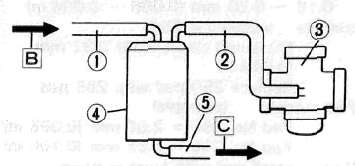
CRANKCASE VENTILATION SYSTEM
1. Inspect:
• Crankcase ventilation hose ® Cracks/Damage — Replace.
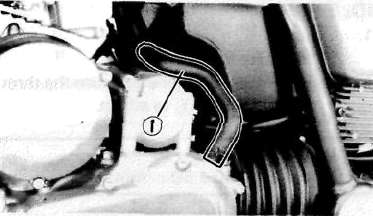
FUEL LINE
1. Inspect:
• Fuel hose (1)
• Vacuum hose (2) Cracks/Damage — Replace.
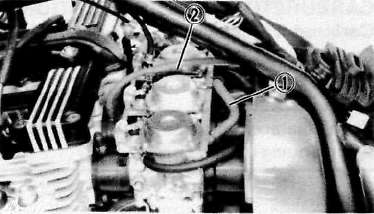
INTAKE MANIFOLD
1. Tighten:
• Carburetor clamps
• Carburetor joint bolts
2. Inspect:
• Carburetor joint
• Gaskets Cracks/Damage — Replace.
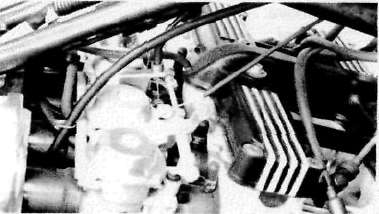
EXHAUST SYSTEM
1. Inspect:
• Exhaust pipe gasket(s) (1)
• Muffler clamp gasket(s) (2) Damage — Replace. Exhaust gas leakage — Repair.
2. Tighten:
• Exhaust pipe bolts
• Muffler bolts
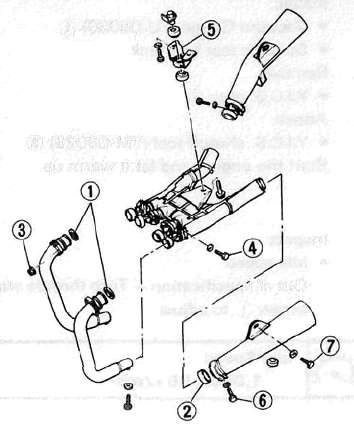
Exhaust Pipe Flange (3) :
10 Nm (1.0 m-kg, 7.2ft-lb)
Exhaust Pipe Clamp (4) :
20 Nm (2.0 m-kg, 14ftlb)
Muffler Bracket (5) :
25 Nm (2.5 m-kg, 18 ft-lb)
Exhaust Chamber Mount (7) :
20 Nm (2.0 m-kg, 14 ft-lb)
Muffler Clamp (6) :
20 Nm (2.0 m-kg, 1 4 ft-lb)
IDLE SPEED/CARBURETOR SYNCHRONIZATION
IDLE SPEED
1. Adjust
• Idle speed
Warm up the engine and turn the throttle stop screw (1) to adjust.
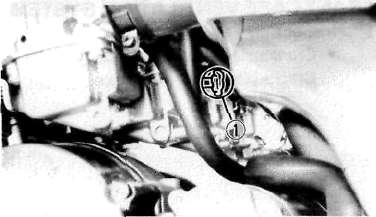
Idle Speed
1,050 + 50 r/min
Carburetor Adjustment.
Carburetors must be adjusted to open and close simultaneously.
NOTE:
Valve clearance must be set properly before synchronizing the carburetors.
1. Remove:
• Seat
• Fuel tank
2. Disconnect:
• Vacuum plugs (1)
• Vacuum hose (2)
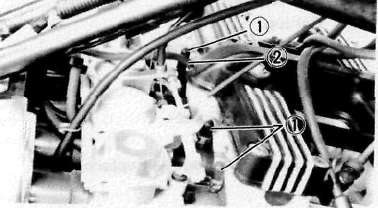
3. Install:
• Vacuum Gauge (YU-08030) (1)
• Suitable test fuel tank
4. Remove:
• Y.I.C.S. plug (2)
5. Attach:
• Y.I.C.S. shutoff tool (YM-08025) (3)
6. Start the engine and let it warm up.
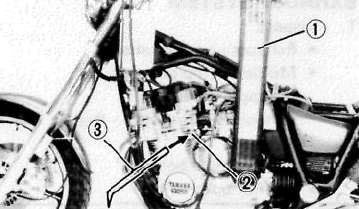
7. Inspect:
• Idle speed
Out of specification — Turn throttle stop screw (1) to adjust.
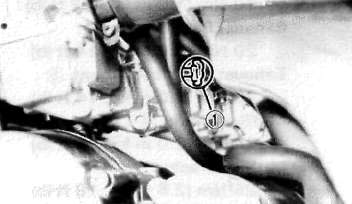
Idle Speed
1,050 ±50 r/min
8. Adjust:
• Carburetor synchronization
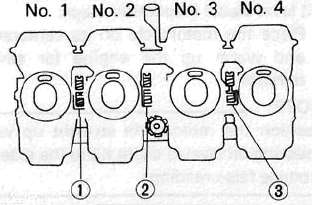
Carburetor synchronization adjustment steps:
• Synchronize the carburetor No. 1 to the carburetor No. 2 by turning the synchronizing screw (1) until the both gauge readings are the same.
• Rev. the engine for a fraction of a second, two or three times, and check the synchronization again.
Vacuum Pressure at Idle Speed:
23.99 kPa (180 mm Hg, 7.09 in Hg)
Vacuum Synchronous Difference:
0.67 kPa (5 mm Hg, 0.2 in Hg)
• Repeat the above steps to synchronize the carburetor No. 4 to the carburetor No. 3 by turning the synchronizing screw (3) until the both gauge readings are the same.
• Repeat the same steps to synchronize No. 3 carburetor to No. 1 carburetor, then turn synchronizing screw (2) until both gauge readings are the same.
Engine Oil
Engine Oil
At 5°C (40°F) or Higher:
SAE 20W40 Type SE Motor Oil
At 15°C (60°F) or Lower:
SAE 10W30 Type SE Motor Oil
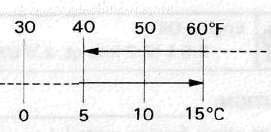
NOTE:
Recommended engine oil classification; API Service "SE", "SF" type or equivalent (e.g. "SF-SE", "SF-SE-CC", "SF-SE-SD" etc.)
Oil Level Measurement
1. Check
• Oil level
Oil level low — Add sufficient oil.
Oil level visual inspection steps:
• Place the motorcycle on its center stand and warm up the engine for several minutes.
NOTE:
Position the motorcycle straight up when checking oil level, a slight tilt to the side can produce false readings.
• Stop the engine and visually check the oil level through the level window (1).
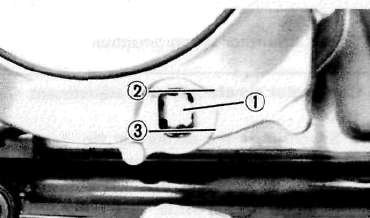
(2) Maximum (3) Minimum
Oil Change (Without filter)
1. Warm up the engine for several minutes, then place a receptacle under the engine.
2. Remove:
• Oil filler cap
3. Remove:
• Engine drain plug (1)
4. Tighten:
• Drain plug
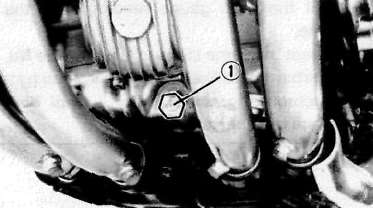
Engine Drain Plug:
43 Nm (4.3 m-kg, 31 ft-lb)
5. Fill:
• Crankcase
Engine Oil
2.5 L (2.2 imp qt, 2.6 US qt)
CAUTION:
Do not allow foreign material to enter the crankcase.
6. Install:
• Filler cap
Oil Change (With filter)
1. Warm up the engine and place a receptacle under the engine.
2. Remove:
• Oil filler cap
• Drain plug
Drain the engine oil.
3. Remove:
• Oil filter bolt (1)
• Filter cover (2)
4. Tighten:
• Drain plug
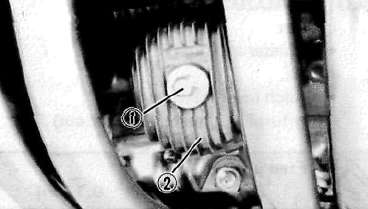
Engine Drain Plug:
43 Nm (4.3 m-kg, 31 ft-lb)
5. Install:
• Oil filter bolt (1)
• Spring (2)
• Washer (3)
• Oil filter (New) (4)
• O-ring (5)
• Oil filter assembly
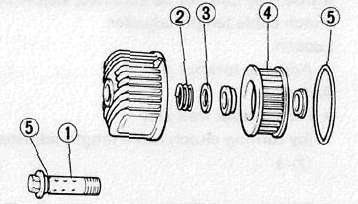
• Be sure the O-ring (5) is positioned properly.
• Fit the filter cover projection into the crank-case cover slot.
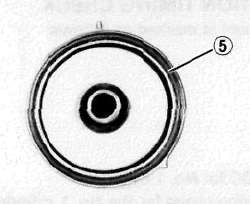
6. Tighten:
• Oil filter bolt
Oil Filter Bolt:
15 Nm (1.5 mkg, 11 ftlb)
7. Fill:
• Crankcase
Engine Oil:
2.8 L (2,5 imp qt, 3.0 US qt)
8. Install:
• Oil filler cap
9. Warm up the engine and check for oil leaks. Stop the engine instantly if leaking occurs.
Leaks — Check cause.
10. Check:
• Oil level
Level low — Add sufficient oil.
Clutch, Timing and Compression
Clutch, Timing and CompressionCLUTCH ADJUSTMENT
1. Loosen:
• Adjuster locknut (1)
2. Adjust:
• Clutch lever free play (3)
(by turning adjuster (2) in or out)
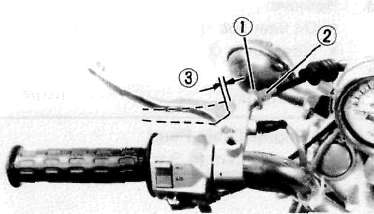
Free play:
2-3 mm (0.08 - 0.12 in)
If free play can not be adjusted, adjust by clutch cable length adjuster.
3. Loosen:
• Adjuster locknut (1)
4. Adjust:
• Clutch lever free play
(by turning clutch cable length adjuster (2) )
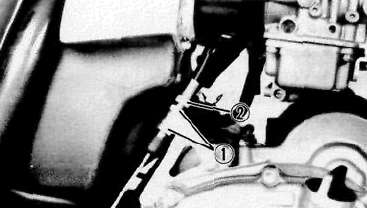
IGNITION TIMING CHECK
Flywheel is marked as follows:
(1) TDC for No. 1 cylinder
(2) Firing range for the No. 1 cylinder
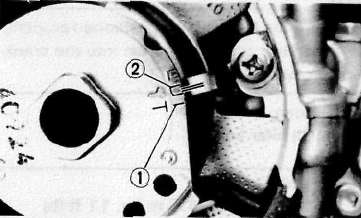
1. Check:
• Ignition timing
Ignition timing check steps:
• Remove the cover.
• Connect the Timing Light (YM-33277) i to No. 1 cylinder spark plug lead.
• Warm up the engine and let it idle at the specified idle speed of 1,050 ± 50 r/min.
• Visually check the stationary pointer in the timing window to verify it is within the required firing range indicated on the flywheel.
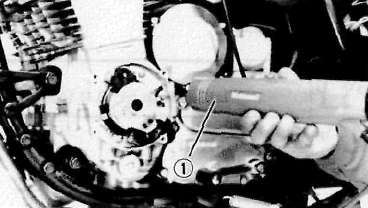
Incorrect firing — Check timing plate and/or pickup assembly (tightness damage)
Refer to CHAPTER 6, "ELECTRICAL" for further information.
(1) TDC for No. 1 cylinder
(2) Firing range for the No. 1 cylinder
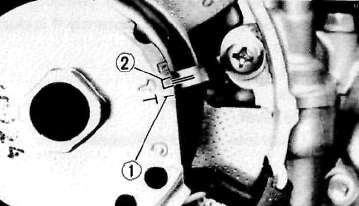
COMPRESSION PRESSURE MEASUREMENT
NOTE:
Insufficient compression pressure will result in performance loss.
1. Measure:
• Valve clearance
Out of specification — Adjust.
2. Warm up the engine.
3. Remove:
• Spark plugs
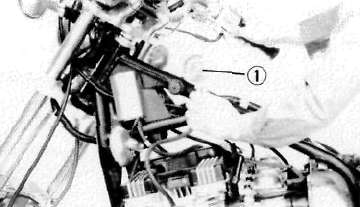
Compression pressure measurement steps:
• Install the Compression Gauge (YU-33223) (1) using an adapter.
• Crank over the engine with the electric starter (be sure the battery is fully charged) with the throttle wide-open until the compression reading on the gauge stabilizes.
• Check readings with specified levels (See chart).
Compression Pressure (at sea level):
Standard: 1,078 kPa (11 kg/cm2, 156 psi)
Minimum: 882 kPa (9 kg/cm2, 128 psi)
Maximum: 1,176 kPa (12 kg/cm2, 171 psi)
When cranking the engine, ground all of the spark plug leads to prevent sparking.
• Repeat the previous steps for the other cylinders.
• If pressure falls below the minimum level:
1. Squirt a few drops of oil into the affected cylinder.
2. Measure the compression again.
|
Compression Pressure (with oil introduced into cylinder) |
|
|
Higher than without oil |
Worn or damaged pistons |
|
Same as without oil |
Defective ring(s). valves, cylinder head gasket or piston is possible. |
|
Above maximum level |
Inspect cylinder head, valve surfaces, or piston crown for carbon deposits. |
NOTE:
The difference between the highest and lowest cylinder compression readings must not vary more than the specified value.
Difference Between Each Cylinder:
Less than 98 kPa (1 kg/cm2,14 psi)
Chassis Maintenance
Chassis Maintenance
FINAL GEAR OIL
Oil Level Measurement
1. Place the motorcycle on a level area and place on its centerstand.
2 Remove:
• Oil filler cap
3. Observe:
• Oil level (2)
Low level— Add oil. (1) Oil
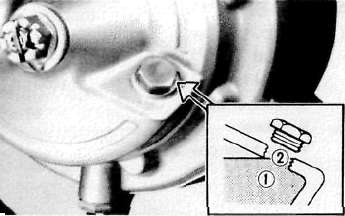
NOTE:
Oil level must be up to the brim of the filler hole.
CAUTION:
Be sure that no foreign material enters the final gear case.
Gear Oil Replacement
1. Place a receptacle under the final gear case.
2. Remove:
• Filler cap
• Drain plug (1) Drain final gear oil.
3. Install:
• Drain plug
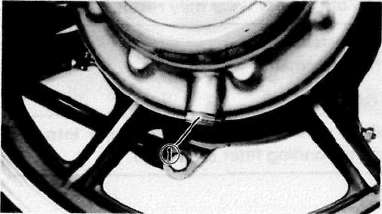
23 Nm (2.3 m-kg, 17ftlb)
4. Fill
• Gear case (to specified level.)
Final Gear oil:
SAE80 API "GL-4" Hypoid
gear oil Oil Capacity:
0.20 / (0.18 imp qt, 0.21 qt)
NOTE:
If desired, an SAE 80W90 Hypoid gear oil may be used for all conditions.
5. Install:
• Filler cap
23 Nm (2.3 m-kg, 17 ft-lb)
AIR FILTER
1. Remove:
• Seat
• Fuel tank
• Rubber cover
2. Remove:
• Air filter cover (1)
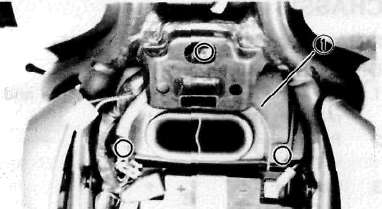
3. Eliminate:
• Dust
Use compressed air
4. Inspect:
• Element Damage - Replace.
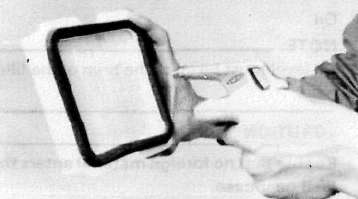
CAUTION:
The engine should never be run without the air/filter element installed; excessive piston and/or cylinder wear may result.
5. Install:
• Element
CAUTION:
Make sure the element cover fits into the corresponding filter case edge.
FRONT BRAKE
Brake Fluid Inspection
1. Check:
• Brake fluid level
Level low — Replenish.
NOTE:
Use only a designated, quality fluid.
DOT NO. 3
NOTE:
Be sure that:
• Water does not enter the master cylinder when refilling.
• Spilled fluid is cleaned up immediately to prevent painted surfaces or plastic parts from eroding.
(1) Lower level
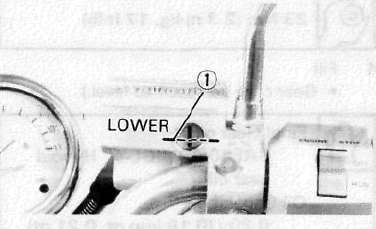
FRONT BRAKE/REAR BRAKE
Front Brake Lever Free Play Adjustment
1. Loosen:
• Adjuster lockout (1)
2. Adjust:
• Free play (3)
Turn the adjuster (2) until the free play (3) is within the specified limits.
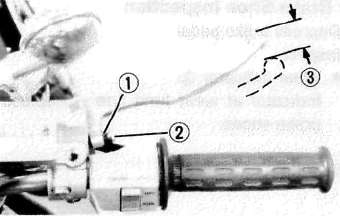
Brake Lever Free Play:
2-5 mm (0.08 ~ 0.2 in)
CAUTION:
Proper level free play is essential to avoid excessive brake drag.
3. Tighten:
• Adjuster locknut
Brake Pad Inspection
1. Activate the brake lever
2. Inspect:
• Wear indicator (1) Indicator almost contacts disc (2) — Replace pads. Refer to CHAPTER 5, "CHASSIS."
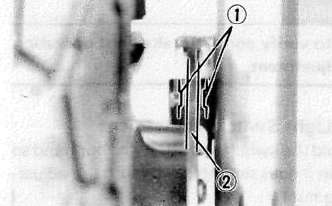
REAR BRAKE
Rear Brake Pedal Height Adjustment
1. Loosen:
• Adjust locknut (1) .
2. Adjust:
• Brake pedal height (2).
Turn the adjuster (3) until the brake pedal position is at the specified height.
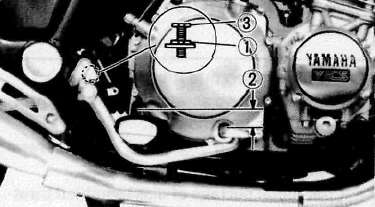
Brake Pedal Height: 10 mm (0.4 in) Below the Top of the Footrest
Adjust pedal height, then adjust brake pedal free play.
REAR BRAKE
Rear Brake Shoe Inspection
1. Depress brake pedal
2. Inspect:
• Wear indicator (2)
Indicator at wear limit line — Replace brake shoes.
(1) Wear limit line
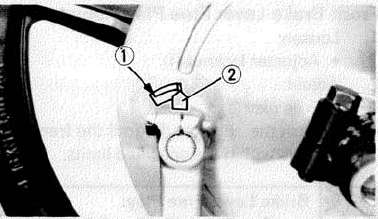
Rear Brake Pedal Free Play Adjustment
1. Rotate:
• Adjuster nut (1)
Turn it clockwise or counterclockwise until proper brake pedal free play is attained.
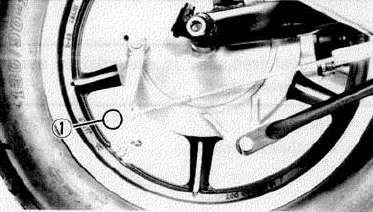
Brake Pedal Free Play:
20-30 mm (0.8 -1.2 in)
Check to verify correct brake light operation after adjustment.
Brake Light Switch Adjustment
1. Hold the switch body (1) with your hand so that it does not rotate and turn the adjusting nut (2) .
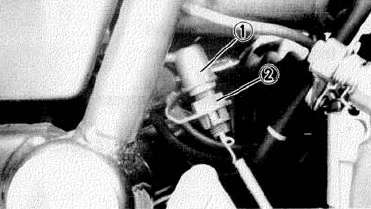
CABLE INSPECTION AND LUBRICATION
Cable inspection and lubrication steps:
• Remove the two screws that secure throttle housing to handlebar.
• Hold cable end high and apply several drops of lubricant to cable.
• Coat metal surface of disassembled throttle twist grip with suitable all-purpose grease to minimize friction.
• Check for damage to cable insulation. Replace any corroded or obstructed cables.
• Lubricate any cables that do not operate smoothly.
SAE 10W30 Motor Oil
BRAKE AND CHANGE PEDALS/ BRAKE CLUTCH LEVERS
Lubricate pivoting parts of each lever and pedal.
CENTERSTAND AND SIDESTAND
Lubricate centerstand and sidestand at their pivot points.
SAE 10W30 Motor Oil
FRONT FORK OIL CHANGE
Securely support the motorcycle so there is no danger of it falling over.
1. Place a suitable stand under the engine to raise the front wheel off the ground.
2. Loosen:
• Inner tube pinch bolt (1)
3. Remove:
• Fork cap (2)
• Cap bolt (3)
Use the Front Fork Cap Socket (YM-01104) (4)
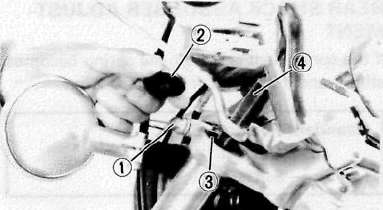
4. Remove:
• Drain screw (1) Drain the fork oil.
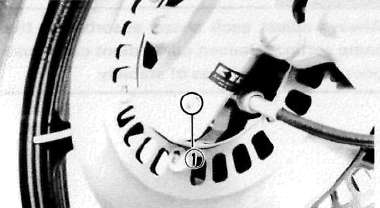
Do not allow any oil to contact the disc brake components. If oil is discovered, be sure to remove it, otherwise diminished braking capacity and damage to the rubber components of the brake assembly will occur.
7. Inspect:
• O-ring (1) (Cap-bolt)
• Gasket (Drain screw) Wear/Damage — Replace.
8. Install:
• Drain screw
9. Fill:
• Front fork
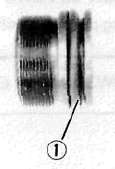
Each Fork:
383cm3(13.51 impoz, 12.95 USoz)
After filling pump the forks slowly up and down to distribute the oil.
10. Tighten:
• Cap-bolt
• Pinch bolt
Cap Bolt: 23 Nm (2.3 rrvkg, 17ftlb)
Pinch Bolt: 20 Nm (2.0 mkg, 14ft-lb)
11. Install:
• Fork cap
REAR SHOCK ABSORBER ADJUSTMENT
If the spring seat is raised, the spring becomes stiffer, and if lowered, it becomes softer.
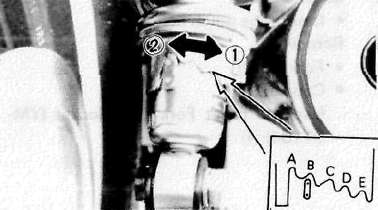
Standard Position: B A. — Softest (1) E. — Stiffest (2)
Always adjust each shock absorber to the same setting. Uneven adjustment can cause poor handling and loss of stability.
STEERING HEAD ADJUSTMENT
Steering Head Inspection
1. Place the motorcycle on its centerstand, then elevate the front wheel.
2. Check:
• Steering assembly bearings
Grasp the bottom of the forks and gently rock the fork assembly back and forth. Looseness — Adjust.
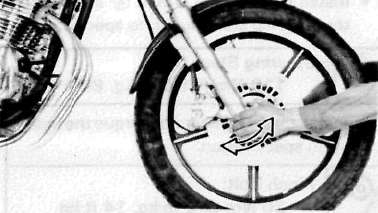
Adjustment
Steering head adjustment steps:
• Remove the handlebar securing bolts (1)
• Remove the handlebars .
• Remove the steering stem nut (2)
• Loosen the pinch bolts (3) .
• Remove the steering crown (4) .
• Remove the lock washer (5) .
• Loosen the ring nut (6) ,
• Tighten the ring nut (7) .
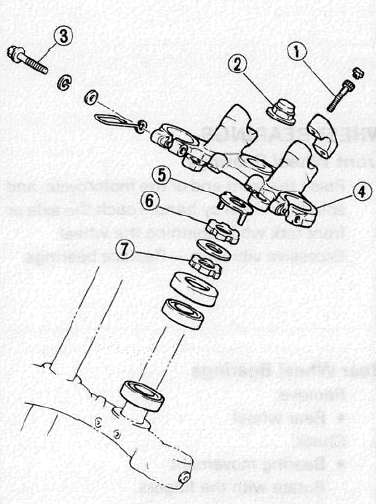
Ring Nut (Lower):
50 Nm (5.0 m-kg, 36 ft-lb)
The tapered side of ring nuts must face downward.
• Loosen the ring nut (7) completely and retighten it to specification.
Ring Nut (Lower):
6Nm(0.6 m-kg,4.3ft-lb)
• Check the steering stem by turning it lock to lock. If there is any binding, remove the steering stem assembly and inspect the steering bearings 8 .
(See CHAPTER 5, STEERING HEAD for more details.)
• Hand-tighten the ring nut (6) , then align the slots of both ring nuts. If not aligned, hold the lower ring nut (7) and tighten the other until they are aligned.
• Install the lock washer (5) .
NOTE:
Make sure the lock washer tab is placed in the slots.
• Install the steering crown (4) and tighten the steering stem nut (2) to specification.
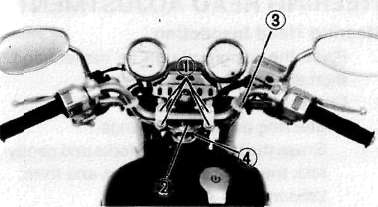
Steering Stem Nut:
110 Nm (11.0 m-kg, 80 ft*]
• Install the handlebar and torque the bolt 0 to specification.
Pinch Bolt: 20Nm(2.0m-kg, 14ft-lb)
Handlebar Bolt: 20 Nm (2.0 m-kg, 14 ft-lb)
WHEEL BEARINGS
Front Wheel Bearings
1. Raise the front end of the motorcycle, and spin the wheel by hand. Touch the axle or front fork while spinning the wheel-Excessive vibration — Replace bearings.
Rear Wheel Bearings
1. Remove:
• Rear wheel
2. Check:
• Bearing movement Rotate with the fingers. Roughness/Wear — Replace.
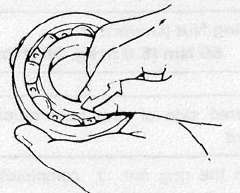
TUBELESS TIRES AND ALUMINUM WHEELS
• Always inspect aluminum wheels before a ride.
• Place the motorcycle on its centerstand and check for cracks, bends, or warpage of the wheels.
• Do not attempt any repairs to the wheel; replace any defective wheel.
• Do not attempt to use tubeless tires on a wheel designed for use with tube-type tire only. Tire failure and subsequent personal injury may result from sudden deflation.
• Be sure to install the proper tube when using tube-type tires.
• New tires have a relatively poor adhesion on the road surface so do not allow them to be subjected to high speed load from maximum speed until after a break-in run of approx. 100 km (60 mi).
• Always use the correct tire inflation pressure acording to the operating conditions.
|
Wheel |
Tire |
|
Tube type |
Tube type only |
|
Tubeless |
Tube type or tubeless |
|
A Tire |
C Tubeless tire |
|
B Wheel |
D Tube type tire |
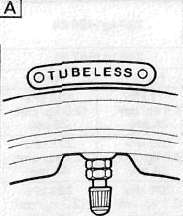
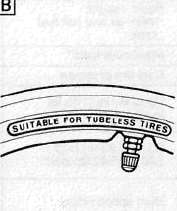
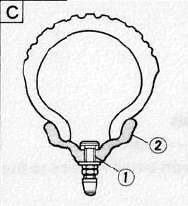
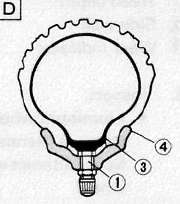
(1) Air valve
(2) Aluminum wheel (Tubeless type)
(3) Tube
(4) Aluminum wheel (tube type)
Always perform the following steps to ensure safe operation, maximum tire performance, and long service. 1. Measure:
• Tire pressure Out of specification — Adjust.
|
Basic weight: With oil and full fuel tank |
224 kg (494 lb) |
|
|
Maximum load * |
246 kg |
542 lb) |
|
Cold tire pressure |
Front |
Rear |
|
Upto90kg(198lb) load" |
177 kPa (1.8 kg/cm2. 26 psi) |
196 kPa (2.0 kg/cm2. 28 psi) |
|
90 kg (198 lb) load ~ 246 kg (542 lb) load- |
196 kPa (2.0 kg/cm*, 28 psi) |
275 kPa (2.8 kg/cm2. 40 psi) |
|
High speed riding |
206 kPa (2.1 kg/cm? 30 psi) |
225 kPa (2.3 kg/cm2 32 psi) |
* Load is the total weight of cargo, rider, passenger, and accessories.
2. Inspect:
• Tire surfaces Wear/Damage — Replace.
Minimum Tire Tread Depth: (Front and Rear) 1.0 mm (0.04 in)

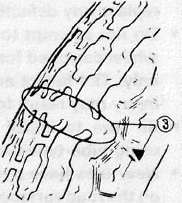
(1) Tread depth
(2) Side wall
(3) Wear indicator
3. Inspect:
• Aluminum wheels
Damage/Bends — Replace. Never attempt even small repairs to the wheel.
NOTE:
Always balance the wheel when a tire or wheel has been changed or replace.
Ride conservatively after installing a tire to allow it to seat itself properly on the rim.
Chapter 3, ENGINE OVERHAULING
Chapter 3, ENGINE OVERHAULINGCHAPTER3. ENGINEOVERHAULING
Engine Removal
Engine RemovalENGINE REMOVAL
NOTE:
It is not necessary to remove the engine in order to remove the following components:
• Piston
• Clutch
• Carburetor
• Oil pump
PREPARATION FOR REMOVAL
1. Remove all dirt, mud, dust, and foreign material before removal and disassembly.
2. Use proper tools and cleaning equipment. Refer to CHAPTER 1, "SPECIAL TOOL"

NOTE:
When disassembling the engine, keep mated parts together. This includes gear, cylinders, pistons, and other parts that have been "mated" through normal wear. Mated parts must be reused as an assembly or replaced.
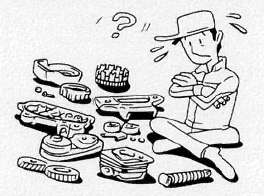
3. During the engine disassembly, clean all parts and place them in trays in the order of disassembly. This will speed up assembly time and help assure that all parts are correctly reinstalled in the engine.

SEAT AND FUEL TANK
1. Remove:
• Seat (1)
• Fuel tank (2)
• Left side cover (3)
2. Drain:
• Engine oil

BATTERY
1. Disconnect:
• Battery leads (1),(2)
• Breather hose (3)
NOTE:
Disconnect the negative lead first.

EXHAUST PIPE AND MUFFLER
1. Remove:
• Nuts
2. Loosen:
• Clamp bolts
3. Remove:
• Exhaust pipes (1)
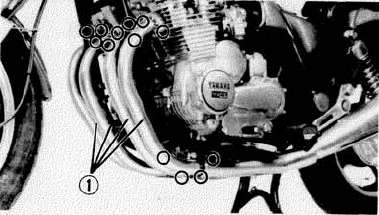
4. Remove:
• Chamber mount bolt (1)
• Muffler mount bolts (2)
• Muffler with chamber

CARBURETOR AND CABLES
1. Loosen:
• Clamp screws
2. Remove:
• Air cleaner case (1) mount bolts (2)
3. Push the air cleaner case toward the rear to disconnect air outlet hoses from carburetors.

4. Disconnect:
• Choke cables (3)
5. Remove:
• Carburetors
• Throttle cable (4)
NOTE:
After removing the carburetors, cover the carburetors with a clean cloth to keep dust and dirt out.

7. Disconnect:
• Crankcase ventilation hose (1) (from crankcase)
• Clutch cable (2)
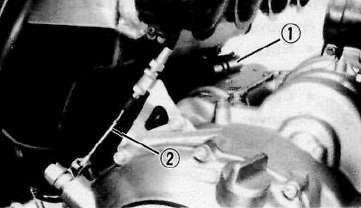
CONNECTOR
1. Remove:
• Plate
2. Disconnect:
• Pickup coil lead
• Generator lead
• Neutral switch lead
• Oil level switch lead
• Starter motor lead (1) (from starter motor)

SHIFT PEDAL BRAKE PEDAL, FOOTREST AND DRIVE SHAFT
1. Remove:
• Shift pedal (1)
• Left footrest (2)
2. Disconnect:
• Rubber boot (3)
3. Remove:
• Joint bolts (4)

4. Remove:
• Brake pedal (1)
• Right footrest (2)

ENGINE REMOVAL
1. Place a suitable stand under the engine.
2. Remove:
• Mounting bolts
• Downtube frame (1)

3. Remove:
• Engine assembly (from chassis right side)

Cylinder Head Removal
Cylinder Head RemovalENGINE OVERHAUL
A. Cylinder Head and Cylinder
1. Remove the cylinder head cover.
2. Remove the left crankcase cover (pickup coil cover).
3. Remove the cam chain tensioner.
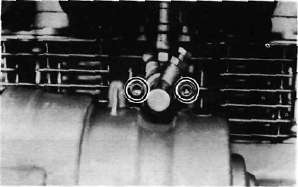
4. Use a 19 mm wrench on the timing plate flats to rotate the crankshaft counterclockwise until the engine is at T.D.C.
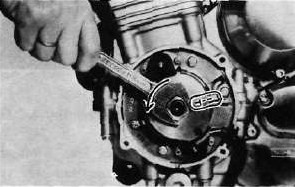
CAUTION:
Never use an alien wrench to rotate the crankshaft. Always use the 19 mm flats provided on the timing plate to rotate this engine.
5. Remove the four cam sprocket bolts.
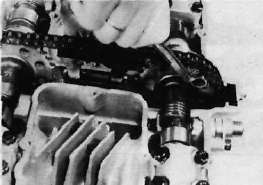
6. Slip each sprocket off its mounting boss on the cam.
CAUTION:
From this point on, do not rotate the cam shaft or valve damage may occur. On this, it is not necessary to break the cam chain. However, it can be broken if so desired. It is easier to disassemble the engine without separating the chain.
7. Remove the cam chain guide.
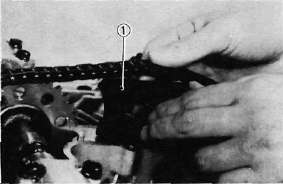
1. Cam chain guide
8. Remove the cam caps. Note the location of the cam caps. The caps for the intake cam shaft are identified 1-1 through I-3. The exhaust cam caps are identified E-1 through E-3. Directional arrows are cast on each cap and point toward the clutch side.
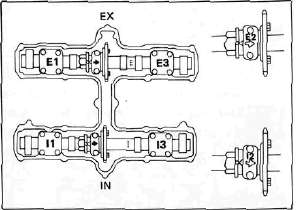
9. Fasten safety wire to the cam chain to prevent its falling into the crankcase cavity.
Slide the cams and sprockets from under the chain and remove the cams and sprockets.
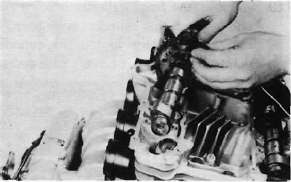
10. Remove the front cam chain guide.
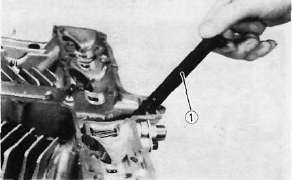
1. Front cam chain guide
11. Remove the spark plugs.
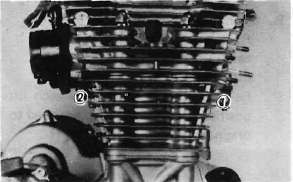
12. Remove the cylinder head bolts and nuts in the numerical order as shown. Start by loosening each nut 1/2 turn until all of the nuts are loose. Remove the cylinder head.
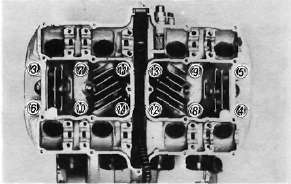
Cylinder and Cylinder Head Disassembly
Cylinder and Cylinder Head Disassembly
13. Remove the front cylinder holding nut and remove the cylinder assembly. It may be necessary to tap the cylinder lightly to loosen it from the base gasket.
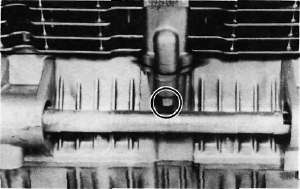
14. Remove the rear cam chain guide by loosening the holding bolt.
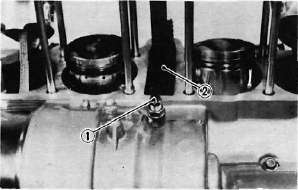
1. Holding bolt 2. Rear cam chain guide
B. Cylinder Head Disassembly
1. Remove the valve lifters and pads. Be careful not to scratch the lifter bodies or lifter bores in the cylinder head. Be very careful to identify each lifters position so that it may be returned to its original place.
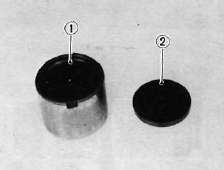
1. Valve filter 2. Adjusting pad
2. Mount the valve spring compressor on the head and depress each valve spring. Take out the retainer and valve spring with tweezers.
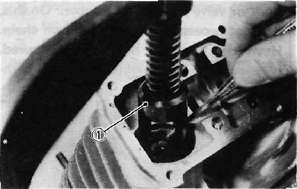
1. Valve spring compressor
3. Remove valves.
NOTE:
Deburr any deformed valve stem end. Use an oil stone to smooth the stem end. This will help prevent damage to the valve guide during valve removal.
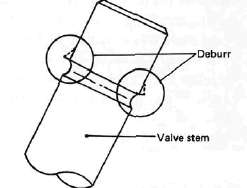
4. Use a small box to hold the parts and identify the original position of each lifter and valve. Be very careful not to mix the location of these components.
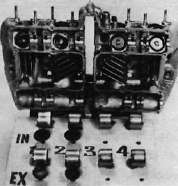
Piston, Pickup Coil, Shifter, Starter, Generator and Clutch Removal
Piston, Pickup Coil, Shifter, Starter, Generator and Clutch RemovalC. Piston
1. Mark each piston to aid in reassembly.
2. Place a clean towel or rag into the crank-case to keep circlips and material from falling into the engine.
3. Remove piston pin clips, piston pins, and pistons.
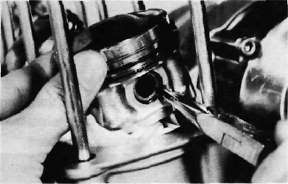
D. Pick-up Coil Assembly
1. Remove the alien bolt that holds the timing plate.
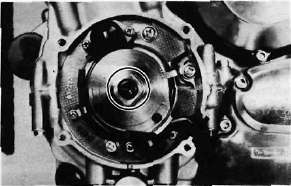
2. Remove the pick-up coil securing screws and remove the pick-up coil assembly.
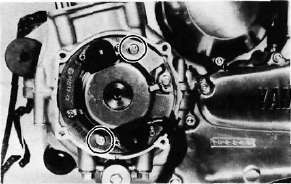
E. Shifter
1. Remove the change pedal.
2. Remove the left crankcase cover.
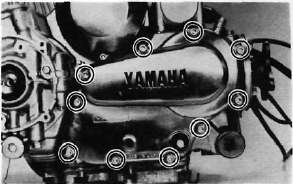
3. Remove the shift lever assembly and shift shaft assembly.
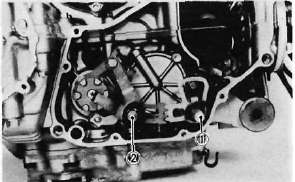
1. Shift lever assembly 2. Shift shaft assembly
4. Remove the middle gear case oil level maintaining plug.
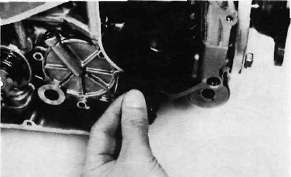
F. Starter Motor and Generator
1. Remove the starter motor securing bolts and remove the motor assembly.
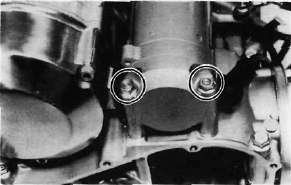
2. Remove the generator cover and stator coil assembly.

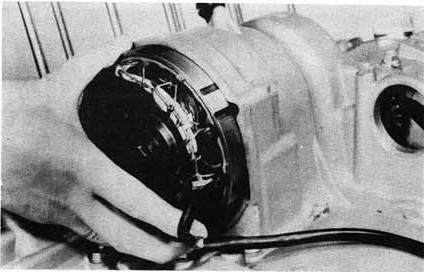
3. Install the rotor holding tool (special tool) on the rotor as shown and remove the rotor holding bolt.
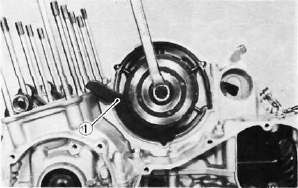
1. Rotor holding tool
4. Invert the holding tool as shown and insert the rotor puller adapter (special tool) into the rotor shaft and screw in the rotor puller (special tool). Remove the rotor.

1. Rotor puller adapter
G. Clutch
1. Remove right crankcase cover.
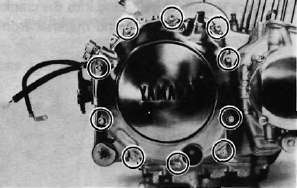
2. Release the tension evenly on the 6 mm bolts and remove the clutch pressure plate and clutch springs.
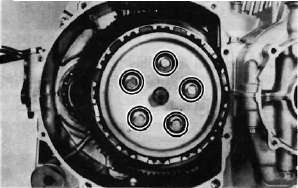
NOTE:
The outermost friction plate has a tab with a V-cut (1) in it. Give some identifying mark to the corresponding dog (2) in the clutch housing. This dog is the narrowest.

3. Remove the friction plates and clutch plates.
(1) Clutch spring bolts
(2) Clutch springs
(3) Pressure plate
(4) Friction plates
(5) Clutch plates
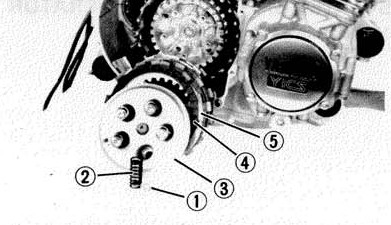
4. Straighten the lock washer tab. Use the clutch boss holder (special tool) to hold the clutch boss and remove the lock nut and lock washer.
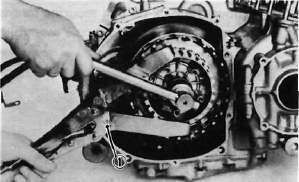
1. Clutch boss holder
5. Remove the clutch boss and spacer.

6. Screw in a suitable length of 6 mm bolt into the one of the threaded holes on the collar and pull out the collar and needle bearing from the primary driven gear.
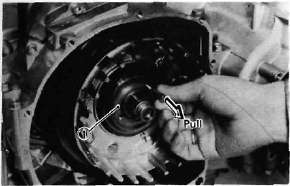
1. Collar
7. Remove the primary driven gear assembly and oil pump drive sprocket.
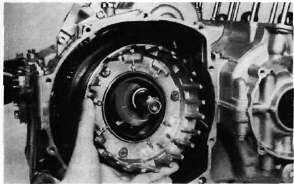
Oil Pump and Middle Gear Disassembly
Oil Pump and Middle Gear DisassemblyH. Oil Pump Removal and Disassembly
1. Remove the strainer cover. Note the wire harness clip position.
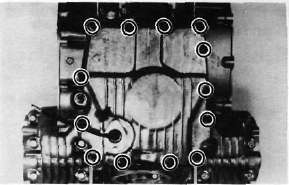
2a. Remove the oil pump securing bolts and remove the sprocket cover and oil pump assembly.

2b. Remove the Oil pump drive sprocket (1), Chain (2) Collar (3) and thrust plate.

CAUTION:
Do not attempt to remove the strainer screen as it is permanently fitted onto the pump housing. If the pump housing and/or any parts of the pump are damaged, the pump assembly must be replaced with a new one.
3. Remove the oil pump driven sprocket.

4. Remove the oil pump cover and rotor assembly.
5. Remove the pressure relief valve spring and plunger.

I. Middle Gear
1. Remove the middle driven gear housing holding bolts.
2. Remove the middle driven gear housing assembly and shims.

NOTE:
If it is difficult to remove housing assembly, loosen the two crankcase bolts located near the middle driven gear housing.
3. Remove "TORX" screws holding the middle drive gear assembly.
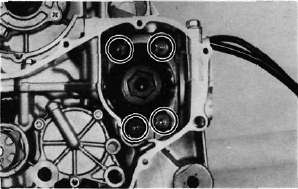
4. Remove the bearing retainers.
Upper Crankcase Disassembly
Upper Crankcase DisassemblyJ. Crankcase Disassembly
1. Remove the upper crankcase bolts, starting the highest numbered bolt. Turn over the engine and remove the lower crankcase bolts,
CRANKCASE TORQUE SEQUENCE
UPPER CASE
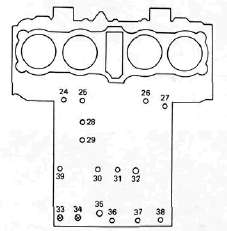
LOWERCASE
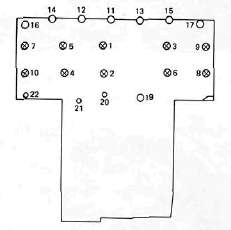
2. Separate the lower case from the engine. Use a soft rubber hammer to carefully separate the crankcase.
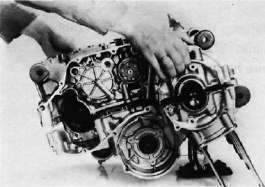
K. Upper Crankcase
1. Remove the middle drive gear and damper assembly.
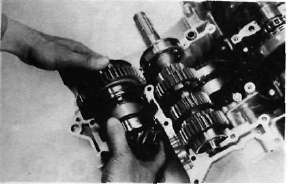
2. Remove the transmission main shaft assembly.
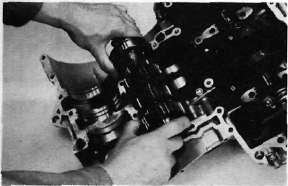
3. Remove the A.C.G. shaft cover.
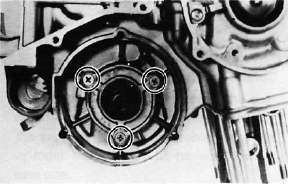
4, Remove the oil spray nozzle.
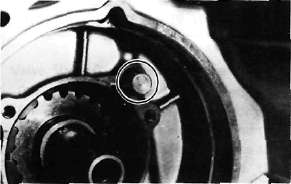
5. Carefully remove the A.C.G. shaft from the gear.
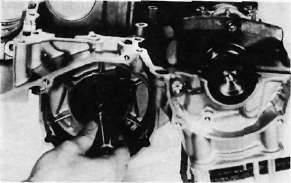
6. Remove the gear from the chain.
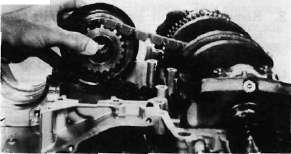
7. Straighten the lock washer tube and remove the bolt securing the starter idle gear shaft. Remove the shaft and starter idle gear.
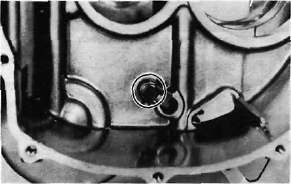
Lower Crankcase Disassembly
Lower Crankcase DisassemblyL. Lower Crankcase
1. Remove the dowel pin and "O-ring".
2. Remove the shift fork guide bar and shift forks. The shift forks are identified by numbers cast on their sides.
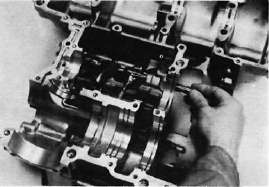
3. Remove the bolt securing the shift cam locating pin and remove the stopper plate and locating pin.
4. Remove the neutral switch.
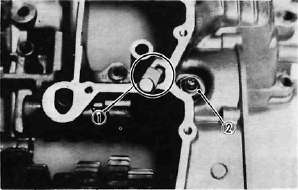
1. Shift cam locating pin 2. Neutral switch
5. Pull out the shift cam.
6. Remove the driven shaft bearing cover holding screws and remove the bearing cover.
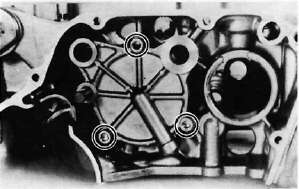
7. Remove the bearing and 5th wheel gear from the driven shaft and pull out the driven shaft assembly.
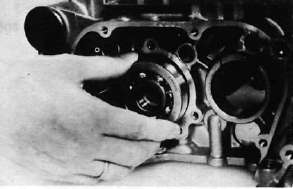
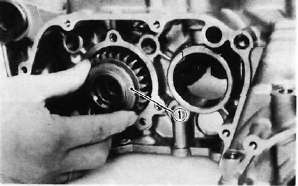
1. 5th wheel gear
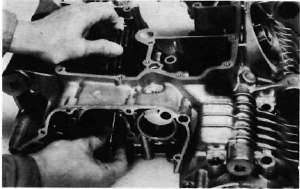
Cylinder Head and Valves -- Inspection & Repair
Cylinder Head and Valves -- Inspection & RepairINSPECTION AND REPAIR
A. Cylinder Head Cover
Place head cover on a surface plate. There should be no warpage. Correct by re-surfacing as follows:
Place #400 or #600 grit wet sandpaper on surface plate and re-surface head cover using a figure-eight sanding pattern. Rotate head cover several times to avoid removing too much material from one side.
B. Cylinder Head
1. Using a rounded scraper, remove carbon deposits from combustion chamber. Take care to avoid damaging spark plug threads and valve seats. Do not use a sharp instrument. Avoid scratching the aluminum.
2. Check the cylinder head warpage with a straight edge as shown.

The warpage should not exceed the specified limit, if necessary resurface. If the warpage exceeds allowable limit, the cylinder head should be replaced with a new one.
Cylinder head warpage: less than 0.03 mm (0.0012 in)
Allowable limit: 0.25 mm (0.010 in)
C. Valve, Valve Guide, and Valve Seat
1a. Check the valve face and the stem end for wear. If the valve face and/or the stem end are pitted or worn, regrind the valve with a valve refacer. Replace the valve if any dimension exceeds the specifications:
(1) 0.7 mm (0.028 in) Minimum Thickness (service limit)
(2) 0.5mm (0.020 in) bevel
(3) 4.0mm (0.157 in) Minimum Length (Service limit)

1b. Measure the contacting mark position on the valve face (1) and verify it is 0.3 mm (0.12 in) from the edge and 1.0mm +/- 0.1mm (0.039 +/- 0.004 in) wide. If it is out of range, the valve seat should be recut as detailed below.

2. Valve stem wear must be measured and then combined with valve guide measurements to guide clearance. This clearance must be within tolerances. If it exceeds the maximum limit, then replace either or both valve and guide, as necessary.
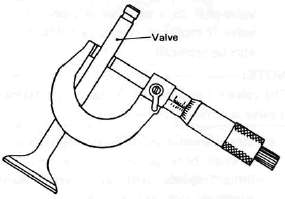

|
|
Valve Stem Clearance |
Maximum |
|
Intake |
0.010 — 0.037 mm (0.0004-0.0015 in) |
0.10 mm (0.004 in) |
|
Exhaust |
0.025-0.052 mm (0.0010-0.0020 in) |
0.12 mm (0.005 in) |
3. Valve stem end
Inspect the end of the valve stem. If the end appears to be "mushroomed" or has a larger diameter than the rest of the stem, the valve, valve guide, and oil seal should be replaced.
4. Turn valve on "V" blocks and measure the amount of stem runout with a dial gauge. If it exceeds the maximum limit, replace the valve.
Maximum valve stem runout: 0.03 mm (0.0012 in)

5. Valve guide and valve oil seal replacement If oil leaks into the cylinder through a valve due to a worn valve guide, or if a valve is replaced, the valve guide should also be replaced.
NOTE:
The valve oil seal should be replaced whenever a valve is removed or replaced.
a. Measure valve guide inside diameter with a small bore gauge. If it exceeds the limit, replace with an oversize valve guide.
Guide diameter (I.D.):
Limit: 7.10 mm (0.280 in)
b. To ease guide removal and reinstallation, and to maintain the correct interference fit, heat the head to 100t (212°F). Use an oven to avoid any possibility of head warpage due to uneven heating.
c. Use the appropriate shouldered punch (special tool) to drive the old guide out and drive the new guide in.
NOTE:
When a valve guide is replaced, the O-ring should also be replaced.

1. Valve guide remover 2. Valve guide installer
d. After installing the valve guide, use the 7 mm reamer (special tool) to obtain the proper valve guide to valve stem clearance.

e. After installing the valve guide in the cylinder head, the valve seat must be recut. The valve should be lapped to the new seat.
6. Grinding the Valve Seat
a. The valve seat is subject to severe wear. Whenever the valve is replaced or the valve face is re-surfaced (see caution) the valve seat should be re-surfaced at a 45° angle. If a new valve guide has been installed the valve seat must be recut to guarantee complete sealing between the valve face and seat.

CAUTION:
If the valve seat is obviously pitted or worn, it should be cleaned with a valve seat cutter. Use the 45° cutter, and when twisting the cutter, keep an even downward pressure to prevent chatter marks.
If cutting section "A" of the valve seat, use 30° cutter. If cutting section "B", use the 45° cutter. If cutting section "C" use 60° cutter. b. Measure valve seat width. Apply mechanic's bluing dye (such as Dykem) to the valve face and valve seat, apply a very small amount of fine grinding compound around the surface of the valve face insert the valve into position, and spin the valve quickly back and forth. Lift the valve, clean off all grinding compound, and check valve seat width. The valve seat and valve face will have removed bluing wherever they contacted each other. Measure the seat width with vernier calipers. It should measure approximately 1.1 mm (0.0433 in). Also, the seat should be uniform in contact area. If valve seat width varies, or if pits still exist, further cutting will be necessary. Remove just enough material to achieve a satisfactory seat.
|
|
Standard Width |
Wear Limit |
|
Seat width |
1.0 ±0.1 mm (0.0394 ± 0.0039in) |
1.4 mm (0.055 in) |

a. Seat width
c. If the valve seat is uniform around the perimeter of the valve face, but is too wide or not centered on the valve face, it must be altered. Use either the 30°, 45° or 60° cutters to correct the improper
seat location in the manner described below:

1) If the valve face shows that the valve seat is centered on the valve face, but too wide, then lightly use both the 30° and the 60° cutters to reduce the seat width to 1.1 mm (0.0433 in).

1. Valve seat cutter
2) If the seat shows to be in the middle of the valve face, but too narrow, use the 45°cutter until the width equals 1.1 mm(0.0433 in).
3) If the seat is too narrow and right up near the valve margin, then first use the 30° cutter and then the 45° cutter to get the correct seat width.
4) If the seat is too narrow and down near the bottom edge of the valve face, then first use the 60° cutter and then the 45° cutter.
7. Lapping the valve/valve seat assembly a. The valve/valve seat assembly should be lapped if neither the seat nor the valve face are severely worn.
b. Apply asmall amount of coarse lapping compound to valve face. Insert the valve into the head. Rotate the valve until the valve and valve seat are evenly polished. Clean off the coarse compound, then follow the same procedure with fine compound.
Continue lapping until the valve face shows a complete and smooth surface all the way around. Clean off the compound material. Apply bluing dye to the valve face and seat and rotate the valve face for full seat contact which is indicated by a grey surface all around the valve face where the bluing has been rubbed away.
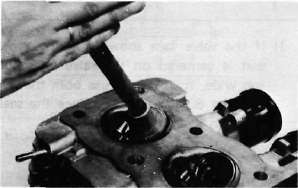
c. Valve leakage check
After all work has been performed on the valve and valve seat, and all head parts have been assembled, check for proper valve/valve seat sealing by pouring solvent into each of the intake ports, then the exhaust ports. There should be no leakage past the seat. If fluid leaks, disassemble and continue to lap with fine lapping compound. Clean all parts thoroughly, reassemble and check again with solvent. Repeat this procedure as often as necessary to obtain a satisfactory seal.
Valve Springs and Lifters, Camshafts, Chain and Guides -- Inspection and Repair
Valve Springs and Lifters, Camshafts, Chain and Guides -- Inspection and RepairD. Valve Spring and Lifters
1. Checking the valve springs
a. This engine uses two springs of different sizes to prevent valve float or surging. The valve spring specifications show the basic value characteristics.
b. Even though the spring is constructed of durable spring steel, it gradually loses some of it's tension. This is evidenced by a gradual shortening of free length. Use a vernier caliper to measure spring free length. If the free length of any spring has decreased more than 2 mm (0.080 in) from its specification replace it.
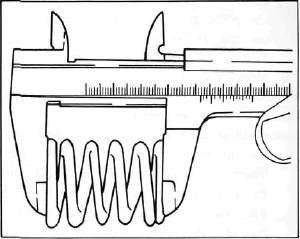
c. Another symptom of a fatigued spring is insufficient spring pressure when compressed. This can be checked using a valve spring compression rate gauge. Test each spring individually. Place it in the gauge and compress the spring first to the specified compressed length with the valve closed (all spring specifications can be found in the previous section, Valve Spring), then to the length with the valve open. Note the poundage indicated on the scale at each setting. Use this procedure with the outer springs, then the inner springs.
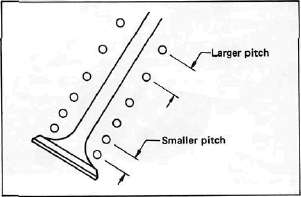
NOTE:
All valve springs must be installed with larger pitch upward as shown.
|
Valve Spring Specifications |
||
|
|
OUTER |
INNER |
|
Free length |
37.0 mm (1.457 in) |
33.5 mm (1.319 in) |
|
Installed length (valve closed) |
34.0 mm (1.339 in) |
31.0 mm (1.220 in) |
|
Installed pressure |
17.2 kg -21.0 (37.9 - 46.3 lb) |
8.1 - 9.9 kg (17.9 - 21.8 1b) |
|
Allowable tilt from vertical |
1.6° |
|
2. Valve lifter
a. Check each valve lifter for scratches or other damage. If the lifter is damaged in any way, the cylinder head surface in which it rides is probably also damaged. If the damage is severe, it may be necessary to replace both the lifter and the cylinder head.
NOTE:
For proper valve lifter-to-head clearance, always install lifters on their original valves.
E. Camshafts, Cam chain and Cam Sprockets
1. Camshaft
a. The cam lobe metal surface may have a blue discoloration due to excessive friction. The metal surface could also start to flake off or become pitted.
b. If any of the above wear conditions are readily visible, the camshaft should be replaced.
c. Even though the cam lobe surface appears to be in satisfactory condition, the lobes should be measured with a micrometer. Cam lobe wear can occur without scarring the surface. If this wear exceeds a pre-determined amount, valve timing and lift are affected. Replace the camshaft if wear exceeds the limits.
| Cam Lobe A | Cam Lobe B | |
| Intake | 36.8 mm (1.449 in) | 28.1 mm (1.106 in) |
| Exhaust | 36.3 mm (1.429 in) | 28.06 mm (1.105 in) |

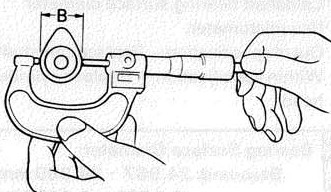
d. Install the camshaft on the cylinder head. Place a strip of Plastigage between camshaft and camshaft cap as illustrated (lengthwise along camshaft). Tighten the nuts with specified torque. Remove the camshaft cap and determine the clearance by measuring the width of the flattened Plastigage.
Cap nut tightening torque: 1.0m-kg(7.2ft-lb)
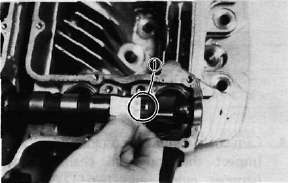
1. Plastigage
NOTE:
Do not turn camshaft when measuring clearance with Plastigage.
Camshaft-to-cap clearance:
|
Standard: |
0.020-0.054 mm |
|
|
(0.0008- 0.0021 in) |
|
Maximum: |
0.160 mm (0.006 in) |
If the camshaft-to-cap clearance exceeds specification, measure camshaft bearing surface diameter.
Bearing surface diameter:
|
Standard: |
24.967-24.980 mm |
|
|
(0.9830-0.9835 in) |
1) If camshaft diameter is less than specification, causing excessive clearance, replace camshaft.
2) If camshaft is within specification and camshaft-to-cap clearance is excessive, replace cylinder head.
2. Cam chain
Except in cases of oil starvation, the cam chain wears very little. If the cam chain has stretched excessively and it is difficult to keep the proper cam chain tension, the chain should be replaced.
3. Cam sprockets
Check cam sprockets for obvious wear.
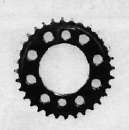
4, Cam chain dampers
Inspect the top cam chain damper (stopper guide) and two (2) vertical (slipper-type) dampers for excessive wear. Any that shows excessive wear should be replaced. Worn dampers may indicate an improperly adjusted or worn-out cam chain.

(1) Upper guide
(2) Front guide
(3) Rear guide
5 Automatic Cam Chain Tensioner
Ensure operation is one-way and smooth. Inspect all parts for wear or damage

(1) End plug
(2) Washer
(3) Springs
(4) Tensioner body
(5) One way cam
(6) Tensioner rod
Cylinder and Piston -- Inspection and Repair
Cylinder and Piston -- Inspection and Repair. Cylinder
1. Inspect the cylinder walls for scratches. If vertical scratches are evident, the cylinder wall should be rebored or the cylinder should be replaced.
2. Measure cylinder wall wear as shown. If wear is excessive, compression pressure will decrease. Rebore the cylinder wall and replace the piston and piston rings. Cylinder wear should be measured at three depths with a cylinder bore gauge. (See illustration.)
|
|
Standard |
Wear Limit |
|
Cylinder bore |
65.00 mm (2.5591 in) |
65.005 mm (2.5592 in) |
|
Cylinder taper |
— |
0.05 mm (0.002 in) |
|
Cylinder out-of-round |
— |
0.01 mm (0.0004 in) |
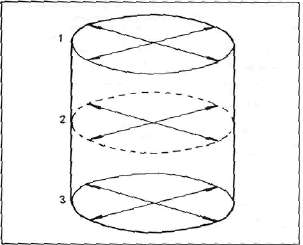
If the cylinder wall is worn more than the wear limit, it should be rebored.
G. Piston andPiston Rings
1. Piston
a. Measure the outside diameter of the piston at the piston skirt. Measurement should be made at a point 7.5 mm (0.3 in) above the bottom edge of the piston. Place the micrometer at right angles to the piston pin.
|
Standard |
64.955 - 64.970 mm (2.5573 - 2.5579 in) |
|
Oversize 1 |
65.5 mm (2.58 in) |
|
Oversize 2 |
66.0 mm (2.60 in) |
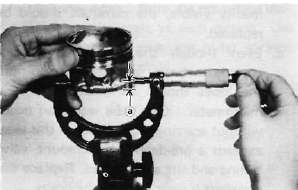
a. 7.5 mm (0.3 in)
b. Determine piston clearance as follows:
Minimum bore measurement — Maximum piston measurement * Piston clearance
EXAMPLE:
63.0 mm (2.4803 in) - 62.96 mm (2.4787 in)= 0.04 mm (0.0016 in)
Piston clearance
Piston clearance:
Standard: 0.030 - 0.050 mm (0.0012 - 0.0020 in)
Service limit: 0.1 mm (0.0039 in)
c. Piston ring/ring groove fit must have correct clearance. If the piston and ring have already been used, the ring must be removed and the ring groove cleaned of carbon. The ring should then be reinstalled. Use a feeler gauge to measure the gap between the ring and the land.
|
Side clearance |
Top |
0.03- 0.07 mm (0.0012- 0.0028 in) |
|
2nd |
0.02-0.06 mm (0.0008- 0.0024 in) |

1. Feeler gauge
2. Piston ring
a. The oversize top and middle ring sizes are stamped on top of the ring.
| Oversize 2 | 0.50 mm (0.0197 in) |
| Oversize 4 | 1.00 mm (0.0394 in) |
b. The expander spacer of the bottom ring (oil control ring) is color-coded to identify sizes.
The color mark is painted on the expander spacer.
|
Size |
Color |
| Oversize 2 | Blue |
| Oversize 4 | Yellow |
c. Push the ring into the bore and check end gap clearance with a feeler gauge.
NOTE:
The end gap on the expander spacer of the oil control ring is unmeasurable. If the oil control ring rails show excessive gap, all three components should be replaced.
|
|
||
|
|
Standard |
Limit |
|
Top/2nd ring |
0.15 — 0.30 mm (0.006- 0.012 in) |
1.0 mm (0.04 in) |
|
Oil control (Rails) |
0.2-0.7 mm (0.008-0.028 in) |
--- |
H. Piston Pin
1. Apply a light film of oil to pin. Install in connecting rod small end. Check for play. There should be no noticeable vertical play. If play exists, check connecting rod small end for wear. Replace pin and connecting rod as required.
2. The piston pin should have no noticeable free play in piston. If the piston pin is loose, replace the pin and/or the piston.
Crankshaft, Con rods and Bearings -- Inspection and Repair
Crankshaft, Con rods and Bearings -- Inspection and RepairI. Crankshaft
1. Crankshaft run-out
Support the crankshaft at both ends on V-blocks. Measure the amount of crankshaft run-out on the main bearing journals with a dial gauge while rotating crankshaft.
Run-out limit: 0.030 mm (0.0012 in)
If run-out exceeds limit, replace crankshaft.
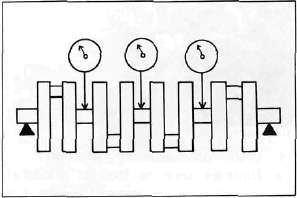
2. Inspection of bearings
Check the bearings. If the inner or outer surface is burned, flaked, rough, scratched or worn, the bearings should be replaced.
3. Measuring main bearing oil clearance
a. Clean all crankshaft and crankcase journal surfaces.
b. Place upper crankcase half upside-down on a bench. Install bearing inserts into top crankcase.
c. Install crankshaft into upper crankcase.
d. Place Plastigage on crankshaft journal surface to be inspected.
NOTE:
Do not move crankshaft until clearance check has been completed.
e. Install bearings into bottom crankcase. Carefully, place lower crankcase onto upper crankcase.
The crankshaft main bearing which has no groove on the bearing surface should be installed in the upper crankcase.
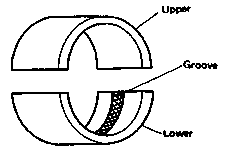
f. Install crankcase holding bolts 1 through 10. Tighten to full torque in torque sequence cast on crankcase.
Crankcase torque (8 mm bolt): 2.4 m-kg (17 ft-lb)

g. Remove bolts in reverse assembly order (10,9,8... etc.)
h. Carefully remove lower crankcase. Measure width of Plastigage on crankshaft journals to determine clearance.
Main bearing oil clearance: 0.020 - 0.044 mm (0.0008-0.0017 in)
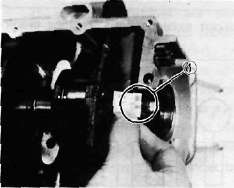
1. Plastigage
4. Crankshaft main bearing selection a. Numbers used to indicate crankshaft journal sizes are stamped on the L.H. crank web. The first five (5) are main bearing journal numbers, starting with the left journal. The four (4) rod bearing journal numbers follow in the same sequence.

For greater clarity:

The upper crankcase half is numbered 4, 5, or 6 as shown.

1. Main bearing numbers
b. The connecting rods are numbered 3 or 4. The numbers for rods are stamped with ink on the rod itself.
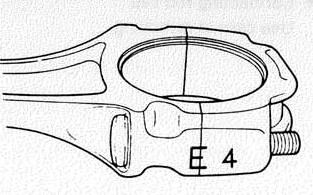
1. Connecting rod size number
c. The proper bearing selection is made by subtracting the crankshaft journal number from the crankcase or rod size number. Use the color code to choose the proper bearing.
EXAMPLE:
Rod No. (Minus) Journal No. = Bearing No. 5-2 = 3 No. 3 bearing is Brown. Use Brown bearing inserts.
|
BEARING COLOR CODE |
|
|
No. 1 |
Blue |
|
No. 2 |
Black |
|
No. 3 |
Brown |
|
No. 4 |
Green |
|
*No. 5 |
Yello |
#For crankshaft main bearing only.
d. When assembling, apply a liberal coat of motor oil to all bearing surfaces.
NOTE:
When applying final torque to the rod caps, observe the following procedures:
e. Be sure the letter on both components align to form a perfect character:

f. Apply molybdenum disulfide grease to connecting rod bolt threads. Apply torque evenly to both ends of the cap. While tightening, if a torque of 2.0 m-kg (14.5 ft-lb) or more is reached, DO NOT STOP tightening until final torque is reached. If tightening is interrupted between 2.0 m-kg and 2.5 m-kg, loosen the nut to less than 2.0 m-kg and start again. Tighten to full torque specification (25 m-kg, 18 ft-lb) without pausing.
Oil Pump and Clutch -- Inspection and Repair
Oil Pump and Clutch -- Inspection and RepairJ. Oil Pump
1. Check the clearance between housing and outer rotor.
Standard clearance B : 0.03 ~ 0.08 mm (0.0012 ~ 0.0031 in)
2. Check the clearance between outer rotor and inner rotor.
Standard clearance: 0.03 - 0.09 mm (0.001 - 0.003 in)
3 Check the rotor to housing clearance using a straight-edge.
Standard clearance: 0.03 - 0.08 mm (0.001 - 0.003 in)

4. Check the plunger for scratches and wear.

1. Relief valve plunger
K. Clutch
1. Clutch housing
a. Check the dogs on the clutch housing. Look for cracks and signs of galling on edges. If damage is moderate, deburr. If severe, replace the clutch housing.
NOTE:
Galling on the friction plate dogs of the clutch housing will cause erratic clutch operation. These can be dressed with a flat file using the indentations as a guide for depth.

b. Check the clutch housing bearing for damage. If damaged replace bearing.
2. Clutch boss
a. The clutch boss contains a built-in damper beneath the first clutch plate (clutch plate 2). It is not normally necessary to remove the circlip and disassemble the built-in damper unless there is serious clutch chattering.
b. Check splines on clutch boss for galling. If damage is slight to moderate, deburr; if it is severe, replace clutch boss.
NOTE:
Galling on clutch plate splines will cause erratic operation.

3. Friction and clutch plates
Check clutch steel plates and friction plates for heat damage. Measure friction plate thickness at 3 or 4 points. Measure clutch plates for warpage with a dial gauge and stand. Replace clutch plate or friction plates as a set if any is faulty or beyond wear limits.
|
|
Standard |
Wear limit |
|
Friction plate thickness |
3.0 mm (0.12 in) |
2.8 mm (0.11 in) |
|
Clutch plate warp limit |
— |
0.05 mm (0.0020 in) |


1. Feeler gauge
4. Clutch actuating mechanism

1. Plate washer 2. Thrust bearing 3. Pull rod
a. Check the pull rod rack gear teeth for wear and damage, replace if damaged.
b. Check the pull rod thrust bearing for damage, replace if damaged.
c. Check the clutch lever shaft pinion gear teeth for damage, replace if damaged.
5. Clutch springs
Measure the clutch spring free length. Replace the springs as a set if any is less than minimum free length.
Clutch spring minimum length: 50.1 mm (1.969 in)
Transmission -- Inspection and Repair
Transmission -- Inspection and RepairL. Transmission
1. Inspect each shift fork for signs of galling on gear contact surfaces. Check for bending. Make sure each fork slides freely on its guide bar.

2. Roll the guide bar across a surface place. If the bar is bent, replace.
3. Check the shift cam grooves for signs of wear or damage. If any profile has excessive wear and/or damage, replace cam.

4. Check the cam followers on each shift fork for wear. Check the ends that ride in the grooves in the shift cam. If they are worn or damaged, replace the shift forks.
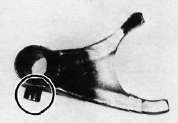
5. Check shift cam dowel pins and side plate for looseness, damage or wear. Replace as required.
6. Check the shift cam stopper plate and circlip and stopper for wear. Replace as required.
7. Check the transmission shafts using a centering device and dial gauge. If any shaft is bent beyond specified limit, replace shaft.
Maximum run-out: 0.08 mm (0.0031 in)
8. Carefully inspect each gear. Look for signs of obvious heat damage (blue discoloration). Check the gear teeth for signs of pitting, galling or other extreme wear. Replace as required.
9. Check to see that each gear moves freely on its shaft.
10. Check to see that all washers and clips are properly installed and undamaged. Replace bent or loose clips and bent washers.
11. Check to see that each gear properly engages its counterpart on the shaft. Check the mating dogs for rounded edges, cracks, or missing portions. Replace as required.
M. Starter Drivers

1. Electric starter clutch and gears
a. Check the surface of the idle gear for pitting or other damage. If severe, replace the gear.
b. Check the spring caps and the springs for deformation or damage. If severe, replace as necessary.
c. Check the starter clutch bolts (alien screw) for looseness. If loose, remove the bolts and replace with new bolts. Apply a thread locking compound such as "LOCTITE" to threads and tighten to specified torque. Stake over the end of the bolts.
Starter clutch bolt torque: 3.0 m-kg (21.7 ft-lb)
d. Check the "HY-VO" chain for damage and wear, replace if damaged.
e. Check the "HY-VO" chainguide for damage, replace if damaged.
N. Crankcases and Strainer Cover
1. Check crankcase for cracks or other damage.
2. Clean all oil passages and blow out with compressed air.
3. Strainer cover: Apply a thread locking compound such as "LOCTITE" to strainer cover bolts during reassembly.
O. Bearing and Oil Seals
1. After cleaning and lubricating bearings, rotate inner race with a finger. If rough spots are felt, replace the bearing.
NOTE:
Bearings are most easily removed or installed if the housings are first heated to approximately 95°~12E?C (200°~250°F). Bring the case up to proper temperature slowly. Use an oven to avoid distortion.
2. Check oil seal lips for damage and wear. Replace as required.
Middle Gear -- Inspection and Repair
Middle Gear -- Inspection and RepairP. Middle Gear
1. Damper disassembly
NOTE:
Disassembly of the middle gear damper requires the damper compressor (special tool) and a hydraulic press.
a. Place the middle drive shaft in a press with the damper compressor (special tool) in place as shown.
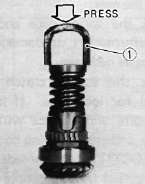
1. Damper compressor
b. Press the damper spring and remove the spring retainers.
c. Remove the spring seat, spring, and damper cams from the drive shaft.
2. Inspection
a. Inspect the damper cam surfaces. Check for smooth cam action and excessive wear on the cam surface. If cam surface is severely worn, replace damper assembly.
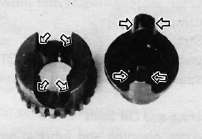
b. Inspect the damper spring for fatigue, wear and damage. Replace as necessary.
c. Check bearing movement for damage to balls, rouge spots, bearing looseness. Inspect gear teeth. If any gear tooth and/or bearing are damaged, the gear set and/or bearing must be replaced.
3. Middle drive/driven shaft bearing removal
CAUTION:
The following procedures should be performed only if the bearing or gear is to be replaced.
a. Middle drive gear
1) Bend down the locking collar of the nut with a suitable center punch.
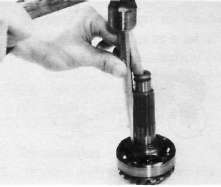
2) Support the middle drive shaft holder (special tool) in a vise securely and put the drive pinion on it as shown. Remove the bearing holding nut with the 46 mm socket (special socket) and remove the bearing.
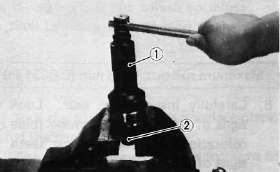
1. Middle drive shaft nut wrench (46 mm socket)
2. Middle drive shaft holder
b. Middle driven gear
1) Support the drive flange in a vise securely. Remove the flange holding nut.
CAUTION:
This holding nut has been locked with a thread locking compound, when reinstalling do not forget to apply a thread locking compound such as "LOCTITE" and punch.
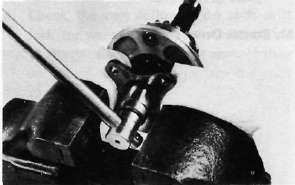
2) Remove the drive flange from the driven shaft.
NOTE:
Driven gear shaft bearing should be replaced together with a bearing housing.
4. Middle gear reassembly
a. Middle drive gear bearing and damper
1) Install the bearing onto the drive pinion and secure it with a new lock nut using the middle drive shaft holder and special socket.
Tightening torque: 11 m-kg (80 ft-lb)
2) Stake the locking collar of the nut to the slot on the drive pinion shaft.
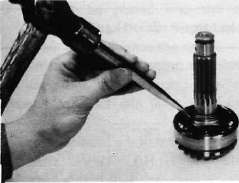
3) Install the driven damper cam onto the drive pinion shaft with the cam lobes positioned 90° from the row of shaft oil holes. Positioning tolerance is ± 1 spline (15°) from the 90° position.
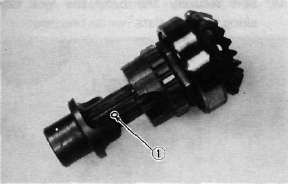
1. Oil hole
4) Install the drive damper cams, spring, spring seat, and retainers using a press and the damper compressor.
b. Middle driven gear
1) Install the new bearing housing assembly onto the driven pinion shaft.
CAUTION:
Do not press the bearing outer race. Always press the inner race with care when installing.
2) Install the drive flange and new "O-ring" onto the driven gear shaft. Apply a thread locking compound such as "LOCTITE" to the shaft threads and tighten the nut to the specified torque.
Tightening torque: 12 m-kg (87 ft-lb)
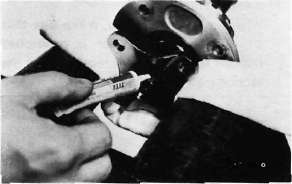
3) Stake the nut with a center punch to lock as shown.
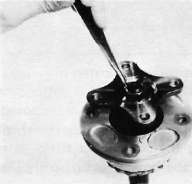
4) Install the new "O-ring" onto the bearing housing.
Upper Crankcase Reassembly
Upper Crankcase ReassemblyENGINE ASSEMBLY AND ADJUSTMENT
A. Important Information
1. Gasket and seal
All gaskets and seals should be replaced when an engine is overhauled. All gasket surfaces and oil seal lips must be cleaned.
2. Properly oil all mating engine and transmission parts and bearings during reassembly.
3. Circlip
All circlips should be inspected carefully before reassembly. Always replace piston pin clips after one use. Replace distorted circlips.
When installing a circlip, make sure that the sharp edged corner is positioned opposit to the thrust it receives. See the sectional view below.
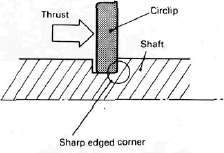
4. Lock washer/plate and cotter pin
All lock washers/plates and cotter pins must be replaced when they are removed. Lock washer/plate tab(s) should be bent over along the bolt or nut flat(s) after tightening the bolt or nut properly (see illustration).
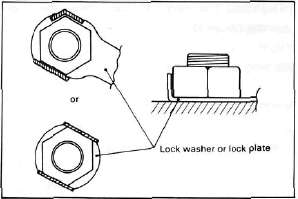
Cotter pins should be replaced after one use.
B. Engine Assembly
1. Upper crankcase
a. Install the connecting rods onto the crankshaft with the proper connecting rod bearings. Apply oil to bearings and molybedenum disulfide grease to the bolt threads. Apply torque evenly to both ends of the cap.
CAUTION:
While tightening, if a torque of 2.0 m-kg (14.5 ft-lb) or more is reached, DO NOT STOP tightening until final torque is reached.
If tightening is interrupted between 2.0 m-kg and 2.5 m-kg, loosen the nut to less than 2.0 m-kg and start again. Tighten to full torque specification without pausing.
Rod cap torque: 2.5 m-kg (18.1 ft-lb)
b- Install the proper cankshaft main bearings into the crankcase and place the crankshaft. Oil the bearings liberaly.
NOTE:
Do not forget to install the crankshaft oil seal (L.H.), blind plug (R.H.), "HY-VO" chain and cam chain on the crankshaft before installing. Also, install the chain guide into upper crankcase if removed.
c. Install the starter idle gear, shaft, stopper plate, and new lock plate. Tighten the bolt securely and bend the lock tabs along the bolt flats.
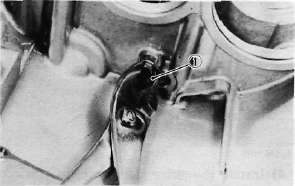
1. Lock washer
Tightening torque: 1.0 m-kg (7.2 ft-lb)
d. Put the starter clutch and sprocket assembly in the "HY-VO" chain and lay it into the crankcase.
e. Install the A.C.G. Generator shaft into the starter clutch assembly.
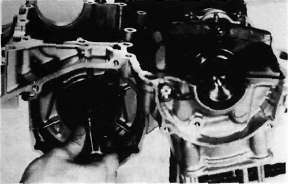
f. Install the "HY-VO" chain oil spray nozzle. The locating pin on the nozzle should be placed into the crankcase locating slot. Do not forget to install the new "O-ring" onto the nozzle.
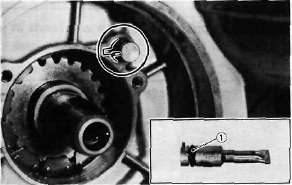
1. O-ring
g. Install the new "O-ring" onto the bearing housing and install it with the panhead screw. Torque to 1.0 m-kg (7.2 ft-lb).
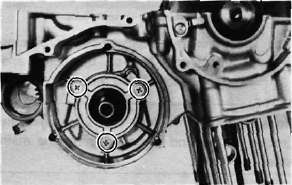
h. Install the transmission main axle assembly on the upper crankcase. Point the bearing locating pin toward the crankshaft and lav it on the case.
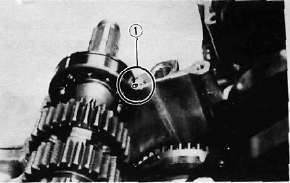
1. Bearing locating pin
i. Install the middle driven gear (without the middle drive pinion gear).
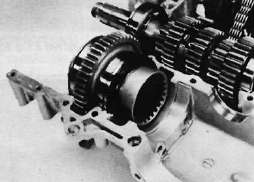
j. Install the middle driven gear shaft end bearing.
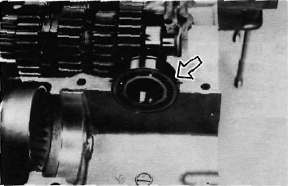
k. Install the dowel pin with "O-ring" into the crankcase.
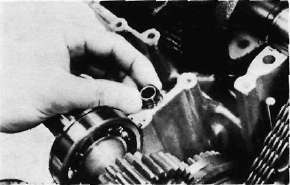
Lower Crankcase Reassembly
Lower Crankcase Reassembly1 a. Install the shift cam and secure it with the guide pin. Install the stopper plate and bolt and tighten securely.
b. Install the neutral switch. Torque to 2.0 m-kg (14 ft-lb).
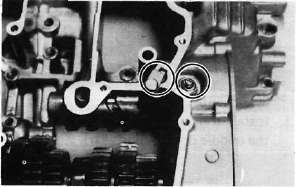
c. Install the transmission drive axle assembly into the crankcase.
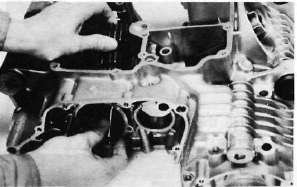
d. Install the 5th wheel gear and bearing onto the drive axle. Install the bearing cover. Be sure the "O-ring" is on the cover.
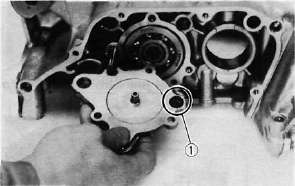
1. O-ring
e. Install the shift forks and guide bar. Each shift fork is identified by a number cast on its side. All the numbers should face the left side and numbered 1, 2, and 3 from left.
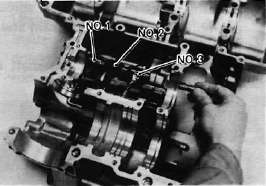
3. Crankcase assembly a. Apply Yamaha bond # 4 sealant or equivalent to the crankcase mating surface. Be very careful not to allow any sealant to come in contact with the oil gallery "O-ring" and crankshaft bearings. It is extremely important, however, that sealant be applied around the case stud holes. Apply sealant to within 2~3 mm (0.08 ~0.12 in) of the bearings. Do not allow sealant to come in contact with the oil galley O-ring or crankshaft bearings.
CAUTION:
Failure to apply sealant here will result in reduced oil pressure and possible crank seizure.
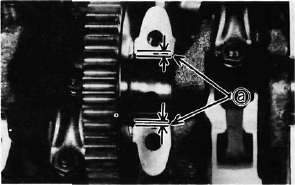
a. 2~3 mm (0.08~0.12 in) Do not apply sealant.
b. The crankcases are assembled by placing the upper case half on the bench and lowering the lower case onto it.
NOTE:
Be sure that shift fork No. 2 engages the groove in the 2nd pinion gear on the main axle.
CAUTION:
Before installing and torquing the crankcase bolts, check to make sure the transmission is functioning properly by shifting it by hand with the shift cam.
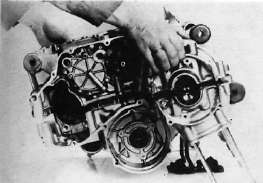
c. Start installation of the crankcase bolts with the center crankshaft area bolts. Place the two bolts without washers in the oil filter area.
d. The crankcase bolts should be torqued in proper sequence. Refer to the tightening sequence in the illustration.
LOWERCASE
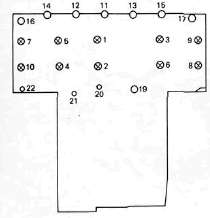
UPPERCASE
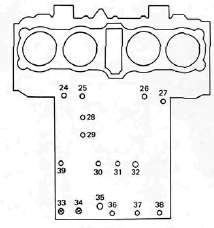

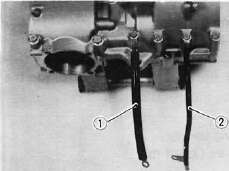
1. Engine ground wire 2. Battery ground wire
4. Oil pump and strainer cover
a. Place the oil pump drive chain on the transmission main axle.
b. Place the drive chain on the oil pump driven sprocket and install the pump on the crankcase. The "O-ring" should be installed properly.
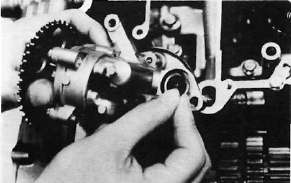
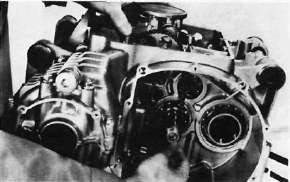
c. Install the drive chain cover on the oil pump and secure with the 2 shouldered bolts and one normal 6 mm bolt.
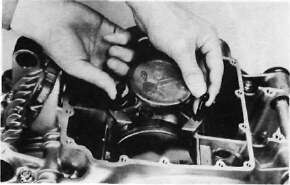
Tightening torque: 1.2 m-kg(8.7 ft-lb)
d. Install the strainer cover and torque the bolts to 1.2 m-kg(8.7 ft-lb)
e. Install oil pan (with wire clamps) and torque bolts to 1.2 m-kg(8.7 ft-lb)
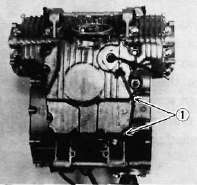
1. Wire clamps
Clutch Reassembly
Clutch Reassembly
Clutch assembly
a. Install the thrust plate onto the transmission main axle.
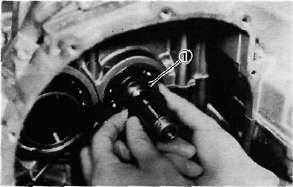
1. Thrust plate
b. Install the oil pump drive sprocket onto the main axle without the spacer collar and place the oil pump drive chain on its sprocket.
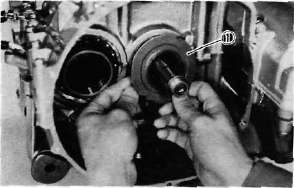
1. Oil pump drive sprocket
c. Insert the spacer collar into the oil pump drive sprocket.
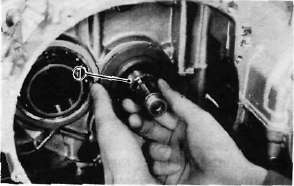
1. Spacer collar

(1)Bearing (2)Collar (3)Thrust plate (4)Clutch boss (5)Lock washer (6)Nut
d. Install the primary driven gear (clutch housing) without the bearing and inner spacer.
CAUTION:
Be sure that the oil pump drive gear tabs engage the clutch housing grooves on it's back or the tabs will be damaged when tightening the clutch boss securing nut.
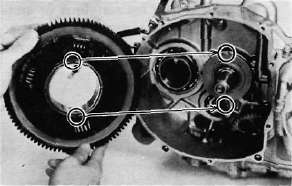
e. Installing the primary driven gear bearing and inner spacer into the clutch housing.
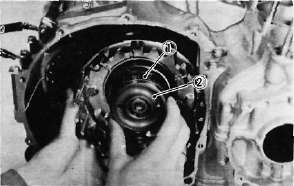
1. Driven gear bearing 2. Inner spacer
f. Install the large thrust plate and clutch boss onto the main axle.
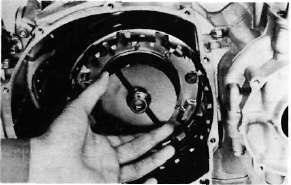
g. Install a new lock washer and nut and tighten the nut to the specified torque. Use the clutch boss holder (special tool).
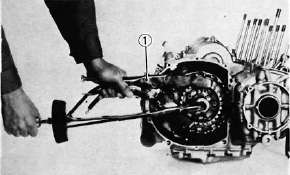
1. Clutch boss holder
Tightening torque: 7.0 m-kg (50 ft-lb)
h. Bend the lock washer tabs along the nut flats.
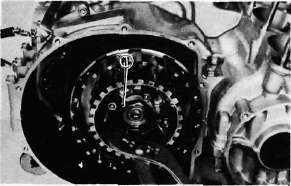
1. Lock tab
i. Install the clutch plates without V-cut in tab and friction plates alternately on the clutch boss, starting with a friction plate and ending with clutch plate. Install friction plate wth V-cut (1) last.
NOTE:
Install the friction plate so that the V-cut tab is in the identified dog that was marked during disassembly. If you forgot to identify the position with a mark, measure the width of each dog. The narrow dog is 13.8 mm (0.543 in). All others are 14 mm (0.551 in)

j. Install the plate washer, thrust bearing, and clutch pull rod into the clutch pressure plate from inside.
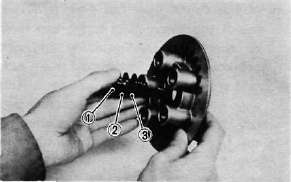
1. Pull rod 2. Thrust bearing 3. Plate washer
k. Install the pressure plate assembly onto the clutch boss.
NOTE:
Pressure plate has a dot on it which must line up with the dot on clutch boss.
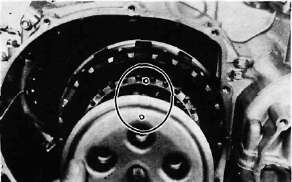
I. Install the clutch springs and screws. Tighten the screws.
Clutch screw torque: 0.8 m-kg (5.8 ft-lb)
m. Set the gear of the clutch pull rod on the pressure plate facing approximately 45° from horizontal toward the rear; set the clutch lever (if installed) on the right crankcase cover parallel to the gasket surface and install the cover to the crankcase. Do not forget to install two dowel pins.
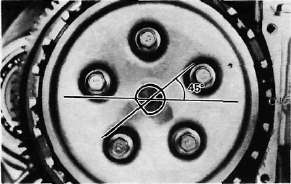
n. If the clutch lever has been removed, install the lever return spring and lever on the shaft after installing the right crankcase cover. In this case make sure that the punch mark on the lever should align with the mark on the crankcase cover when pushing the lever towards the front by hand and then install the circlip.
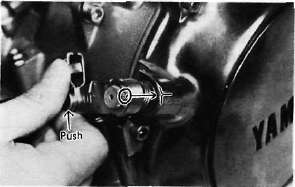
Middle Gear and Shifter Reassembly
Middle Gear and Shifter Reassembly6. Middle gear (installation only, refer to _tbd__ for the middle gear adjustment)
a. Install the middle drive gear assembly with the proper size of shim(s) and secure it with the bearing retainers and new "TORX" screws.
Tightening torque: 2.5 m-kg (18 ft-lb)
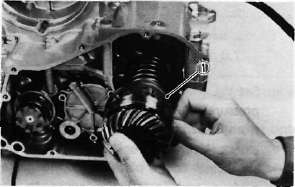
1. Shims
b. Stake the screw heads to the dents on the bearing retainers with a center punch.
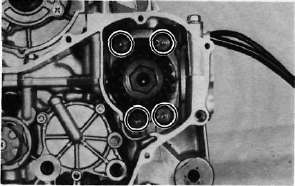
c. Install the driven gear assembly with the proper size of shims and secure it with the bolts. Apply a thread locking compound such as "LOCTITE" to the bolt threads,
Tightening torque:
2.5 m-kg (18.1 ft-lb)

1. Shims
d. Install the middle gear case half moon seal onto the crankcase.

1. Seal
7. Shifter assembly
a. Install the shift shaft assembly with the stopper lever.

b. Install the shift lever assembly with the positioning spring is properly located on the stopper pin and the teeth should be set properly as shown.

c. Install the left crankcase cover (shifter cover) using a new gasket. Make sure the wire harness clips are properly positioned.
Tightening torque: 1.0m-kg(7.2ft-lb)
Middle Gear Adjustment
Middle Gear Adjustment
C. Middle Gear Servicing
1. Disassembly
Refer to page 39 for disassembly.
2. Inspection
Refer to page 52 for inspection.
3. Gear lash check
NOTE:
The middle gear lash can be checked only when the gears are installed in the crankcase.
a. Install the middle drive pinion holder (special tool) on the crankcase to hold the drive gear stationary during the lash measurement.
NOTE:
Before installing the tool, loosen the holder bolt all the way out and after installation tighten this bolt as tight as necessary (finder tight is generally sufficient).

1. Middle drive pinion holder
b. Set the dial gauge to the middle drive flange as shown and gently rotate the drive flange back and forth. Note the lash measurement on the dial gauge.

Middle gear lash: 0.1 ~ 0.2mm(0.004~ 0.008 in)
c. Check this engagement at 4 positions. Rotate the drive flange 90° each time and repeat the gear lash check.
NOTE:
If the gear lash exceeds the specified limit and adjustment is necessary, the engine or swing arm should be removed from the motorcycle.
4. Gear lash adjustment
a. Install the driven gear housing assembly into the crankcase leaving about a 2 mm (0.080 in) gap between the housing and crankcase and install the two bolts to the bearing housing 180° opposite to each other.

a. 2 mm (0.080 in)
b. Install the middle drive shaft holder and dial gauge (refer to "Middle gear lash check").
c. Slowly tighten the bolts alternately until the dial gauge lash measurement reaches 0.2 mm (0.008 in).

d. Measure the gap between the driven gear bearing housing flange and the crankcase with a feeler gauge. This is the shim size required.

1. Feeler gauge
e. Install the proper sized shims as shown and tighten the driven gear housing to the specified torque.
Recheck the gear lash, it should be within the specification, if not readjust the shims.
Gear lash: 0.1 - 0.2 mm (0.004-0.008 in
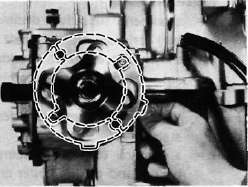
5. Drive gear positioning
NOTE:
When the following part(s) is replaced with new one(s), drive gear positioning is necessary
a. Crankcase
b. Middle gears
c. Middle gear bearing housing
a. Theshim thickness necessary for the drive gear positioning can be calculated from the information found on the upper crankcase and on the drive gear shaft.


b. To find shim thickness "A" use the formula:
A = c —a — b
Where:
a= a numeral (usually a decimal number) printed on the shaft end as shown above and either added to or subtracted from the nominal size "43".
b= a bearing thickness (considered constant)
c = a numeral (usually a decimal number) found on the upper crankcase half near the main bearing selection numbers and added to the nominal size "60".
Distance "b"^ 16.94 mm
Example:
1)lf the shaft is marked +03 ...... "a" is
43.03 mm.
2) "b" is 16.94mm.
3) If thecrankcase is stamped "45" ..... "c"
is 60.45 mm.
A = c — a —b
A = 60.45 -16.94-43.03
A = 0.48
Then the necessary shim thickness is 0.48 mm.
c. Shim size are supplied in the following thicknesses:
0.15 mm, 0.20 mm, 0.30 mm, 0.40 mm, and 0.50 mm.
Because the shims can only be selected in0.05 mm increments the following chart should be used when encountering last digits that are not 5 or zero (0):
|
Last digits |
Rounding |
|
0,1.2 |
0 |
|
3,4,5,6,7 |
5 |
|
8,9 |
10 |
Generator, Starter and Pick-up Coil Reassembly
Generator, Starter and Pick-up Coil Reassembly8. A.C. Generator
a. Install the rotor onto the shaft and tighten the bolt using the rotor holding tool (special tool) as shown.

1. Rotor holding tool
Tightening torque: 5.5 m-kg (39.8 ft-lb)
b. Install the stator coil assembly onto the crankcase and align the grooves on the stator core with the bolt holes on the crankcase.

c. Install the A.C.G. cover assembly and tighten the bolts to the specification. Do not forget to install the new gasket.
Tightening torque: 1.2 m-kg (8.4 ft-lb)
9. Starter motor
a. Route the A.C.G. lead wires as shown.
b. Install the starter motor and tighten the bolts to the specification.
Tightening torque: 0.7 m-kg (5.1 ft-lb)
NOTE:
Be careful the "O-ring" is not damaged when installing the starter motor.

1. O-ring 2. A.C.G. lead wires
10. Pick-up coil assembly
a. Install the pick-up coil assembly onto the crankcase.
b. Install the timing plate on the crankshaft and tighten the bolt to 0.8 m-kg (5.1 ft-lb)
NOTE:
Note that there is the locating pin on the crankshaft and the corresponding slot in the timing plate which must be aligned to install the timing plate.
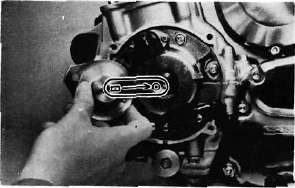
Pistons and Cylinder Reassembly
Pistons and Cylinder ReassemblyPistons and Cylinder
a. Install the piston rings onto the pistons. Manufacturer's marks or numbers are located on the top side of the rings.
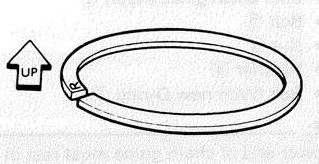
Install the pistons on the rods. Always use new piston pin clips (1). The arrow on the piston (2) must point to the front of the engine.

NOTE:
Before installing the piston pin clips, cover the crankcase with a clean rag so you will not accidentally drop the circlip into the crankcase. Always install new piston pin circlips.
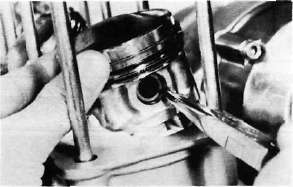
b. Install the rear chain guide on its pivot. Tighten the holding bolt until it stops and then loosen 1/4 turn and then tighten the lock nut.
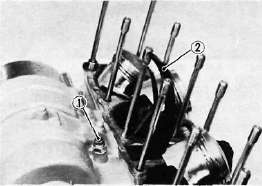
1. Holding bolt 2. Rear chain guide
c. Install the new cylinder base gasket and dowel pins. Install the new "O-rings" to the right side dowei pins.
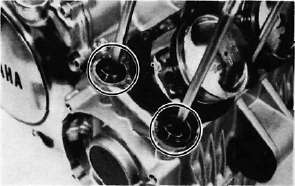
d. Set the crankshaft so that the all pistons are equal height and align the piston rings as shown.
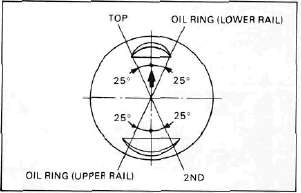
CAUTION:
Make sure the ends of the oil ring expanders are not overlapped.
NOTE:
Manufacturer's marks or numbers stamped on the rings are on the top side of the rings. Coat the pistons and rings well with oil.
e. Install the piston ring compressors (special tool) and piston bases (special tool). Four piston bases are required.
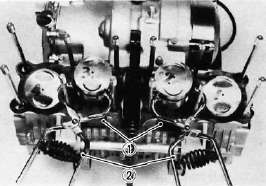
1. Piston bases 2. Piston ring compressors
f. Tie the cam chain with a piece of mechanic's wire and feed it through the chain opening. Carefully lower the cylinder onto the pistons. Remove the ring compressors and piston bases and repeat this procedure for pistons 1 and 4.
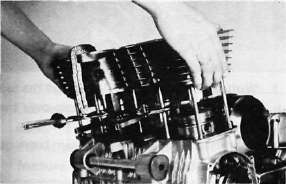
g. Install the cylinder securing nut (front side) and tighten it to the specification.
Tightening torque: 2.0 m-kg (14.5 ft-lb)
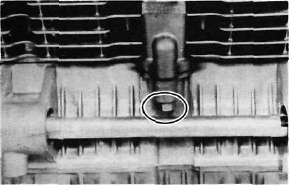
h. Set the dial gauge on the No. 1 piston head center as shown to find the No. 1 piston top dead center and check whether the "1" mark on the timing plate and stationary pointer are aligned or not. If not, loosen the pointer securing screw and adjust.
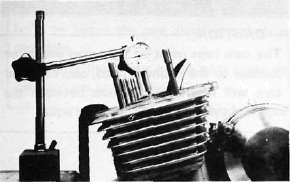
Cylinder Head and Camshaft Reassembly
Cylinder Head and Camshaft ReassemblyCylinder head and Cam shafts
a. Install the new cylinder head gasket. Install the dowel pins and "O-rings". Locate the cam chain cavity cylinder seal with the tabs down.

b. Install the cylinder head onto the cylinder. Pull the cam chain through the cylinder head as it is installed. Tie the cam chain so that it does not fall into the crankcase.

c. Place the upper cylinder head nuts and washers in place. Follow the illustration for the proper tightening sequence. Torque all nuts in two stages and final torque the upper nuts to the specification.
Tightening torque: 3.5 m-kg (25 ft-lb)
Don't forget the lower nuts on the front and rear of the cylinder head. Torque to the specification.
Tightening torque: 2.0 m-kg (14.5 ft-lb)
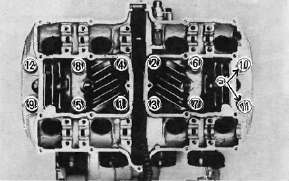
a. Copper washers
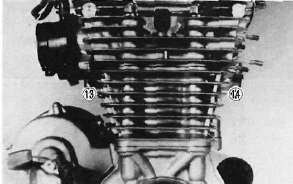
NOTE:
Tighten the nuts in two stages, 1/2 torque value and then full torque value. Also lubricate the bolt threads with the engine oil to achieve proper torque values.
d. Install the front cam chain guide being certain that the lower end is resting in the cam chain guide slot in the crankcase down below.
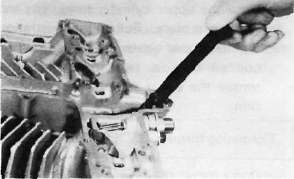
Cam chain sprockets installing steps:
• Align the "T" mark on the timing plate (1) with the stationary pointer on the pickup coil (2). Do not turn the crankshaft when installing the sprockets.

• Place the cam chain onto the exhaust sprocket (3).
• Install the sprockets and finger tighten the sprocket bolts.
• Rotate the exhaust camshaft to align the punched mark on the camshaft (4) with the arrow on the center cam cap (5).

• Force the exhaust camshaft clockwise to remove the cam chain slack.
• Place the cam chain onto the intake sprocket.
• Install the sprocket and finger tighten the sprocket bolt.
• Rotate the intake camshaft to align the punched mark on the camshaft with the arrow on the center cam cap.
• Force the intake camshaft clockwise to remove all the cam chain slack.

• Insert your finger into the cam chain tensioner hole, and push the cam chain guide inward (6)
• While pushing the cam chain guide, be sure camshaft timing marks align with the cap holes.
• Remove the intake sprocket if marks do not align.
• Change the meshing position of sprocket and cam chain.
• Install the center cam chain guide.

Cam chain tensioner installation steps:
• Remove the tensioner end cap bolt and spring.
• Release the cam chain tensioner one-way cam (1) and push the tensioner rod into the tensioner body.

• Install the tensioner with a new gasket onto the cylinder.
Torque to 1.2 m-kg (8.4 ft-lb)
• Install the tensioner springs and end cap bolt (1). Tighten the bolt to 0.9 m-kg (6.5 ft-lb)

• Turn the crankshaft and install the sprocket securing bolts.
• Tighten the sprocket bolts to 2.0 m-kg (14 ft-lb)
CAUTION:
Be sure to attain the specified torque value to avoid the possibility of these bolts coming loose and causing damage to the engine.

3. Apply engine oil to the cam chain, sprockets, camshafts, and valves.
4. Turn the crankshaft counterclockwise a few turns to ensure that it turns smoothly.
CAUTION:
Be sure the exhaust and intake camshaft marks are aligned with the cam cap marks.
5. Measure:
• Valve clearance
Adjust to specification as described in under Valve Clearance Adjustments:
IN: 0.11 ~ 0.15mm (0.0043 ~ 0.0059 in)
EX: 0.16-0.20 mm (0.0063 ~ 0.0079 in)

6. Install:
Cylinder Head Cover: 1.0 m-kg (7.2ft-lb)
Spark Plug: 20 Nm (2.0 nvkg, 14 ft-lb)

7. Install:
• Gasket
Crankshaft End Cover (Left): 0.7 m-kg, 5.1 ft-lb)
Remounting the Engine
Remounting the EngineREMOUNTING ENGINE
1. Refer to engine removal. Reverse those removal steps that apply.
2. Tighten:
• Engine mount bolts
Engine Mounting Bolt:
Front, upper: 4.2 m-kg (30 ft-lb)
Rear: 9.0 m-kg (65 ft-lb)
Down tube: 3.8 m-kg (27 ft-lb)

3. Connect:
• Pickup coil lead
• Generator lead
• Neutral switch lead
• Oil level switch lead
• Starter motor lead
• Crankcase ventilation hose
• Battery leads
• See CHAPTER 7 "Cable Routing" for proper cable, lead, and hose routing.
• Connect the battery positive lead first.
• Make sure that the cables are not twisted.
• Be careful not to pinch the leads.
4. Install:
• Carburetors
5. Connect:
• Throttle cable
• Choke cable
6. Tighten:
• Air cleaner case mount bolts 1.0 m-kg, (7.2 ft-lb)
7. Install:
• Fuel tank
• Seat
8. Add:
• Engine oil
3.5 L (3.08 Imp qt, 3.70 US qt)
Chapter 4, CARBURETION & AIR FLOW
Chapter 4, CARBURETION & AIR FLOWCARBURETOR

(1) Piston valve spring
(2)Starter plunger assembly
(3) Upper bracket
(4) O-ring
(5) Lower bracket
(6) Throttle stop screw
(7) Synchronizing screw
(8) Washer
(9) Main jet
(10) Valve seat assembly
(11) Float
(12)Gasket
(13) Drain screw
(14) Float chamber
(15) Pilot jet
(16) Needle jet
(17) Piston valve
(18) Diaphragm
(19) Jet needle assembly
|
SPECIFICATIONS |
|
|
Main jet |
# 107 |
|
Main air jet |
# 70 |
|
Jet needle |
Y-20 |
|
Needle jet |
Ø 3.22 |
|
Pilot jet |
# 36.5 |
|
Pilot air jet |
# 210 |
|
Fuel level |
1.0 ± 1.0 mm (0.039 ±0.039 in) |
|
Float height |
16.0± 1.0 mm (0.630 ± 0.039 in) |
|
Pilot screw |
Preset |
|
Float valve seat |
Ø2.0 |
|
Engine idle speed |
1,050 ±50 rpm |
Special tools:
|
A |
VACUUM GAUGE: |
|
P/No. YU-08030 |
|
|
B |
FUEL LEVEL GAUGE: |
|
P/No. YM-01312 |
SECTION VIEW
MAIN METERING SYSTEM
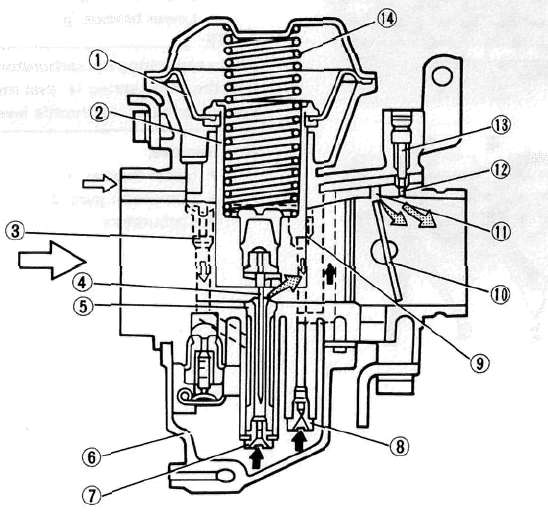
(1) Diaphragm
(2) Piston valve
(3) Main air jet
(4) Jet needle
(5) Needle jet
(6) Float chamber
(6) Main jet
(7) Pilot jet
(9) Pilot air jet
(10) Throttle valve
(11) By-pass hole .
(12) Pilot outlet
(13) Pilot screw
(14) Spring
|
A |
|
AIR |
|
B |
|
MIXTURE |
|
C |
|
FUEL |
CARBURETOR OVERHAUL
REMOVAL
1. Remove Carburetor assembly (Refer to engine removal section.)
NOTE:
The following parts can be cleaned and inspected without disassembly.
• Piston valve
• Jet needle
2. Disconnect the drain hoses, fuel hoses and throttle cable
3. Number each carburetor before removing it from carburetor brackets.
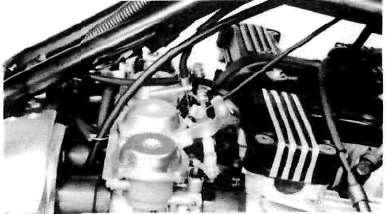
4. Loosen starter lever screws
5. Remove starter lever shaft (1), starter lever (2) and Lower bracket (3)
NOTE:
When separating the carburetors be sure not to lose the small spring (4) that may fall out. This spring connects the throttle levers.
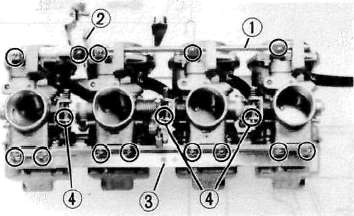
6. Remove the upper bracket (1), carburetor joint (2) and carburetors
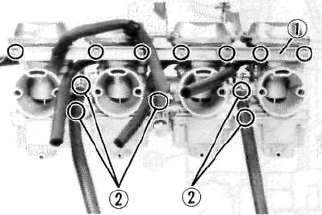
DISASSEMBLY
1. Remove the vacuum chamber cover (1), spring (2), vacuum piston (3) and jet needle (4)
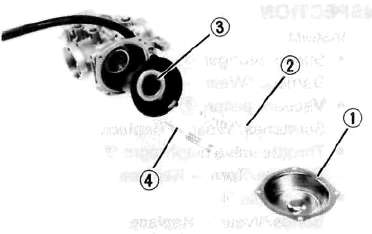
2. Remove the starter plungers (1)
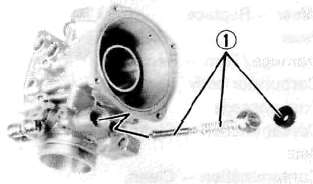
3. Remove float chamber cover, Float pin (1), float(2) and Needle valve (3)
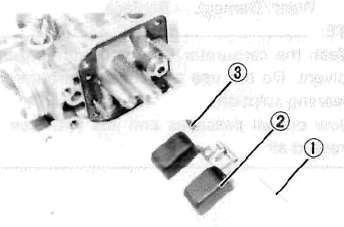
4. Remove the Valve seat (1), Pilot jet (2), Main jet (3) and Needle jet (4)
NOTE:
Remove the needle jet toward the vacuum piston.
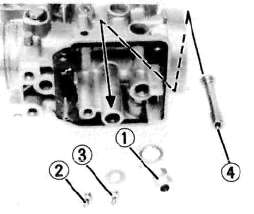
INSPECTION
1. Inspect:
• Starter plunger (1) for wear
• Vacuum piston (2) for wear
• Throttle valve diaphragm (3) for tears
• Jet needle (4) for bends and/or wear
• Needle valve and valve seat (5) for wear.
• Float for cracks or other damage.
• Carburetor body
• Fuel passage for contamination — Clean with carburetor cleaner
• Jets for contamination — Clean with carburetor cleaner.
• O-rings (Carburetor joint) (6) for wear, nicks, compression or other damage
Replace all damaged and worn components. .
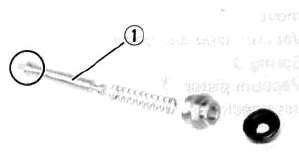
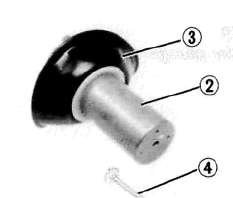
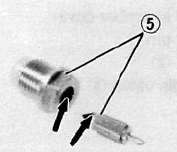
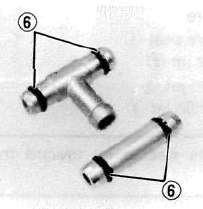
NOTE:
• Wash the carburetor in a petroleum-based solvent. Do not use any caustic carburetor cleaning solutions.
• Blow out all passages and jets with compressed air.
FLOAT HEIGHT ADJUSTMENT
This is a preliminary step to approximate the correct float setting following reassembly It does not replace the need to set the fuel height as described bylow.
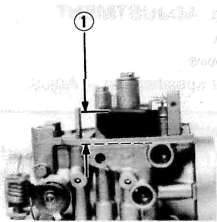
Float height measurement steps:
• Hold the carburetor in an upside down position.
• Incline the carburetor at 60 — 70° (so that the end of the float valve does not hang down as a result of float weight)
• Measure the distance from the mating surface of the float chamber (gasket removed) to the top of the float.
NOTE:
The float should be just resting on, but not depressing, the spring loaded inlet needle.
Float Height:
16.0+1.0 mm (0.630±0.039 in)
Float height adjustment step:
• Remove the float.
• Adjust float height by bending the float tang (1) slightly.
• Repeat the procedure for other carburetors.
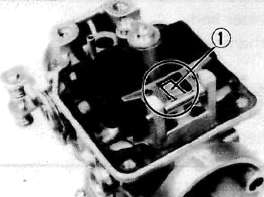
FUEL LEVEL ADJUSTMENT
This is the final step in setting the floats, performed after the carburetors have been reassembled and offering greater precision than described above.
Measurement steps (carburetors installed on motorcycle):
• Place the motorcycle on a level surface.
• Use a garage jack under the engine to ensure that the carburetor is positioned vertically.
• Connect the Fuel Level Gauge (1) (YM-01312) to the drain nozzle (2).
• Loosen the drain screw (3) and start the engine.
• Check the fuel level, one carburetor at a time.
Measurement steps (carburetors not installed)
• Use a jig, vise, "Workmate" style bench or similar device to hold the carburetor bank vertically
• Place a level across the tops of the carbs to ensure the bank is level side to side.
• Use a remote fuel supply with inline shut-off valve positioned just above the carb bank to supply fuel.
• Connect the Fuel Level Gauge (1) (YM-01312) to the drain nozzle (2).
• Loosen the drain screw (3).
• Check the fuel level, one carburetor at a time.
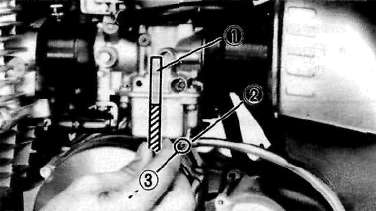
Fuel Level: (a), below the carburetor body
1.0 ± 1.0 mm (0.039 ± 0.039 in)
(4) Float chamber (5) Carburetor body
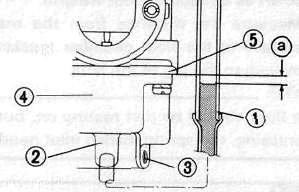
Adjustment steps:
• Remove the carburetors if necessary. Drain. Remove the float bowl.
• Adjust float level by bending the float tang (1) slightly.
• Repeat the procedure for the other carburetors.
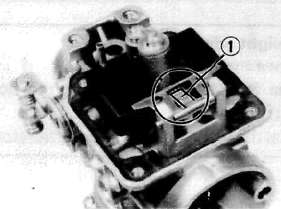
AIR CLEANER AND CRANKCASE VENTILATIONS SYSTEM
Refer to "CHAPTER 2" for air cleaner maintenance.
(1) Air cleaner (2) Carburetor
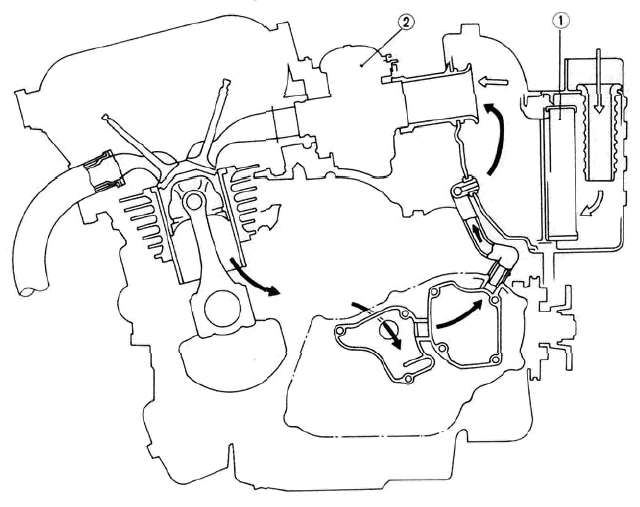
|
A |
|
FRESH AIR |
|
B |
|
BLOW BY GAS |
Chapter 5, CHASSIS
Chapter 5, CHASSISWheels
WheelsFRONT WHEEL
|
Basic weight: With oil and full fuel tank |
224 kg (493 lb) |
|
|
Maximum load* |
246 kg 543 lb) |
|
|
Cold tire pressure |
Front |
Rear |
|
Up to 90 kg {198 lb) load* |
177 kPa |
196 kPa |
|
90 kg {198 lb) -Maximum load* |
196 kPa |
274 kPa |
|
High speed riding |
206 kPa |
225 kPa |
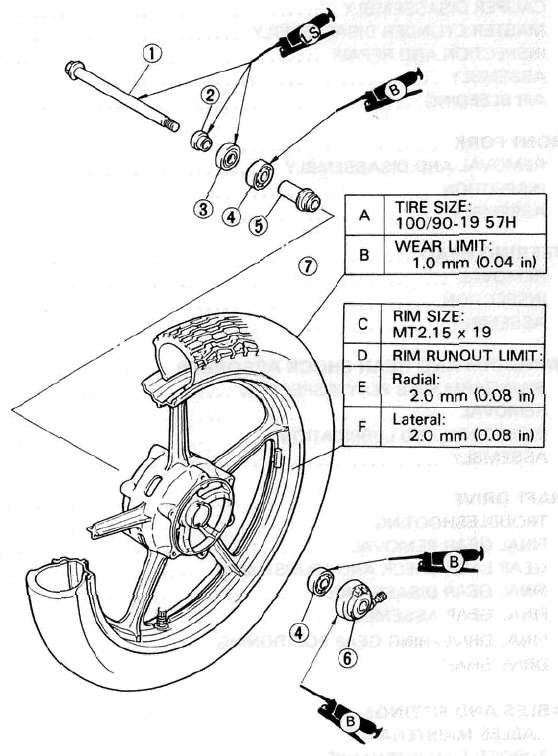
(1) Wheel axle
(2) Collar
(3) Oil seal
(4) Bearing
(5) Spacer
(6) Speedometer gear unit
(7) Tire
REMOVAL
1. Place the motorcycle on its centerstand and a garage jack under the engine.
2. Remove the speedometer cable and caliper (1) from front fork
3. Loosen pinch bolt (2)
4. Remove axle (3) to release front wheel from forks

CAUTION:
Make sure the motorcycle is properly supported.
NOTE:
Do not depress the brake lever when the wheel is off the motorcycle otherwise the brake pads will be forced shut.
INSPECTION
1. Inspect: tire tread. If "Wear bars" show crosswise lines, indicatiing minimum tread depth or if there are excessive cracks the tire should be replaced.
Minimum Tire Tread Depth 1.0 mm (0.04 in)


(1) Tread depth
(2) Sidewall
(3) Wear indicator
2. Inspect the front axle by rolling the axle on a flat surface (1). Replace if bent

Warning:
Do not attempt to straighten a bent axle.
3. Inspect the front wheel for Cracks/Bends/Warpage. Replace if damaged
4. Measure wheel runout
Out of specification — Replace wheel or check bearings.

Rim Run-Out Limits:
Radial (1) : 2 mm (0.079 in) Lateral (2) : 2 mm (0.079 in)

(3) Bearing play
5. Check wheel balance.
Wheel is not statically balanced if it comes to rest at the same point after several light rotations. — Install appropriate balance weight at lightest point (on top).
NOTE:
• Balance wheel with brake disc installed.

• After mounting a tire, ride conservatively to allow proper tire to rim seating. Failure to do so may cause an accident resulting in motorcycle damage and possible operator injury.
• After a tire repair or replacement, be sure to torque tighten the valve stem locknut (1) to specification.

Valve-Stem Locknut:
1.5 Nm (0.15 m-kg, 1.1 ft-lb)
WHEEL BEARING REPLACEMENT
1. Inspect wheel bearings. If the wheel hub exhibits play or the wheel turns roughly, replace the bearings.
Wheel bearing replacement steps:
• Clean wheel hub exterior.
• Drive bearing out by pushing spacer aside and tapping around perimeter of bearing inner race. Use soft metal drift punch and hammer. The spacer (1) "floats" between bearings. Remove both bearings as described.
Eye protection is recommended when using striking tools.

• To install the wheel bearing, reverse the above sequence. Use a socket fit that matches outside diameter of bearing outer race to drive in bearing.
CAUTION:
Do not strike the center race or balls of bearing. Contact should be made only with the outer race.

INSTALLATION
1. Reverse removal procedure.
Note the following installation points:
• Lightly grease the front wheel oil seal lips and the gear teeth of the speedometer drive and driven gears.
(Use lightweight, lithium base grease.)
• Be sure that the two projections (1) inside the wheel hub mesh with the two slots in the speedometer clutch assembly.

• Be sure that the projecting portion (2) (torque stopper) of the speedometer housing is positioned correctly.

• Compress the front forks several times to confirm proper fork operation before tightening the pinch bolt.
Axle:
105 Nm (10.5 m-kg. 75 ft-lb)
Axle Pinch Bolt:
20 Nm (2.0 m-kg, 14 ft-lb)
Caliper:
35 Nm (3.5 m-kg, 25 ft-lb)
Rear Wheel

A. Removal
1. Place the motorcycle on the center stand.
2. Remove the tension bar and the brake rod from the brake shoe plate. The tension bar can be removed by removing the cotter pin and nut from the tension bar bolt. The brake rod can be removed by removing the adjuster.
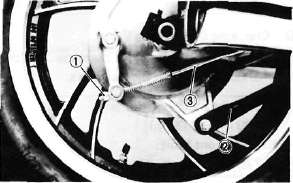
1. Adjuster 2. Tension bar 3. Brake rod
3. Remove the axle nut cotter pin and axle nut.
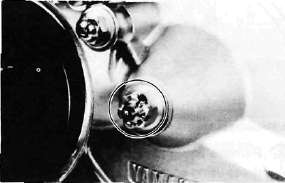
4. Loosen the rear axle pinch bolt and pull out the rear axle.
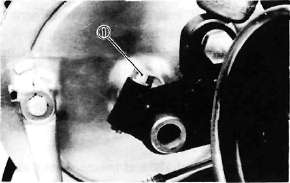
1. Pinch bolt
5. Move the wheel to the right side to separate it from the final gear cases and remove the rear wheel.
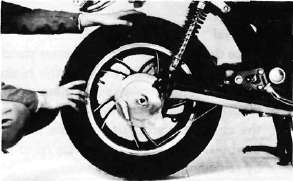
E. Rear Axle Inspection
(See Front Wheel, Axle Inspection Procedure.)
F. Replacing Wheel Bearings
Rear wheel bearing replacement is similar to the procedure for the front wheel.
G. Rear Wheel Inspection
(See Front Wheel, Inspection Procedures)
H. Installing Rear Wheel
1. Lightly grease lips of rear wheel oil seals.
2. Install the wheel assembly and axle.
NOTE:
When installing the rear wheel, be sure the splines on the wheel hub fit into the final gear case. Lightly apply grease to the gear teeth.
Always use a new cotter pin on the axle nut.
Tightening torque:
Axle nut: 10.5 m-kg (75 ft-lb)
Axle pinch bolt: 2 m-kg (14 ft-lb)
Brakes
BrakesINSPECTION
Brake Shoe
1. Measure brake shoes friction material thickness (1) with calipers. Replace if below limit.

Brake Shoe Thickness 4 mm (0.16 in)
Replacement Limit: 2 mm (0.08 in)
2. Inspect: Brake shoes. Sand glazed parts with coarse sandpaper.
Brake Drum
1. Inspect the brake drum Inner surface. Wipe off any oil with rag soaked in lacquer thinner or solvent. Polish brake drum lightly and evenly with emery cloth to remove scratches if necessary.
Brake Shoe Plate
1. Remove camshaft and inspect cam face. Replace if worn. Grease camshaft with high temperature brake grease..
NOTE:
Place alignment marks (1) on the cam lever and camshaft when disassembling.
2. Adjust rear brake free play. Turn adjuster (1) as needed.
|
Adjuster |
Rear Brake Free Play |
|
Turn clockwise |
to reduce |
|
Turn counterclockwise |
to increase |
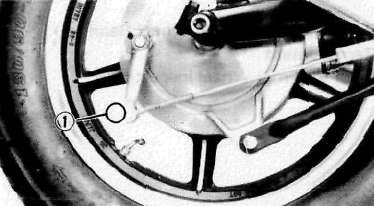
3. Adjust: rear brake light switch (1)
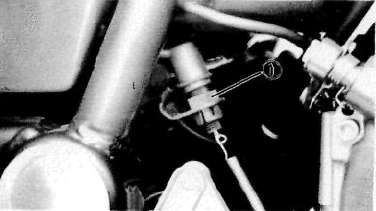
FRONT BRAKE
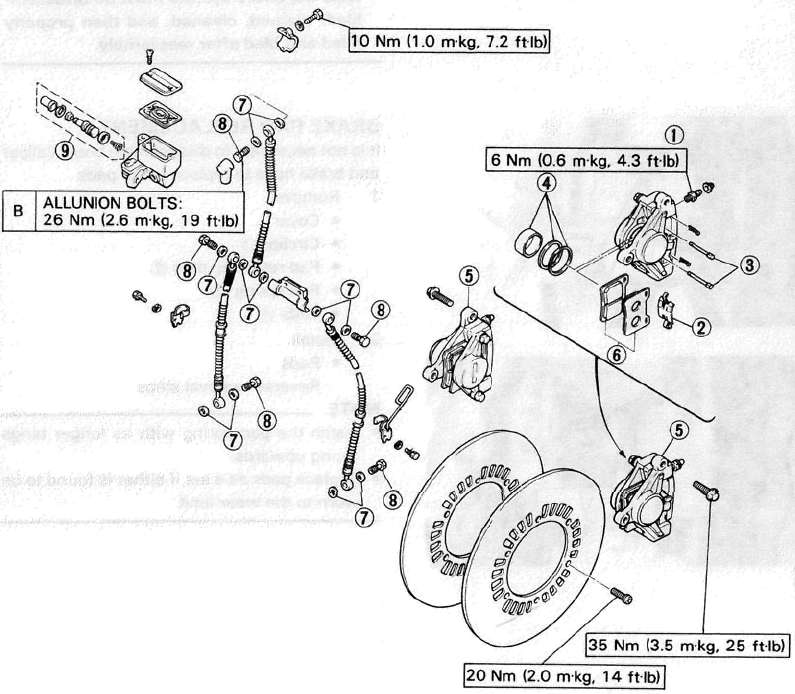
(1) Bleed screw
(2) Pad spring
(3) Pad retaining pin
(4) Caliper piston assembly (Replace as a set)
(5) Caliper
(6) Brake pads (Replace as a set)
(7) Copper washer
(8) Union bolt
(9) Master cylinder kit (Replace as a set)
PAD SPRING
'Install the pad spring with its longer tangs facing upwards.
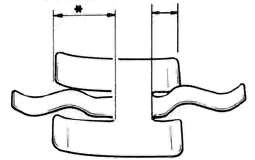
|
c |
PAD THICKNESS: Std.: 5.5 mm (0.217 in) |
|
D |
WEAR LIMIT: 0.5 mm (0.0197 in) |
CAUTION:
Disc brake components rarely require disassembly. Do not:
• Disassembe components unless absolutely necessary.
• Use solvents on internal brake component.
• Use contaminated brake fluid for cleaning. Use only clean brake fluid.
• Allow brake fluid to come in contact with the eyes otherwise eye injury may occur.
• Allow brake fluid to contact painted surfaces or plastic parts otherwise damage may occur.
• Disconnect any hydraulic connection otherwise the entire system must be disassembled, drained, cleaned, and then properly filled and bled after reassembly.
BRAKE PAD REPLACEMENT
It is not necessary to disassemble brake caliper and brake hose to replace brake pads.
1. Remove:
• Cover
• Circlips (1)
• Pad retaining pins (2)
• Pad spring (3)
• Pads (4)
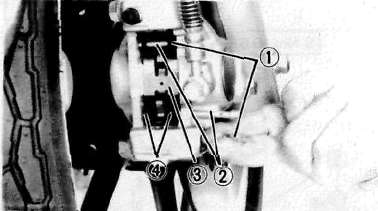
2. Install Pads by reversing removal steps.
NOTE:
• Install the pad spring with its longer tangs facing upwards.
• Replace pads as a set if either is found to be worn to the wear limit.
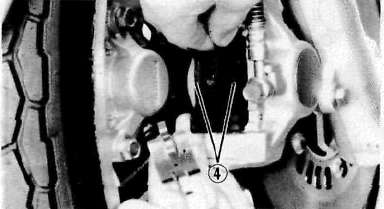
CALIPER DISASSEMBLY
1. Remove:
• Brake hose (1)
• Caliper securing bolts (2)
• Brake pads
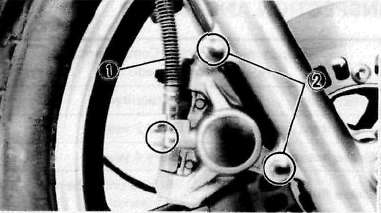
2. Remove:
• Caliper piston assembly
Use compressed air and proceed carefully.
Caliper piston removal steps:
• Using a rag, lock the right side piston.
• Blow compressed air into the hose joint opening to force out the left side piston from the caliper body.
• Remove the dust and piston seals and reinstall the piston.
• Repeat previous step to force out the right side piston from the caliper body.
DO NOT LOOSEN bolts [A]
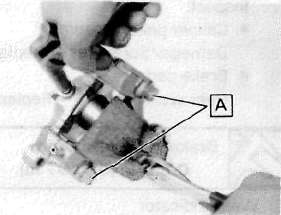
• Cover piston with rag and use extreme caution when expelling piston from cylinder.
• Never attempt to pry out piston.
MASTER CYLINDER DISASSEMBLY
1. Remove brake light switch (1). Push (2) the brake light switch stopper.
Remove brake hose (3), brake lever (4) and spring then master cylinder assembly (5)
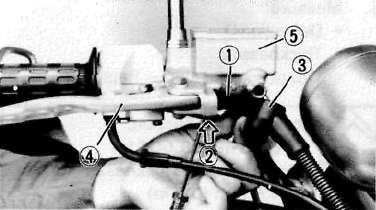
2. Remove cap (1). Drain remaining fluid. Remove master cylinder dust boot (2), circlip (3) and master cylinder cup assembly.
NOTE:
Be sure to reinstall the larger diameter lips of the cylinder cups first.
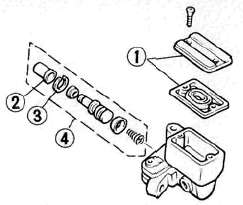
(4) Master cylinder kit
INSPECTION AND REPAIR
|
Recommended Brake Component Replacement Schedule |
|
|
Brake pads |
As required |
|
Piston seal, dust seal |
Every 2 years |
|
Brake hoses |
Every 4 years |
|
Brake fluid |
Replace only when brakes disassembled |
1. Inspect caliper piston assembly for scratches. Replace.if damaged. Inspect brake pad. Replace as a set if under wear limit (1).
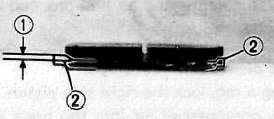
Brake Pad Wear Limit: 0.5 mm (0.0197 in)
(2) Wear indicator
2. Inspect master cylinder body for scratches — Replace if damaged.
Clean all passages with new brake fluid.
Inspect all Brake hoses for Cracks/Frayed/Damage/Over four years old — Replace as necessary.
3. Measure rotors for deflection (1) and thickness (2). Replace if out of specification.
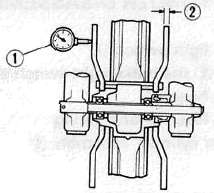
Maximum Deflection: 0.15 mm (0.006 in)
Minimum Disc Thickness: 4.5 mm (0.2 in)
ASSEMBLY
Caliper
NOTE:
• All internal parts should be cleaned in new brake fluid only.
• Internal parts should be lubricated with brake fluid when installed.
• Replace the piston and dust seals whenever the caliper is disassembled.
1. Install piston seal (1), dust seal (2), piston (3), pad spring (4), brake pads (5) into caliper assembly. Assemble caliper assembly to forks.
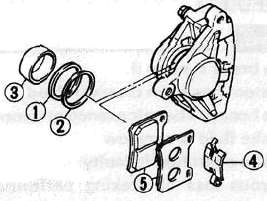
2. Tighten caliper securing bolts (1). Torque to 35 Nm(3.5 m-kg, 25 ft lb)
• Brake hose union bolt (2). Torque to 26 Nm (2.6 m-kg, 19 ft-lb)
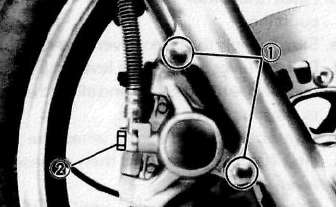
3. Bleed the air completely (see below)
Master Cylinder
1. Install master cylinder kit into master cylinder. Assemble master cylinder to handlebar and brake line to master cylinder. Torque Union Bolt (1) to 26 Nm (2.6 m-kg, 19 ft-lb).
Torque Master Cylinder Holding Bolt (2) to 10 Nm (1.0 m-kg, 7.2 ft-lb)
2. Bleed the air completely.
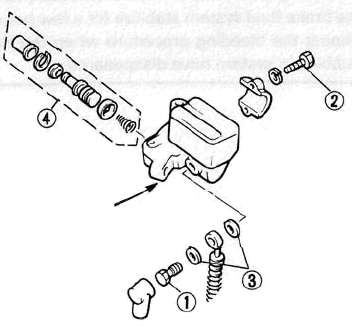
(3) Copper washer (4) Master cylinder kit
AIR BLEEDING
Bleed the brake system if:
• The system has been disassembled.
• A brake hose has been loosened or removed.
• The brake fluid is very low.
• The brake operation is faulty.
Warning:
A dangerous loss of braking performance may occur if the brake system is not properly bled.
Air bleeding steps:
a. Add proper brake fluid to the reservoir.
b. Install diaphragm. Be careful not to spill any fluid or allow the reservoir to overflow.
c. Connect the clear plastic tube (1) (4.5 mm, 3/16 in inside dia.) tightly to the caliper bleed screw (2).
d. Place the other end of the tube into a container.
e. Slowly apply the brake lever several times.
f. Pull the lever in. Hold the lever in position.
g. Loosen the bleed screw and allow the lever to travel towards its limit.
h. Tighten the bleed screw when the lever limit has been reached; then release the lever.
i. Repeat steps e to huntil of the air bubbles have been removed from the system.
NOTE:
It can be difficult to force air bubbles downwards to the bleeder. It may be necessary to secure the brake lever to the handlebar in the fully operated position and allow it to sit for a few hours or overnight so bubbles can stabilize, rise up and escape into the reservoir.
Alternatively: connect clear plastic tube (1) to vacuum bleeder and draw fluid down by vacuum.
Take care not to allow reservoir to empty during the bleeding process.
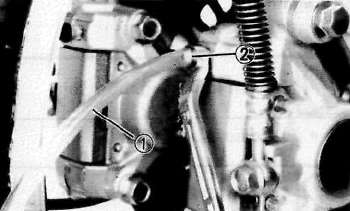
Front Fork
Front ForkFRONT FORK

1 Cap
2 Cap bolt
3 O-ring
4 Spacer
5 Spring seat
6 Fork spring
7 Damper rod
8 Inner fork tube
9 Taper spindle
10 Dust seal cover
11 Dust seal
12 Circlip
13 Fork seal
14 Washer
15 Guide bushing
16 Outer fork tube
17 Damper rod securing screw
REMOVAL AND DISASSEMBLY

WARNING:
Support the motorcycle securely so there is no damage of it falling over.
1. Loosen:
• Inner tube pinch bolt 1
• Cap bolt 2
Use Front Fork Cap Socket (YM-01104) 3

2. Remove:
• Brake caliper 1
• Front wheel 2
• Fork brace 3
3. Loosen:
• Lower front fork pinch bolts 4
CAUTION:
Support the fork before loosening the pinch bolts.

4. Remove:
• Front fork assembly (from the underbracket)
• Cap bolt 1
• Spacer 2
• Spring seat 3
• Dust seal cover 4
• Dust seal 5
• Circlip 6
5. Fill:
• Fork inner tube 7 (with fork oil)
. Stretch the inner tube before filling.
6. Install:
• Cap bolt 1

7. Remove:
• Oil seal (from outer tube).
Press the inner tube to facilitate removal.
CAUTION:
• If air enters the inner tube or it is compressed abruptly oil may spurt out or the coil seal may be ejected.
• Never touch the inner tube during a disassembly operation.
• Be sure to wrap the oil seal with a rag for safety.
Wrap with rag Spacer. Turn slowly
8. Remove:
• Oil seal
• Washer
• Cap bolt
• Fork spring
9. Drain:
• Fork

10. Remove:
• Damper rod securing bolt. Use T-handle (YM-01326) and Damper Rod Holder (YM-01365) to remove the damper rod.

11. Remove:
• Damper rod
• Damper rod spring
• Inner fork tube
• Guide bushing (from outer tube)
• Taper spindle
1 Pull inner tube from outer tube.
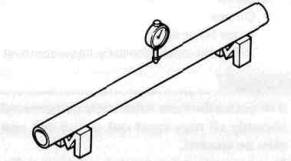
INSPECTION
1. Inspect:
• Inner fork tube for severe scratches, bends. Inspect for damaged oil lock valve — Replace damaged components.
WARNING:
Do not attempt to straighten a bent fork tube as this may dangerously weaken the tube.
2. Inspect:
• Outer fork tube for bends. Inspect fork seal seat for damage. Replace damaged components.

3. Inspect:
• Spring (Free length) 1
Out of specification — Replace.
Fork Spring Free Length Limit: 515 mm (20.3 in)

4, Inspect:
• Damper rod for worn damper rod seal 1. Replace as necessary. Check for contamination — Wash and blow out all passages.
• Slide bushing 2 for wear. Replace as necessary.
• Cap bolt 0-ring 3 for damage — Replace as necessary.
ASSEMBLY
NOTE:
Be sure all components are clean before assembly.

1 Cap
2 O-ring
3 Cap bolt
4 Spacer
5 Spring seat
6 Fork spring
7 Dust seal cover
8 Dust seal
9 Circlip
10 Fork oil seal
11 Washer
12 Guide bushing
13 Damper rod securing bolt
14 Outer fork tube
15 Taper spindle
16 Inner fork tube
17 Damper rod
18 Damper rod spring
1. Install:
• Damper rod spring
• Damper rod
Allow rod to slide slowly down the inner fork tube until it protrudes from the bottom.
• Taper spindle
• Inner fork tube

2. Install:
• Damper rod securing bolt
Hold damper rod with Damper Rod Holder (YM-01365) and T-handle(YM-01326)
Damper Rod Securing Bolt:
30 Nm (3.0 mkg, 22 ft- lb) LOCTITE® Stud N'Bearing Mount (red)
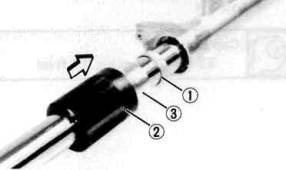
3. Install:
• Guide bushing 1
Press guide bushing into the outer fork tube with Fork Seal Driver (YM-33963) 2 and Adapter (YM-1372) 3.

4. install:
• Washer 1
• Fork oil seal (New) 2
Press fork oil seal into the outer fork tube with Fork Seal Driver (YM-33963) 3 and Adapter (YM-1372) 4.
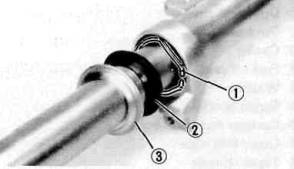
5. Install:
• Circlip 1
• Dust seal 2
• Dust cover 3
6. Fill with fork oil.
Capacity: 383 cm3 (13.5 Imp oz, 12.95 US oz)
Type: YAMAHA Fork & Shock Oil 10WT or equivalent fork oil
7. Install (into the inner fork):
• Fork spring
• Spring seat
• Spacer
• Cap bolt
8. Install:
• Front fork assembly (into the underbracket)
9. Tighten:
• Front fork pinch bolts (Lower).
• Cap bolt
Cap Bolt: 23Nm(2.3mkg, 17ftlb)
10. Loosen:
• Lower front fork pinch bolts
11. Install:
• Front fork (into the steering crown.)
NOTE:
Be sure the inner fork tube end is flush with the top of the steering crown.

12. Tighten:
• Front fork pinch bolt (Upper) 1
• Front fork pinch bolts (Lower) 2
Upper Pinch Bolt: 20 1Mm(2.0mkg, 14 ft-lb)
Lower Pinch Bolts: 23Nm(2.3mkg, 17 ft-lb)
13. Continue assembly by reversing of Removal and Disassembly sequence. Install and torque tighten each component as specified.
Disc Brake Caliper: 35 Nm (3.5 mkg, 25 ft-lb)
Front Wheel Axle: 105 Nm (10.5 mkg, 75 ft-lb)
Wheel Axle Pinch Bolt: 20 Nm (2.0 mkg, 14 ft - lb)
Steering Head
Steering HeadSTEERING HEAD

1 Handlebar bolt 2 Handlebar upper bracket 3 Steering crown 4 Special washer
5 Upper ring nut 6 Washer 7 Lower ring 8 Bearing cover 9 Bearing 10 Fork brace
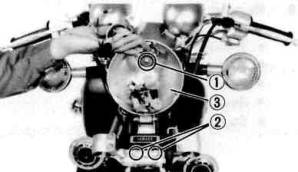
REMOVAL
1. Remove:
• Front wheel
• Front forks
2. Remove:
• Headlight lens unit
3. Disconnect:
• Wire connectors (in the headlight shell)
4. Remove:
• Headlight shell securing bolt 1
• Brake hose joint securing bolts 2
• Headlight shell 3
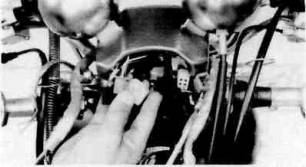
5. Disconnect:
• Meter panel wiring connectors
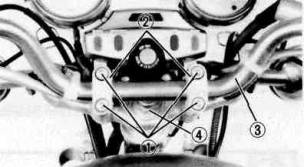
6. Remove:
• Covers
• Handlebar bolts 1
• Handlebar upper brackets 2
• Handlebar assembly 3
• Steering stem nut 4
• Steering crown and meter panel assembly.
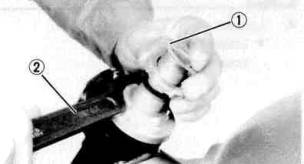
7. Remove:
• Special washer 1
8. Loosen:
• Upper and lower ring nut. Use Steering Ring Nut Wrench (YU-01268) 2.
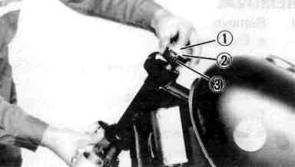
9- Remove:
• Upper ring nut
• Washer
• Lower ring nut 1
• Bearing cover 2
• Bearing 3
• Steering stem
INSPECTION
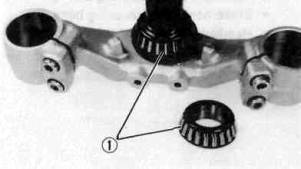
1. Check:
• Bearings 1 for pitting or damage — Replace races and bearing as required.
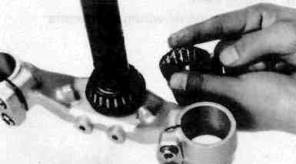
ASSEMBLY
1. Lubricate:
• Bearings
Wheel Bearing Grease
2. Install:
• Bearing (onto steering stem)
• Steering stem
• Bearing
• Bearing cover
• Lower ring nut
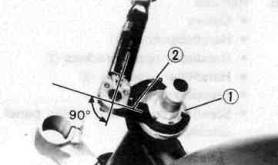
3. Tighten:
• Lower ring nut 1.Use Steering Nut Wrench (YU-33975)
50Nm(5.0 m-kg, 36 ft-lbs)
4. Loosen:
• Lower ring nut Loosen completely.
5. Retighten:
• Ring nut
6 Nm (0.6mkg, 4.3 ft-lb)
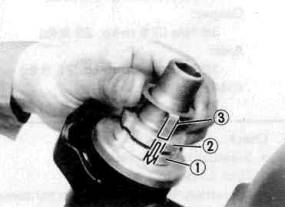
6. Install:
• Washer 1
• Upper ring nut 2
7. Tighten:
• Upper ring nut 2 (with finger)
8. Install:
• Special washer 3
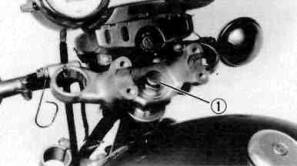
9. Install:
• Steering crown and meter panel assembly.
• Steering stem nut 1
10. Check:
• Steering head operation. Turn it from lock to lock. Looseness/Binding — Readjust.
11. Position:
• Front fork (into steering crown)
This will facilitate alignment of underbracket holes with steering crown holes.
12. Tighten:
• Steering stem nut
110 Nm (11 mkg, 80 ft-lb)
13. Continue assembly by reversing removal sequence.
Fork Pinch Bolt (Upper): 20Nm(2.0nvkg, 14ft-lb)
Fork Pinch Bolt (Lower): 23 Nm (2.3 mkg, 17 ft-lb)
Brake Hose Joint: 9 Nm (0.9 mkg, 6.5 ft-lb)
Fork Brace: 9 Nm (0.9 mkg, 6.5 ft-lb)
Caliper: 35 Nm (3.5 mkg, 25 ft-lb)
Axle: 105 Nm (10.5 mkg, 75 ft-lb)
Axle Pinch Bolt: 20 Nm (2.0 mkg, 14 fHb)
14. Check:
• Steering head operation. Turn it from lock to lock. Looseness/Binding — Readjust tightness of steering stem.
Swingarm and Rear Shock Absorber
Swingarm and Rear Shock AbsorberSWINGARM AND REAR SHOCK ABSORBER
1 Rear shock absorber
2 Swingarm
3 Bearing
4 Oil seal
5 Collar
6 Lock washer
7 Left pivot shaft
8 Pivot cover
9 Right pivot shaft
10 Nut
11 Rubber boot
12 Spring band
SWINGARM FREE PLAY INSPECTION

1. Remove:
• Rear wheel
• Rear shock absorbers 1
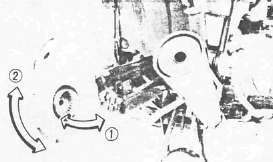
2. Check the swingarm side play 1. Grasp and move from side to side. Check and adjust bearing if there is any play. Rotate swingarm verticaly 2. Check and adjust bearings if there it is loose or binding. Replace if there are rough spots or other damage.
REMOVAL
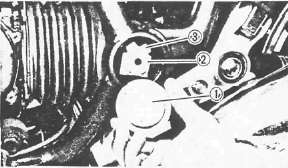
1. Remove:
• Rear wheel
• Rear shock absorbers
• Pivot covers 1
2. Flatten the lock washer tab on the left pivot shaft.
3. Remove:
• Left pivot shaft 2
• Lock washer 3

4. Remove:
• Right pivot shaft 1
• Locknut 2
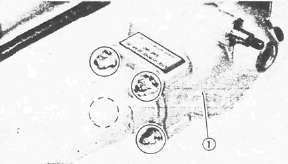
5. Remove:
• Swingarm assembly
• Final gear case assembly 1
INSPECTION AND LUBRICATION
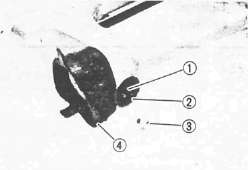
1. Inspect:
• Bearings 1
• Oil seals 2
• Collars 3
• Rubber boot 4
Replace any damaged components.
2. Lubricate the bearings and oil seal with Waterproof Wheel Bearing Grease
ASSEMBLY
1. Install:
• Swingarm assembly
• Lock washer
• Left pivot shaft
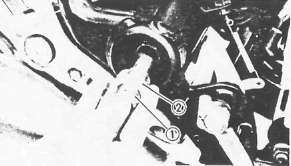
• Right pivot shaft 1
• Locknut 2

2. Tighten the left pivot shaft
Left Pivot Shaft: 100 Nm (10m-kg, 72ft-lb)
3. Bend lock washer tab.

4. Tighten the right pivot shaft 1
Right Pivot Shaft: 5.5 Nm (0.55 m-kg, 4.0 ft-lb)
5. Tighten the right pivot shaft locknut 2
Right Pivot Shaft Nut: 100 Nm (10 m-kg, 72 ft-lb)
6. Install the pivot cover
7. Continue assembly by reversing of removal sequence.
Final Gear Case Securing Nut: 42 Nm (4.2 m-kg, 30 ft-lb)
Shaft and Rear Drive
Shaft and Rear DriveSHAFT DRIVE
Refer to "CHAPTER 3". for the middle gear.
The following special tools are not available but can be constructed for the final gear disassembly and assembly:
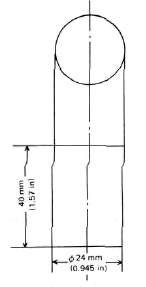
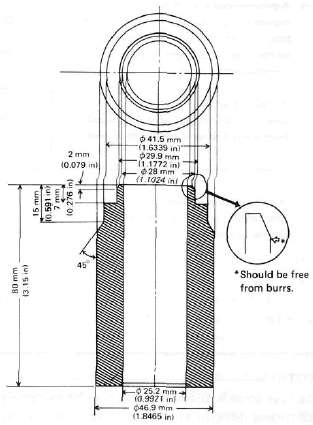
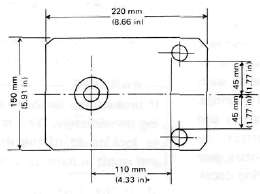
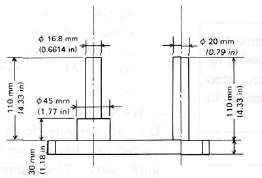
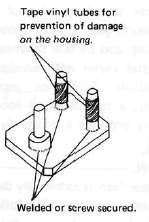
A. Troubleshooting
1. The following conditions may indicate damaged shaft drive components:
|
Symptoms |
Possible damaged areas |
|
1. A pronounced hesitation or "jerky" movement during acceleration, deceleration, or sustained speed. (This must not be confused with engine surging or transmission characteristics). 2. A "rolling rumble" noticeable at low speed; a high-pitched whine; a "clunk" from a shaft drive component or area. |
A. Damage to bearings. B. Improper gear lash. C. Gear tooth damage. D. Drive flange/universal joint bolts loose. |
|
3. A locked-up condition of the shaft drive mechanism; no power transmitted from engine to rear wheel. |
E. Broken drive-shaft. F. Disconnected flange/universal joint connection. G. Broken gear teeth. H. Seizure due to lack of lubrication. I. Small foreign object lodged between moving parts. |
Note:
Damage areas A, B, and C above may be extremely difficult to diagnose. The symptoms are quite subtle and difficult to distinguish from normal motorcycle operating noise. If there is reason to believe component(s) are damaged, remove component(s) for specific inspection.
2. Inspection Notes:
a. During coasting, accelerating or decelerating, the "rolling rumble" will increase with rear wheel speed, not engine or transmission gear speeds. However, such noise may also be due to wheel bearings.
b. Noise that varies with acceleration and deceleration: Following incorrect reassembly, a condition of too-little gear lash may produce a whine during deceleration.
CAUTION:
Too-little gear lash is extremely destructive to gear teeth. If a test ride following reassembly indicates this condition, stop riding immediately to minimize damage to gears.
c. A slight "thunk" must be distinguished from normal motorcycle operation. It will be most noticeable at low speed and could indicate broken gear teeth.
WARNING:
If broken gear teeth are suspected, stop riding immediately. This condition could lead to locking-up of the shaft drive assembly and result in harm to a rider.
d. If the drive flange/universal joint bolts are slightly loose, a "clunk" may be felt when slowly taking off, or when changing from slow acceleration to slow deceleration. At high speed this will result in vibration.
WARNING:
Do not continue riding a motorcycle suspected of having loose flange/universal joint bolts. The components may break, causing injury to a rider.
3. Troubleshooting Chart
Where Basic Conditions "a" and "b" above exist, consider the following Chart:
|
Elevate and spin front wheel. Feel for wheel bearing damage. |
Yes ► |
Replace wheel bearing. (See CHAPTER 5 "Front wheel") |
|
No |
||
|
Check rear wheel. Feel for bearing damage. |
No ►
|
Rear wheel bearings and shaft drive bearings probably not damaged. Repeat test or remove individual components. |
|
Yes |
||
|
Remove rear wheel. Check for wheel bearing damage. |
Yes ► |
Replace rear wheel bearing. (See "Rear Wheel" section in this chapter.) |
|
No |
||
|
Remove drive shaft components. |
4. Oil Leak Inspection
If a shaft drive component is suspected of leaking oil, first thoroughly clean the entire motorcycle. The apparent location of an oil leak on a dusty motorcycle may be misleading. Dry the motorcycle and apply a leak-localizing compound or a dry-powder spray that will limit the flow of any leaking oil. Operate the motorcycle prepared in this way for the distance necessary to precisely locate the leak. There are the possibilities that a component housing may have been damaged by road debris or an accident, or a gasket or seal may be cracked or broken. However, on new or nearly new motorcycle an apparent oil leak may be the result of a rust-preventive coating or excess assembly lubrication of seals. Always clean the motorcycle and recheck the suspected location of any apparent leakage.
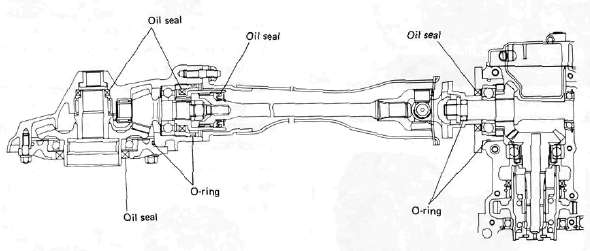
5. Checking Drained Oil
Whenever a problem is suspected in either the middle or final gear assemblies, drain and inspect the oil. Metal particles on the drain plug or in the oil could indicate a bearing seizure or other problem in the component. However, a small amount of metal particles in the oil is normal.
B. Final Gear Removal
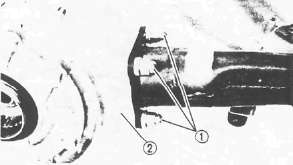
1. Remove:
• Rear axle
• Rear wheel (see "Rear Wheel" section in this chapter).
• Left shock absorber
• Nut 1
• Final gear assembly 2
2. Remove the 4 nuts holding the Final Drive unit to the swing arm.
3. Remove the final gear assembly.
C. Gear Lash Check and Adjustment
1. Secure the gear case in a vice or other support.
2. Remove one nut from the final gear case stud bolt. Install the gear holder (special tool) over the ring gear surface and stud bolt. Tighten the holder to stud bolt with a nut.
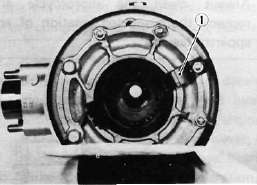
1. Final gear holding tool
3. Install the final gear lash measurement tool on the gear coupling.
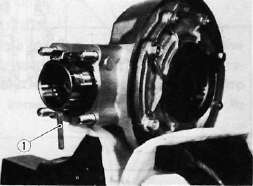
1. Gear lash measurement tool (Final gear)
4. Mount a dial gauge against the lash measurement tool at the scribed mark (60 mm, 2.36 in from the center of the shaft).
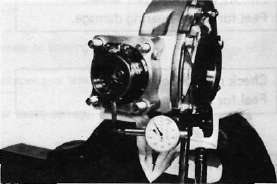
5. Use the special wrench to gently rotate the gear coupling back and forth. Note the lash measurement on the dial gauge.
Final gear lash:
When using the measurement tool: 0.25 - 0.50 mm (0.010-0.020 in) .
Actual gear lash on the final gear teeth: 0.1 ~ 0.2 mm (0.004 ~ 0.008 in).
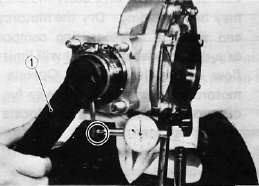
1. Middle and final gear holding tool
6. If the gear lash exceeds the specified limits, adjust as follows:
a. To reduce gear lash, increase the ring gear shim.
b. To increase gear lash, reduce ring gear shim.
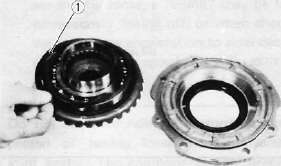
1. Ring gear shim
c. If it is necessary to increase the ring gear shim by more than 0.1 mm reduce the thrust washer thickness by 0.1 mm for each 0.1 mm of ring gear shim increase and if it is necessary to reduce shim by more than 0.1 mm, reverse above procedure.
D. Final Gear Disassembly
1. Remove the nuts and bolts holding the bearing housing.
2. Remove the ring gear assembly and thrust washer from the final gear case.
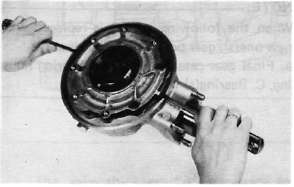
3. Remove the self-locking nut from drive pinion by using the holding tool (special tool) and remove the coupling.
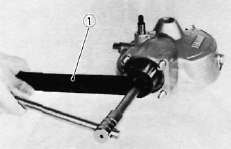
1. Middle and final gear holding tool
4. Remove the drive pinion bearing retainer with the retainer remover (special tool).
CAUTION:
The drive pinion bearing retainer nut is left hand threads. Turn the retainer nut clockwise to loosen.
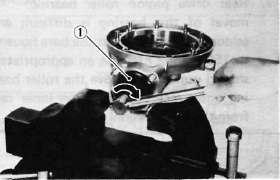
1. Drive pinion bearing retainer remover
5. Remove the drive pinion and bearing with the slide hammer and adapter (special tool).
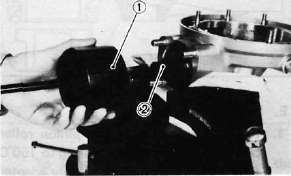
1. Slide hammer 2. Adapter
CAUTION:
This drive pinion removal should be performed only if gearing replacement is necessary. Do not re-use bearings or races after removal.
6. Remove the guide collar, oil seal, and roller bearing from the main housing by using the press tool No. 1 (special tool) and a press. Use an appropriate supports for the main housing during this operation. The roller bearing may be re-used if undamaged. Do not re-use oil seal.
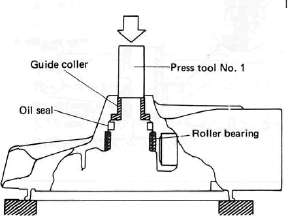
Rear drive pinion roller bearing; removal of this bearing is difficult and seldom necessary. Heat the bare housing to 150°C (302°F). Use an appropriately shaped punch to remove the roller bearing outer race. Remove the inner race from the drive pinion.
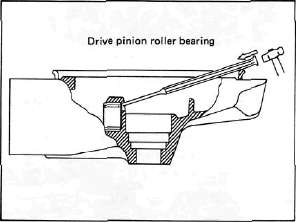
E. Final Gear Reassembly
1. Install the new rear drive pinion roller bearing. Heat the bare bearing to 150°C (302°F) and use an appropriately adapter to install the roller bearing outer race. Install the inner race onto the drive pinion.
2. Using the press tool No. 2 (special tool) and a press, install the guide collet, new oil seal, and roller bearing into the main housing in that order.
NOTE:
The removed roller bearing can be used if undamaged; however, we recommend replacement with a new one.
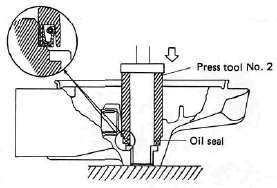

3. Final drive/ring gear positioning
NOTE:
When the following part(s) is replaced with new one(s), gear positioning is necessary: a. Final gear case, b. Ring gear bearing housing, C. Bearing(s)

a. The shim thickness "A" necessary for the drive pinion gear positioning can be calculated from the information found on the final gear case and on the drive gear end.

1. Size number

To fined shim thickness "A" use the
formula:
A = a -b
Where:
a = a numeral (usually a decimal number) on the gear near the tooth and either added to or detracted from the nominal size "84".
b = a numeral on the gear case appearing as a whole figure (ie. 83.50).
Example:
1) If the pinion gear is marked "+01"....."a" is 84.01.
2) If the gear case is marked "83.50".
A = 84.01 - 83.50 A = 0.51
Then the necessary shim thickness is 0.51mm.
Shim sizes are supplied in the following thicknesses:
0.15 mm, 0.30 mm, 0.40 mm, 0.50 mm, 0.60 mm.
Because the shims can only be selected in 0.05 mm increments the following chart should be used when encountering last digits that are not 5 or zero (0):
|
Last digits |
Rounding |
|
0,1,2 |
0 |
|
3, 4, 5, 6, 7 |
5 |
|
8,9 |
10 |
b. The shim thickness "B" necessary for the ring gear positioning can be calculated from the information found on the final gear case, ring gear, and bearing.
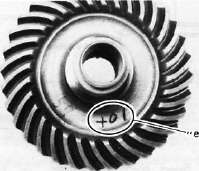
To find shim, thickness "B" use the
formula:
B = c + d-(e + f)
Where:
c= a numeral on the gear case appearing as a whole figure (ie. 45.52)
d = a numeral (usually a decimal number) on the outside of the ring gear bearing housing and added to the nominal size "3".
e= a numeral (usually a decimal number) on the inside of the ring gear and; either added to or detracted from the nominal size "35.40".
f = a bearing thickness (considered constant)
Distance "f" = 13.00 mm
Example:
1) If the gear case is marked "45.52".
2) If the ring gear bearing housing is marked "35"....."d" is 3.35.
3) If the ring gear is marked "+01" ..... "e" is 35.40 + 0.01 = 35.41.
4) "f" is 13.00.
B = c + d-(e + f)
B = 45.52 + 3.35 - (35.41 + 13.00)
B = 48.87- (48.41)
B = 0.46
Then the necessary shim thickness is
0.41 mm.
NOTE:
Use the chart for the drive pinion shim to select the ring gear shim size.
4. Install the drive pinion gear with the proper size of shim(s) and secure it with the bearing retainer nut with the drive pinion bearing retainer remover (special tool).
NOTE:
The bearing retainer nut is left hand threads; turn the nut to counterclockwise to tighten.
Tightening torque: 11 m-kg (80 ft-lb)
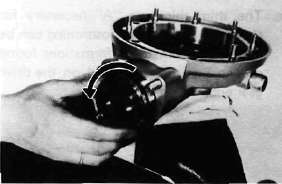
Install the ring gear assembly without the thrust washer. Adjust the gear lash (refer to "C. Gear lash check and adjustment).
Place four pieces of "PLASTIGAGE" between the originally fitted thrust washer and ring gear. Install the gear case onto the ring gear assembly and tighten the nuts and bolts with the specified torque.

Tightening torque;
Bolt/Nut......... 2.3 m-kg
(16.6 ft-lb)
NOTE:
Do not turn the drive pinion/ring gear when measuring clearance with "PLASTIGAGE".
8. Remove the ring gear assembly and determine the clearance by measuring the width of the flattened "PLASTIGAGE".

1. PLASTIGAGE
Ring gear thrust clearance. 0.1 ~ 0.2 mm
9. If the clearance exceeds the specification above, replace the thrust washer to obtain the proper clearance.
DRIVE SHAFT/JOINT

A. Removal
1. Remove the rear wheel. See "REAR WHEEL A. Removal" in this chapter.
2. Remove the final gear case assembly.
3. Remove the drive shaft. See "SWING ARM removal" in this chapter.
4. To remove the universal joint, it is necessary to remove the swing arm. Remove the universal joint assembly.
B, Inspection
1. Drive shaft
Inspect the shaft splines for wear and/or damage. If excessive, replace the drive shaft.
NOTE:
When installing the drive shaft, lubricate splines with molybdenum di-sulfide grease.

2. Universal joint
a. There should be no noticeable play in the universal joint bearings. If there is any play in the bearing, replace the universal joint assembly.
b. Move the universal joint up and down and from side to side. The universal joint should move smoothly. Without tightness, binding or rough spots that could indicate damaged bearings. If damaged, replace the universal joint assembly.
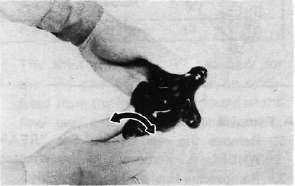
C. Reinstallation
When installing the drive shaft and the universal joint, reverse the removal procedure. Note the following points:
1. Lubricate the shaft splines with molybdenum di-sulfide grease.
2. Tighten the universal joint securing bolts and final gear case securing nuts with the specified torque:
Final gear case: 4.2 m-kg (30.4 ft-lb) Universal joint: 4.4 m-kg (31.8 ft-lb)
Cables and Maintenance
Cables and MaintenanceCABLE MAINTENANCE
NOTE:
See "Maintanance and Lubrication" intervals charts. Cable maintenance is primarily concerned with preventing deterioration and providing proper lubrication to allow the cable to move freely within its housing. Cable removal is straightforward and uncomplicated. Removal is not discussed within this section.
WARNING:
Cable routing is very important. For details of cable routing, see cable routing diagrams at end of this manual. Improperly routed or adjusted cables may make motorcycle operation unsafe.
1. Remove the cable
2. Inspect the cable for obstructed movement, kinking and/or frayed strands.Replace if damaged.
Cable Lubrication Steps:
• Hold the cable in a vertical position.
• Apply lubricant to the uppermost end of the cable.
• Leave in a vertical position until the lubricant appears at the bottom.
• Allow excess to drain, then reinstall the cable.
NOTE:
Choice of lubricant depends upon conditions and preferences; however, a semi-drying chain and cable lubricant will perform adequately under most conditions.
THROTTLE MAINTENANCE
1. Remove: the Phillips head screws from throttle housing assembly. Separate the housing halves.
2. Disconnect the cable from throttle grip assembly.
3. Remove the throttle grip assembly
4. Clean all parts with mild solvent.
5. Inspect:
• Contact surfaces
• Right-hand end of handlebar
Deburr or replace.
6. Lubricate all contact surfaces with a light coat of lithium-soap base grease and reassembly.
NOTE:
Tighten the housing screws evenly to maintain an even gap between housing halves.
Chapter 6, ELECTRICAL
Chapter 6, ELECTRICALWiring Diagram
Wiring Diagram
1 A.C. Generator 2 Rectifier/Regulator 3 Main switch 4 Fuse "IGNITION" (10A)
5 Engine stop switch 6 Pickup coil 7 T.C.I. Unit 8 Ignition coil {No. 1, 4) 9 Ignition coil (No. 2, 3)
10 "FUEL" indicator light 11 Fuel sender 12 Tacho meter 13 Horn 14 Horn switch
15 Flasher relay (Relay assembly) 16 Reed switch 17 Flasher switch 18 Flasher light (Front, Right)
19 Flasher light (Rear, Right) 20 "TURN" indicator light (Right) 21 "TURN" indicator light (Left)
22 Flasher light (Rear, Left) 23 Flasher light (Front, Left) 24 Oil level switch 25 "OIL" indicator light
26 Neutral switch 27 "NEUTRAL" indicator light 28 Brake switch 29 Tail/Brake light
30 Fuse "SIGNAL" (15A) 31 Fuse "HEAD" (15A) 32 Meter light 33 Head light
34 "HIGH BEAM" indicator light 35 Dimmer switch 36 Starter switch 37 Clutcn switch
38 Starting circuit cut-off relay (Relay assembly) 39 Starter motor 40 Starter relay 41 Battery
42 Fuse "MAIN" (30A) 43 Sidestand switch 44 Sidestand relay 45 Diode assembly
COLOR CODE
|
0 |
Orange |
Lg |
Light green |
B/Y |
Black/Yellow |
|
R |
Red |
Y/G |
Yellow/Green |
L/W |
Blue/White |
|
L |
Blue |
Y/R |
Yellow/Red |
L/G |
Blue/Green |
|
Br |
Brown |
Y/B |
Yellow/Black |
L/R |
Blue/Red |
|
B |
Black |
Y/L |
Yellow/Blue |
L/B |
Blue/Black |
|
Y |
Yellow |
Br/W |
Brown/White |
G/L |
Green/Blue |
|
W |
White |
R/B |
Red/Black |
G/R |
Green/Red |
|
G |
Green |
R/L |
Red/Blue |
G/Y |
Green/Yellow |
|
P |
Pink |
R/W |
Red/White |
G/W |
Green/White |
|
Dg |
Dark green |
R/Y |
Red/Yellow |
W/R |
White/Red |
|
Ch |
Chocolate |
B/R |
Black/Red |
W/B |
White/Black |
|
Gy |
Gray |
B/W |
Black/White |
W/G |
White/Green |
|
Sb |
Sky blue |
|
|
|
|
Electrical Components
Electrical ComponentsELECTRICAL COMPONENTS 1
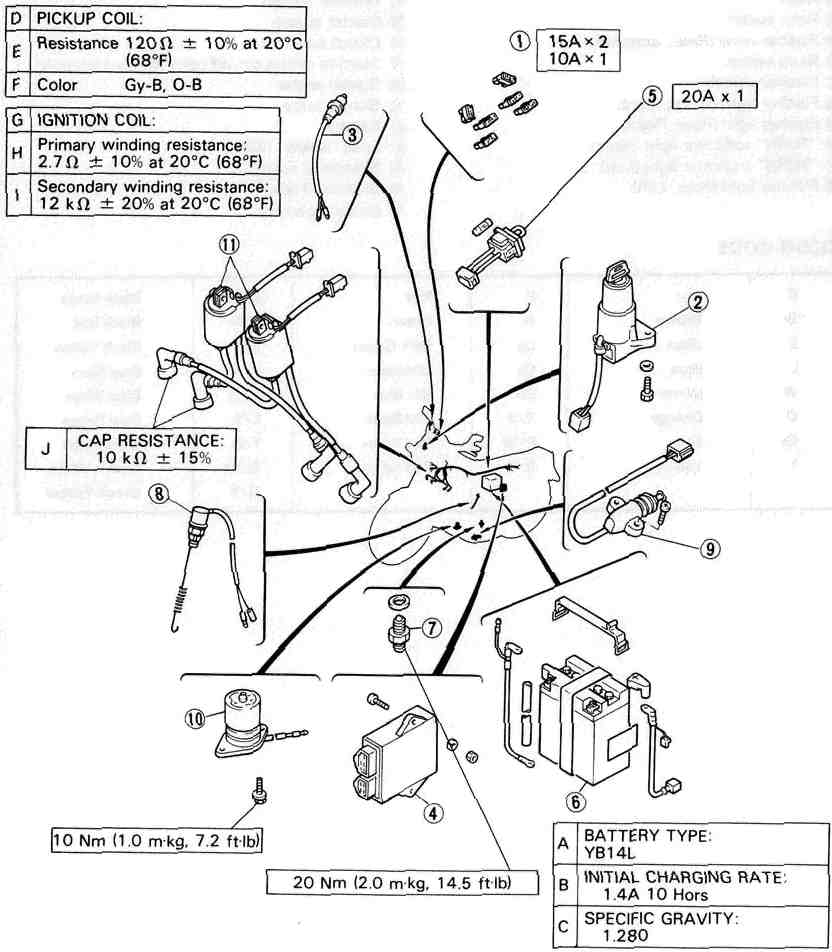
1 Fuse 2 Main switch 3 Front brake switch 4 TCI unit Main fuse Battery
5 Neutral switch 6 Rear brake switch 7 Sidestand switch 8 Oil level switch
9 Ignition coil
ELECTRICAL COMPONENTS 2

1 Horn 2 Sidestand relay 3 Diode assembly
4 Relay assembly (Starting circuit cut-off relay, flasher relay)
5 Starter relay 6 Rectifier/Regulator 7 Starter motor
8 Fuel sender
Electric Starting System
Electric Starting SystemELECTRIC STARTING SYSTEM
CIRCUIT DIAGRAM
Below circuit diagram shows starter circuit in wiring diagram.
.

3 Main switch
4 Fuse "IGNITION" (10A)
5 Engine stop switch
26 Neutral switch
36 Starter switch
37 Clutch switch
38 Starting circuit cut-off relay (Relay assembly)
39 Starter motor
40 Starter relay
41 Battery
42 Fuse "MAIN" (30A)
43 Sidestand switch 45 Diode
COLOR CODE
|
0 |
Orange |
Lg |
Light green |
B/Y |
Black/Yellow |
|
R |
Red |
Y/G |
Yellow/Green |
L/W |
Blue/White |
|
L |
Blue |
Y/R |
Yellow/Red |
L/G |
Blue/Green |
|
Br |
Brown |
Y/B |
Yellow/Black |
L/R |
Blue/Red |
|
B |
Black |
Y/L |
Yellow/Blue |
L/B |
Blue/Black |
|
Y |
Yellow |
Br/W |
Brown/White |
G/L |
Green/Blue |
|
W |
White |
R/B |
Red/Black |
G/R |
Green/Red |
|
G |
Green |
R/L |
Red/Blue |
G/Y |
Green/Yellow |
|
P |
Pink |
R/W |
Red/White |
G/W |
Green/White |
|
Dg |
Dark green |
R/Y |
Red/Yellow |
W/R |
White/Red |
|
Ch |
Chocolate |
B/R |
Black/Red |
W/B |
White/Black |
|
Gy |
Gray |
B/W |
Black/White |
W/G |
White/Green |
|
Sb |
Sky blue |
|
|
|
|

ELECTRIC STARTING SYSTEM
STARTING CIRCUIT OPERATION
The starting circuit on this model consists of the starter motor, starter relay, starter safety unit, and sidestand relay. If the engine stop switch and the main switch are both on, the starter motor can operate only if:
• The transmission is in neutral (the neutral switch is on.)
• The sidestand is up (the sidestand switch is on) and the clutch lever is pulled in (clutch switch is on).
Battery Starter motor Starter relay Starter safety unit (Relay assembly) Starter switch Neutral switch
Sidestand switch Clutch switch Sidestand relay Tachometer Main switch Engine stop switch To ignitor switch


1 Battery 2 Starter motor 3 Starter relay 4 Starting circuit cut-off relay
5 Starter switch 6 Neutral switch 7 Sidestand switch 8 Clutch switch
9 Sidestand relay 10 Tachometer 11 Main switch 12 Engine stop switch
13 To ignitor unit
|
Turn main switch to "ON" and engine stop switch to "RUN" |
|
|
Transmission is |
|
|
▼ |
▼ |
|
In neutral |
In gear |
|
▼ |
▼ |
|
Push starter switch Engine will start |
Raise Sidestand and Pull in clutch lever |
|
▼ |
▼ |
|
Ensure Sidestand is up |
Push starter switch: Engine will start |
|
▼ |
▼ |
|
Motorcycle can be ridden |
|
TROUBLESHOOTING CHART
|
THE STARTER MOTOR DOES NOT OPERATE. |
|
|
|
▼ |
|
|
|
|
||
|
Connect "L/W" lead from the starter relay 1 to the battery negative (-) terminal 2 ; use a jumper lead. |
► |
The engine does not rev smoothly. |
|
▼ |
||
|
Recharge or replace the battery. |
||
|
|
||
|
► |
The engine does not operate. | |
|
▼ |
||
|
▼ |
|
|
|
Check the battery voltage (12V) on the "L/W" lead from the starter relay. |
||
|
The engine operates. |
||
|
▼ |
||
|
▼ |
||
|
Main and engine stop switches are turned to "ON". |
||
|
If the starter relay does not click, check the starter relay and starter motor. |
||
| ▼ | ||
|
|
||
|
|
||
|
Connect "B/Y" lead to "ground" on the frame; use a jumper lead 1. |
||
|
► |
|
|
|
If the relay unit does not click, check the battery voltage (12V) on the "R/W" lead. |
||
|
|
▼ |
|
|
Check for an open or poor connection between the main switch and relay unit. |
||
|
▼ |
||
|
If the relay unit clicks, check the starter, sidestand, clutch and neutral switches. Replace switch(es) if necessary. |
|
STARTER SAFETY UNIT (Relay Assembly)

1. Remove:
• Seat
• Fuel tank
• Relay assembly ®

2. Check:
• Relay contacts Use 12V battery (§) and Pocket Tester (YU-03112). Out of specification — Replace relay.
Battery Connected: OH ® Battery disconnected: °° ©
DIODE

1. Remove:
• Left side cover
• Diode ®

2. Check:
• Diode continuity/discontinuity
Defective element(s) — Replace the unit.
|
Checking element |
Pocket tester connecting point |
Good |
|
|
(+) (red) |
(-) (black) |
||
|
D, |
G |
L/W |
O |
|
L/W |
G |
X |
|
|
D2 |
Y |
Sb |
o |
|
Sb |
Y |
X |
|
|
D3 |
W/G |
W |
o |
|
W |
W/G |
X |
|
|
R |
G |
B/R |
8.20 |
O: Continuity (OH) (Scale H x 1000) X : Discontinuity («>) (Scale ohm x 1)
NOTE:
The results "O" or "X" should be reversed according to the pocket tester polarity.
NEUTRAL SWITCH
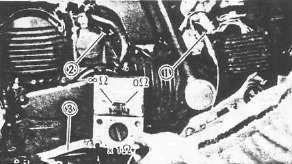
1. Remove:
• Left side cover
• Panel
2. Check the neutral switch contact. Replace if out of specification.
|
Shift pedal 3 |
In neutral |
In gear |
|
Tester |
0Ω |
∞Ω |
1 Blue lead
2 Ground
SIDESTAND SWITCH
1. Refer to neutral switch removal steps.
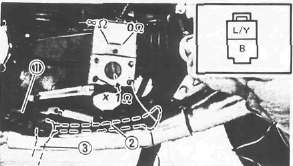
2. Check the sidestand switch 1 contact. Replace switch if out of specification.
|
Sidestand |
Up 2 |
Down 3 |
|
Tester |
0Ω |
∞Ω |
CLUTCH SWITCH
1. Remove headlight unit
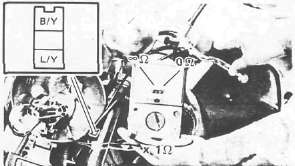
2. Check clutch switch contact. replace if out of specification.
|
Clutch lever |
Pull in |
Not pull in |
|
Tester |
0Ω |
∞Ω |
STARTER SWITCH
1. Remove the headlight unit.
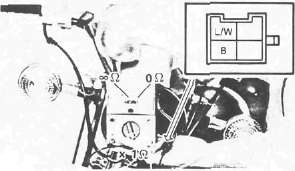
2. Check starter switch contact. Replace if out of specification.
|
Starter switch |
ON |
OFF |
|
Tester |
0Ω |
∞Ω |
STARTER RELAY Inspection
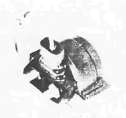
Preparation steps:
• Disconnect starter motor red lead.
• Connect Pocket Tester leads to relay terminals.
•Turn main switch to "ON".
• Turn engine stop switch to "RUN".
• Move shift pedal to "NEUTRAL"
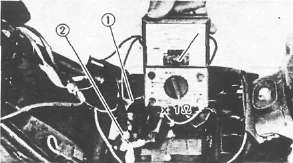
|
Push starter switch to "ON" |
||
|
▼ |
▼ |
|
|
Relay clicks and tester reads 0Ω |
Relay does not click and tester does not read 0 Ω |
|
|
▼ |
▼ |
|
|
OK |
Measure resistance: |
|
|
|
||
|
▼ |
▼ | |
|
Resistance less than 1 Ω |
Resistance more than 1 Ω | |
|
▼ |
▼ | |
|
Check connections |
Replace relay | |
Starter Motor
Starter MotorSTARTER MOTOR
1 O-ring
2 Brush
3 Armature
4 Washer
5 Circlip
Removal
Refer Chapter 3. "ENGINE DISASSEMBLY".
Inspection
1. Inspect commutator outer surface. Clean with 600 grit sandpaper if dirty. Check mica insulation between commutator segments and scrape mica to proper limits. Use a hacksaw blade that is ground to fit.

Mica Undercut 1 : 0.4 - 0.8 mm (0.02 - 0.03 in)
NOTE:
The mica insulation of commutator must be under-cut to ensure proper operation of commutator.

2. Measure the armature coil continuity 1. Replace or rewind starter motorif necessary.
Armature Coil: 0.014Ω ± 6% at 20°C (68° F)
Measure the armature coil insulation 2. Replace the starter motor if shorted.

3. Inspect:
• Front cover bearing 1
• Center and rear covers bushings 2
Replace if damaged.
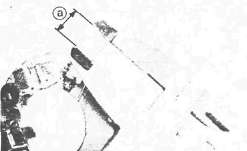
4. Measure the length of each brush length a and replace if less than minimum length.
Minimum Brush Length: 8.5 mm (0.34 in)
5. Check the brush spring pressure and compare with new spring. Replace spring if weak.
Charging System
Charging SystemCHARGING SYSTEM

1 A.C. Generator 2 Rectifier/Regulation 3 Main switch
41 Battery 42 Fuse "MAIN" (30A)
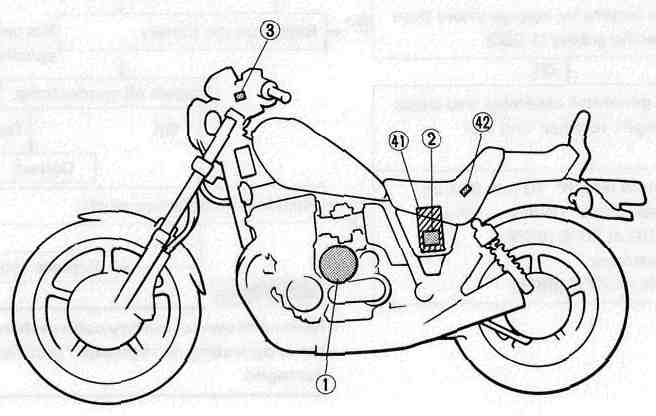

CHARGING VOLTAGE INSPECTION
1. Remove seat
2. Connect Pocket Tester leads (to each battery terminal)
3. Start the engine.
4. Measure the charging voltage. Rev engine to approximately 3,000 r/min or more.
Charging Voltage: 14.2 ~ 14.8 V
TROUBLESHOOTING
| Check voltage. | ◄ ◄ ◄ ◄ | ◄ | |
| Not within specification ▼ | ▲ | ||
|
Inspect all connections |
Defective ► | Correct.► | ▲ |
| OK ▼ | |||
| Measure the battery for voltage and specific gravity. Battery voltage: More than 12V Specific gravity: 1.280 |
Less than specification: ► | Recharge the battery. | |
|
OK ▼ |
|||
|
Remove the generator assembly and check the brush length, rectifier, and coil resistance. Minimum brush length: 10 mm (0.39 in) |
Less than specification: ► | Replace the defective part(s). | |
|
OK ▼ |
|||
| Replace rectifier/regulator. | |||
BATTERY
NOTE:
Replace the battery if:
•Battery voltage will not rise to a specific value or bubbles fail to rise even after many hours of charging.
•Sulfation of one or more cells occurs, as indicated by the plates turning white, or an accumulation of material exists in the bottom of the cell.
•Specific gravity readings after a long, slow charge indicate one cell to be lower than the rest.
•Warpage or buckling of plates or insulators is evident.
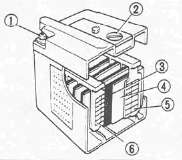
1 Terminal
2 Cap
3 Insulator
4 Separation plate
5 Negative electrode
6 Positive electrode
1. Inspect the battery terminals and battery couplers. Clean off any corrosion. Tighten as required.
2. Measure the specific gravity of battery fluid. Remove and recharge battery if less than 1.280
CAUTION:
To insure maximum battery performance be sure to:
• Charge a new battery before use.
• Maintain proper electrolyte level.
• Charge at proper current; 1.4 amps/10 hrs. or until the specific gravity reaches 1.280 at 20°C(68°F).
Failure to observe these points will result in a shortened battery life.

WARNING:
Battery electrolyte is dangerous; it contains sulfuric acid and therefore is poisonous and highly caustic.
Always follow these preventive measures:
•Avoid bodily contact with electrolyte as it can cause severe burns or permanent eye injury.
•Wear protective eye gear when handling or working near batteries. Antidote (EXTERNAL):
•SKIN - Flush with water.
•EYES — Flush with water for 15 minutes and get immediate medical attention. • Drink large quantities of water or milk and follow with milk of magnesia, beaten egg, or vegetable oil. Get immediate medical attention.
Batteries also generate explosive hydrogen gas, therefore you should always follow these preventive measures:
• Charge batteries in a well-ventilated area.
• Keep batteries away from fire, sparks, or open flames (e.g., welding equipment, lighted cigarettes, etc.)
• DO NOT SMOKE when charging or handling batteries. KEEP BATTERIES AND ELECTROLYTE OUT OF REACH OF CHILDREN.
Battery Service Life
The service life of a battery is usually two to three years. Battery life may be shortened by poor maintenance.
Preparation steps:
• Keep battery topped off with distilled water.
• Keep battery charged.
• Do not overcharge battery.
• Do not allow battery to freeze.
• Do not fill with tap water or sulfuric acid containing impurities.
• Do not charge new battery using improper voltage or current.
Battery Storage
The battery should be stored if the motorcycles is not to be used for a long period.
1. Remove the battery.
Battery storage and maintenance tips:
• Recharge the battery periodically.
• Store the battery in a cool, dry place.
• Recharge the battery before reinstalling.
|
Battery |
YB14L |
|
Electrolyte |
Specific gravity: 1.280 |
|
Initial charging rate |
1.4 amp for 10 hours (new battery) |
|
Recharging rate |
10 hours (or until specific gravity reaches 1.280) |
|
Refill fluid |
Distilled water (to maximum level line) |
|
Refill period |
Check once per month (or more often as required) |
1 Field coil
2 Stator
3 Brush
GENERATOR ASSEMBLY

1. Remove:
• Left side cover
• Panel
2. Measure the stator coil resistance
Stator Coil Resistance: 0.46Ω ± 10% at 20°C (68°F) (W-W)

3. Remove the A.C.G. cover
4. Measure the field coil resistance
Field Coil Resistance: 4.0Ω ±10% at 20°C (68°F)
5. Inspect the brush contact areas. Clean with 600 grit sandpaper if dirty.
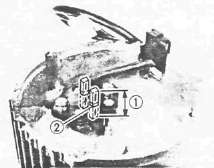
6. Measure each brush length 1. Replace if shorter than minimum.
Minimum Brush Length: 10 mm (0.39 in)
2 Wear indicator
7. Inspect the brush springs Compare with new spring.
RECTIFIER/REGULATOR

1. Remove:
• Left side cover
• Panel
2. Check Rectifier/Regulator 1 diodes (Refer to the following table.)
Defective element — Replace rectifier.

1 White
2 White
3 White
4 Red
5 Ground
6 Brown
A Regulator
B Rectifier
|
Checking |
Pocket tester |
Good |
|
|
(+) |
(-) |
||
|
D1 |
4 |
1 |
O |
|
1 |
4 |
X |
|
|
D2 |
4 |
2 |
O |
|
2 |
4 |
X |
|
|
D3 |
4 |
3 |
O |
|
3 |
4 |
X |
|
|
D4 |
1 |
5 |
O |
|
5 |
1 |
X |
|
|
D5 |
2 |
5 |
O |
|
5 |
2 |
x |
|
|
D6 |
3 |
5 |
O |
|
5 |
3 |
x |
|
O: Continuity X: Discontinuity (∞ )
CAUTION:
Do not overcharge rectifier or damage may result.
Avoid:
• A short circuit
• Inverting + and - battery leads
• Direct connection of rectifier to battery
NOTE:
The results "O" or "x" should be reversed according to the pocket tester polarity.
Ignition System
Ignition SystemIGNITION SYSTEM
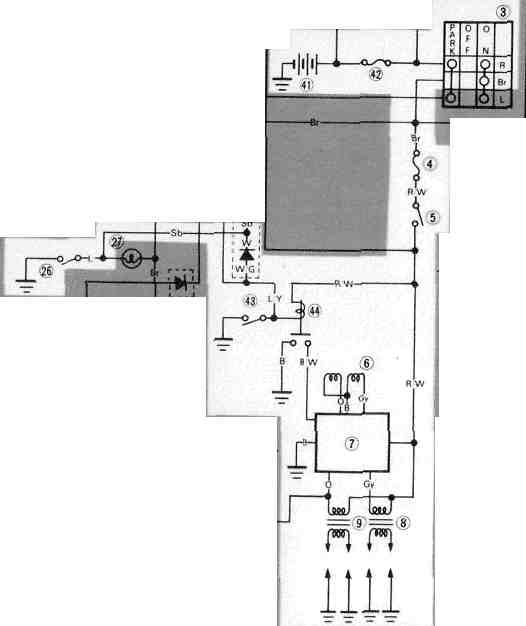
3 Main switch
4 Fuse "IGNITION" (10A)
5 Engine stop switch
6 Pickup coil
7 T.C.I. Unit
8 Ignition coil (No. 1, 4)
9 Ignition coil (No. 2, 3)
26 Neutral switch
41 Battery
42 Fuse "MAIN" (30A)
43 Sidestand switch
44 Sidestand relay
45 Diode

DESCRIPTION
This model is equipped with a battery operated, fully transistorized, breakerless ignition system. By using magnetic pickup coils, the need for contact breaker points is eliminated. This adds to the dependability of the system by eliminating frequent cleaning and adjustment of points and ignition timing. The TCI (Transistor Control Ignition) unit incorporates an automatic advance circuit controlled by signals generated by the pickup coil. This adds to the dependability of the system by eliminating the mechanical advancer. This TCI system consists of two units; a pickup unit and an ignitor unit.
OPERATION
The TCI functions on the same principle as a conventional DC ignition system with the exception of using magnetic pickup coils and a transistor control box (TCI) in place of contact breaker points.
Pickup Unit
The pickup unit consists of two pickup coils and a flywheel mounted onto the crankshaft. When the projection on the flywheel passes a pickup coil, a signal is generated and transmitted to the ignitor unit. The width of the projection on the flywheel determines the ignition advance.

1 Pickup coils
Ignitor Unit
This unit controls wave form, duty control, switching, electronic ignition advance, etc. The duty control circuit reduces electrical consumption by controlling the duration of the primary ignition current.

The ignitor unit 1 also has a protective circuit for the ignition coil. If the ignition switch is on and the crankshaft is not turning, the protective circuit interrupts the current flow to the primary coil after a few seconds. When the crankshaft is turning, however, the ignitor unit sends current to the primary coil.
1. Remove:
• Seat
• Left side cover
• Panel
• Ignitor unit 1
TROUBLESHOOTING
1. Start engine and warm-up a while, then turn it off.
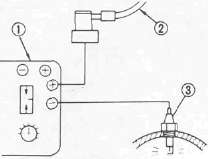
2. Connect Electro Tester (90890-03021) 1
2 Spark plug wire
3 Spark plug
3. Start engine and increase spark gap until misfire occurs (Test at various rpm between idle and red line.)
CAUTION:
Do not run the engine in neutral above 6,000 rpm for more than 1 or 2 seconds.
Minimum Spark Gap: 6 mm (0.24 in)
4. If ignition system becomes inoperative or engine misfires see the troubleshooting chart below:
Troubleshooting Chart
|
Check entire ignition connections. |
Poor connection ► |
Correct.
|
|
▼ OK |
||
|
Check battery voltage and specific gravity. |
Low voltage/specific gravity ► |
Recharge battery.
|
|
▼ OK |
||
|
Check fuse and fuse connections. |
Weak connection or open circuit ► |
Correct connection or replace fuse.
|
|
▼ OK |
||
Check ignition coil resistance (primary and secondary).Primary: 2.7Ω ± 10%at20°C (68°F) Secondary: 12 kΩ ± 20% at 20°C (68° F) |
If other than specified ► |
Replace ignition coil.
|
|
▼ OK |
If other than specified ► |
Replace pickup coil assembly.
|
|
Check pickup coil resistance. Pickup coil: 120Ω ± 10% at 20°C (68°F) |
||
|
▼ OK |
||
|
Check operation of sidestand switch and relay. |
Faulty ► |
Check sidestand relay sidestand switch, diode and neutral switch.
|
|
▼ OK |
||
|
TCI unit is faulty, replace unit. |
IGNITION COIL
1. Remove the fuel tank

2. Disconnect the ignition coil leads 1
2 No. 2 and No. 3 cylinder ignition coil

3. Measure the primary coil resistance
Primary Coil Resistance:
O to R/W lead connector
Gy to R/W lead connector
2.7Ω ± 10% at 20°C (68°F)
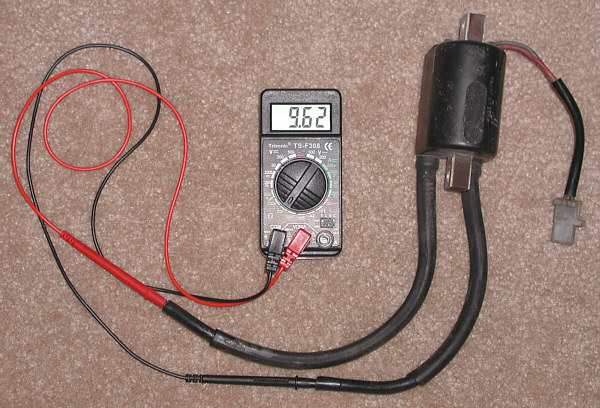
4. Measure secondary coil resistance
Secondary Coil Resistance:
12kΩ ±20% at 20°C (68°F)

5. Connect:
Electro tester 1
Fully charged battery 2 (to ignition oil leads)
3 No. 1 (Rear) cylinder high tension cord
4 Ground
5 R/W lead
6 O lead
6. Measure the ignition coil minimum spark gap Turn the spark gap adjuster and increase the gap to the maximum limit unless misfire occurs first.
Minimum Spark Gap: 6 mm (0.24 in)
PICKUP COIL
1. Remove:
• Left side cover
• Panel
2. Disconnect pickup coil wires from TCI unit wires.

3. Measure the pickup coil resistance. Use pocket tester.
Pickup Coil Resistance:
No. 1 and No. 4 cylinder (O — B)
No, 2 and No. 3 cylinder (Gy - B)
120Ω ± 10% at 20°C (68°F)
SIDESTAND RELAY
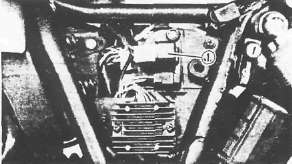
1. Remove:
• Left side cover
•Sidestand relay 1
2. Check the relay contacts

Use 12V battery 3 and Pocket Tester (90890-03112).
Battery Connected: ∞ 2
Battery Disconnected: 0Ω 1
SPARK PLUG
1. Check condition and replace if burned or fouled. Clean and regap as necessary.
CAUTION:
Be sure to use plugs of proper type
BP8ES (NGK) W24EP-U (NIPPONDENSO)

Electrode Gap 1 :
0.7 ~ 0.8 mm (0.028 - 0.031 in)
2. Install spark plug
Spark Plug: 20 Nm (2.0m*kg, 14ft-lb)
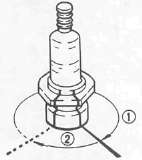
1 Finger tighten
2 Plug wrench tighten
Lighting System
Lighting SystemLIGHTING SYSTEM
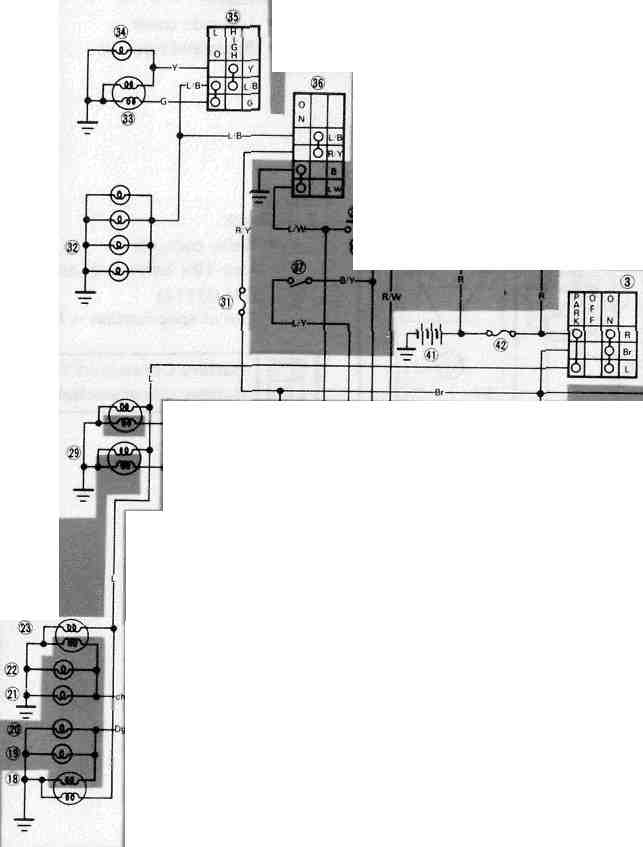
3 Main switch
18 Flasher light {Front, Right)
23 Flasher light (Front, Left)
29 Tail/Brake light
31 Fuse "HEAD" (15A)
32 Meter light
33 Head light
34 "HIGH BEAM" indicator light
35 Dimmer switch
36 Starter switch
41 Battery
42 Fuse "MAIN" (30A)
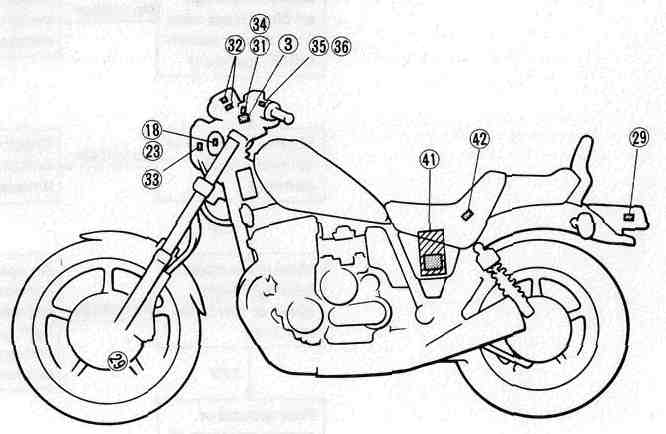
TESTS AND CHECKS Headlight Troubleshooting
|
HEADLIGHT DOES NOT COME ON WHEN ENGINE IS RUNNING/HIGH BEAM DOES NOT OPERATION. |
|
|
|
▼ |
|
|
|
Check headlight. |
Faulty ►
|
Replace.
|
|
▼ |
||
|
Check head fuse. |
Faulty ►
|
Replace.
|
|
▼ |
||
|
Measure voltage on brown wire from main switch ("ON" position). |
Faulty
|
Check dimmer switch, replace if necessary.
|
|
▼ |
||
|
Measure voltage on blue/black wire from starter switch ("ON" position). |
No voltage
|
Check main switch, replace if necessary.
|
|
▼ |
||
|
No voltage
|
Check starter switch, if necessary.
|
|
|
Measure voltage at dimmer switch terminal. |
||
|
▼ |
||
|
An open or poor connection between headlight and dimmer switch terminal. |
||
|
Measure voltage at headlight high beam or low beam terminal. |
No voltage |
|
|
▼ |
|
|
|
|
||
|
Poor ground or poor connection of headlight wiring. |
||
Taillight Troubleshooting
|
TAILLIGHT DOES NOT COME ON WHEN ENGINE IS RUNNING. |
|
|
|
▼ |
|
|
|
Check taillight bulb. |
Faulty |
Replace. |
|
▼ OK |
|
|
Measure voltage on blue wire from main switch ("ON" position). |
No voltage |
Check main switch, replace if necessary. |
|
▼ 12v |
|
|
|
Measure voltage at taillight terminal. |
No voltage. |
An open or poor connection between taillight and main switch terminal. |
|
▼ 12v |
||
|
Poor ground or poor connection or taillight wiring. |
|
|
Signal System
Signal SystemSIGNAL SYSTEM
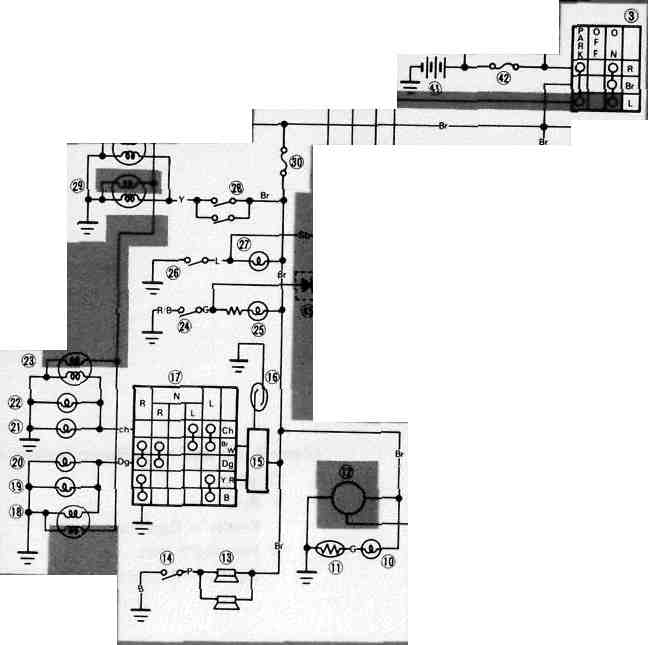
3 Main switch 10 "FUEL" indicator light 11 Fuel sender 13 Horn
14 Horn switch 15 Flasher relay {Relay assembly) 16 Reed switch
18 Flasher light (Front, Right) 19 Flasher light (Rear, Right)
20 "TURN" indicator light (Right) 21 "TURN" indicator light (Left)
22 Flasher light (Rear, Left) 23 Flasher light (Front, Left) 24 Oil level switch
25 "OIL" indicator light 26 Neutral switch 27 "NEUTRAL" indicator light
28 Brake switch 29 Tail/Brake light 30 Fuse "SIGNAL" 05A)
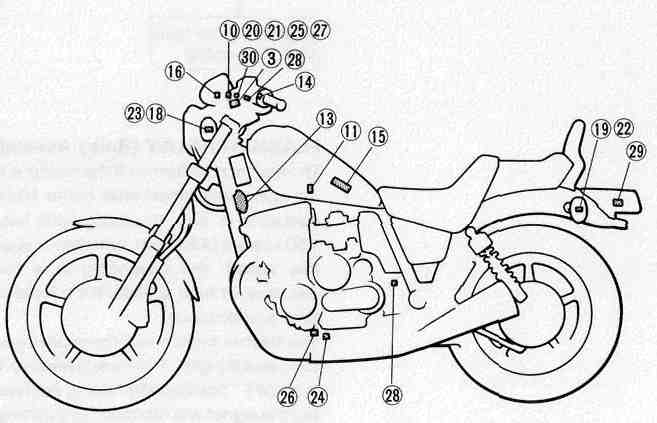
FLASHER LIGHT Troubleshooting
|
Flasher light and indicator light inoperative. |
||
| ▼ | ||
|
Check bulb. |
Faulty ► |
Replace.
|
|
▼OK |
||
|
Measure voltage at flasher switch (Br/W wire and Y/R wire). |
12V |
Check flasher switch, replace if necessary.
|
|
▼ No voltage |
||
|
Check flasher relay, main fuse, signal fuse and battery. |
Faulty and/or battery discharged . ► |
Replace faulty parts and/or charge battery.
|
|
▼ OK |
||
|
Check reed switch. |
Defect ► |
Replace.
|
|
▼ OK |
||
|
Replace flasher relay (Relay assembly). |
||
FLASHER RELAY (Relay Assembly)
NOTE:
Flasher relay and self cancelling unit are included with relay assembly.
The flasher relay turns off the flashers. Generally the signal will cancel after either 10 seconds of operation or after the motorcycle has traveled 150 meters (490 feet), whichever is greater. At low speed, the cancelling is a function of distance; at high speeds, it's a function of both time and distance.
The flasher switch has three positions: L (left), OFF, and R (right). The switch lever will return to the "OFF" position after being pushed to L or R, but the signal will function. By pushing the lever in, the signal may be cancelled manually.
REED SWITCH
1. Remove:
• Headlight unit
• Headlight body
2. Disconnect the coupler
3. Connect pocket tester
4. Lift the front wheel and rotate the wheel by hand.
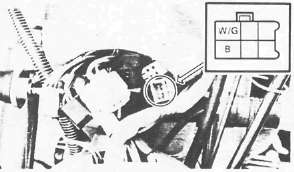
5. Measure reed switch resistance
Reed Switch Resistance: About 7 Then return back OΩ or ∞Ω when wheel is stopped
OIL LEVEL INDICATOR LIGHT
1. Troubleshooting
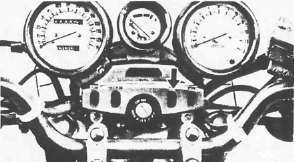
|
Oil level indicator light inoperative |
|||
|
Check bulb |
Faulty |
Replace |
|
|
▼ OK |
|
|
|
|
Measure voltage at oil level switch (Red/Black) |
No voltage |
Check diode, signal fuse, main switch, main fuse, and battery. Replace faulty parts. |
|
|
▼ 12V |
|
|
|
|
Check oil level switch, replace if necessary. |
|
||
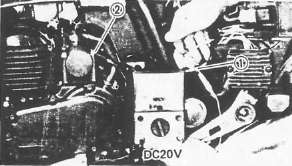
Red/Black lead
2 Ground
FUEL WARNING INDICATOR LIGHT
1. Troubleshooting

|
Fuel warning indicator light inoperative |
|||
|
▼ |
|
||
|
Check bulb |
Faulty |
Replace |
|
|
▼ OK |
|
|
|
|
Measure voltage at fuel sender unit (Green). |
No voltage |
Check signal fuse, main switch, main fuse, and battery. Replace faulty parts. |
|
|
▼ 12V |
|
||
|
|
|||
|
Check fuel sender, replace if necessary. |
|
||

1 Green
2 Black
FUEL SENDER UNIT
1. Remove seat
2. Fill the fuel tank (with gasoline)

3. Measure the fuel sender unit resistance.
Fuel Sender Unit Resistance: 1.1 ±0.2kΩ @ 20°C (68°F)
NEUTRAL INDICATOR LIGHT
1. Troubleshooting
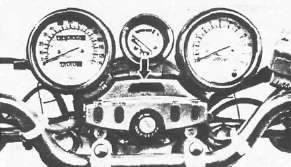
|
Neutral indicator light inoperative |
||
|
|
||
|
Check bulb |
Faulty |
Replace
|
|
▼ OK |
||
|
Measure voltage at neutral switch (Sb wire) |
No voltage |
Check signal fuse, main switch, main fuse, and battery, Replace faulty parts. |
|
▼ 12V |
|
|
|
|
||
|
Check neutral switch. Replace if necessary. |
|
|

1 Blue lead
2 Ground
HORN
1. Check:
|
Check for: |
Horn inoperative |
|
12V on brown lead to horn |
|
|
Good ground (horn/pink wire) when horn button is pressed |
|
|
Faulty |
Defective components — Replace.
NOTE:
There are individual fuses for various circuits (See Complete Circuit Diagram)

2. Measure the horn resistance
Horn Resistance: 1.05Ω ± 10%
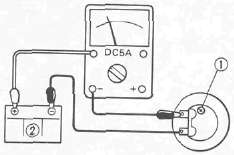
2 Battery (12V)
3. Adjust the volume. Turn the adjuster 1 in and out so that the volume is maximum at the maximum amperage.
|
Tester's lead wire |
Maximum Amperage |
Tester's range |
|
|
Red lead |
Black lead |
||
|
Battery (+) lead |
Horn lead and Battery (-) lead |
2.0A |
DC5A |
BRAKE LIGHT
|
Check for: |
Brake light inoperative |
|
Defective bulb |
|
|
12V on yellow lead to brake light |
|
|
12V on brown lead to each brake light switch (Front and rear brake switch) |
Switches
SwitchesSWITCHES
Use Pocket Tester (90890-03112) on "Ohm x 1" scale to check the switches. Replace any "shorted" or opened element.
Main Switch
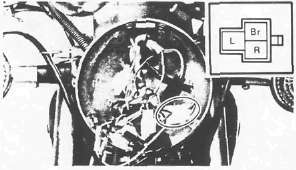
|
Switch position |
Lead color |
||
|
R |
Br |
L |
|
|
ON |
|
|
|
|
OFF |
|
|
|
|
P |
|
|
|
"ENGINE STOP" Switch
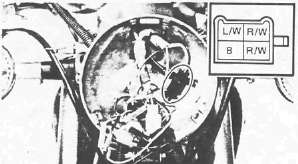
|
Switch position |
Lead color |
|
|
R/W |
R/W |
|
|
RUN |
|
|
|
OFF |
|
|
"START" Switch
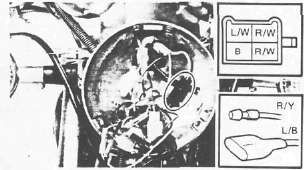
|
Switch position |
Lead color |
|||
|
L/W |
B |
R/Y |
L/B |
|
|
OFF |
|
|
|
|
|
ON |
|
|
|
|
"LIGHTS" (Dimmer) Switch
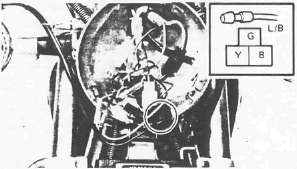
|
Switch position |
Lead color |
||
|
Y |
L/B |
G |
|
|
HI |
|
|
|
|
LO |
|
|
|
"HORN" Switch
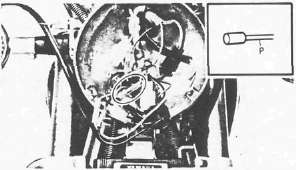
|
Switch position |
Lead color |
|
|
P |
Ground or B |
|
|
PUSH |
|
|
|
OFF |
|
|
'TURN" Switch

|
Switch position |
Lead color |
|||||
|
Dg |
Br/W |
Ch |
Y/R |
B |
||
|
R |
|
|
|
|
|
|
|
N |
R |
|
|
|
|
|
|
N |
|
|
|
|
|
|
|
L |
|
|
|
|
|
|
|
L |
|
|
|
|
|
|
Oil Level Switch
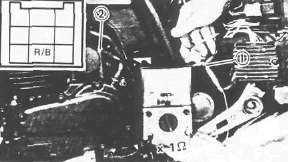
|
Switch position |
Lead color |
|
|
R/B |
Ground |
|
|
ON |
|
|
|
OFF |
|
|
Front Brake Switch
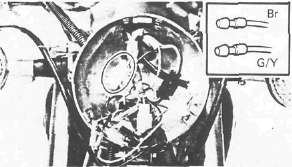
|
Switch position |
Lead color |
|
|
Br |
G/Y |
|
|
ON |
|
|
|
OFF |
|
|
Rear Brake Switch

1 Switch body
2 Adjusting nut
|
Switch position |
Lead color |
|
|
Y |
Y |
|
|
ON |
|
|
|
OFF |
|
|
Chapter 7, APPENDICES
Chapter 7, APPENDICESMaintenance Specifications -- Chassis
Maintenance Specifications -- ChassisChassis
|
Steering System: Steering Bearing Type |
Taper Roller Bearing |
|
|
Front Suspension: (Each) Front Fork Travel Fork Spring Free Length Spring Rate/Stroke Optional Spring Oil Capacity Oil Grade Enclosed Air Pressure: Standard Minimum- Maximum |
150 mm (5.9 in) 511 mm (20.1 in) K, = 3.92 N/mm (0.40 kg/mm, 22.4 lb/in) 0- 100 mm (0- 3.94 in) K2 = 4.90 N/mm (0.50 kg/mm, 28 lb/in) 100- 150 mm (3.94- 5.90 in) No. 389 cm3 (13.7 Imp oz, 13.2 US oz) YAMAHA Fork & Shock Oil 10wt or equivalent fork oil 39.2 kPa (0.4 kg/cm2, 5.7 psi) Zero- 118 kPa (Zero - 1.2 kg/cm2, Zero - 17.1 psi) |
|
|
Rear Suspension: (Each) Shock Absorber Travel Spring Free Length Spring Fitting Length Spring Rate/Stroke |
70 mm (2.76 in) 243.5 mm (9.59 in) 217.5 mm (8.56 in) K, = 21.6 N/mm (2.2 kg/mm, 123.2 lb/in) |
|
|
Rear Arm: Swingarm Free Play Limit: |
1.0 mm (0.04 in) |
|
|
Wheel: Front Wheel Type Rear Wheel Type Front Rim Size/Material Rear Rim Size/Material Rim Runout Limit: |
Cast Wheel Cast Wheel MT2.15x 19/Aluminum MT3.00x 16/Aluminum
2.0 mm (0.08 in) |
|
|
Disc Brake: Outside Dia. x Thickness |
Dual disc 267 x 5 mm (10.5 x 0.2 in) |
|
|
Pad Thickness:
|
Inner Outer |
5.5 mm (0.22 in) 5.5 mm (0.22 in) |
|
Master Cylinder Inside Dia. Caliper Cylinder Inside Dia. Brake Fluid Type |
15.87 mm (0.62 in) 38.18 mm (1.50 in) DOT #3 |
|
|
Drum Brake: Type Rear Drum Inside Dia. <Limit> Lining Thickness <l_imit> Shoe Spring Free Length
|
Leading trailing 200 mm (7.87 in) 201 mm (7.91 in) 4 mm (0.16 in) 2 mm (0.08 in) 68 mm (2.7 in)
|
|
| Brake Lever & Brake Pedal:
Brake Lever Free Play Brake Pedal Position Brake Pedal Free Play |
2-5mm (0.08 - 0.20 in)/at lever end 10 mm (0.4 in) below the top of the footrest 20-30mm (0.8- 0.12 in) |
|
| Clutch Lever Free Play: | 2 - 3 mm (0.08 - 0.12 in)/at lever pivot | |
Tightening torque
|
Part to be tightened |
Part name |
Thread size |
Q'ty |
Tightening torque |
Remarks |
||
|
Nm |
m-kg |
fflb |
|||||
|
Engine mounting bolt: |
Nut |
M10 P1.25 M10P1.25 |
1 |
42 |
4.2 |
30 |
|
|
Rear |
Nut |
M12 P1.25 |
2 |
90 |
9.0 |
65 |
|
|
Engine mounting stay |
Nut |
M8 P1.25 |
4 |
33 |
3.3 |
24 |
|
|
Downtube |
Bolt |
M8 P1.25 |
4 |
33 |
3.3 |
24 |
|
|
Downtube & Cross pipe |
Nut |
M8 P1.25 |
2 |
33 |
3.3 |
24 |
|
|
Handle crown & Steering shaft |
Nut |
M20 P1.0 |
1 |
110 |
11 |
80 |
|
|
Ring nut (Lower) |
Nut |
M22 P1.0 |
1 |
6 |
0.6 |
4.3 |
See page 6-25 |
|
Handle crown & Inner tube |
Nut |
M8 P1.25 |
2 |
20 |
2.0 |
14 |
|
|
Handle crown & Handlebar holder |
Bolt |
M8 PI.25 |
4 |
20 |
2.0 |
14 |
|
|
Under bracket & Inner tube |
Bolt |
M8 PI.25 |
4 |
23 |
2.3 |
17 |
|
|
Front wheel axle |
Nut castle |
M14 P1.5 |
1 |
105 |
10.5 |
75 |
|
|
Front wheel axle pinch bolt |
Nut self locking |
M8 P1.25 |
1 |
20 |
2.0 |
14 |
|
|
Pivot shaft (Right) |
Bolt |
M22P1.5 |
1 |
5.5 |
0.55 |
4.0 |
Taper roller bearing |
|
Pivot shaft (Left and Right) |
Bolt/Nut |
M22P1.5 |
1 |
100 |
10.0 |
72 |
|
|
Rear wheel axle |
Nut castle |
M14P1.5 |
1 |
105 |
10.5 |
75 |
|
|
Rear wheel axle pinch bolt |
Bolt |
M8 P1.25 |
1 |
20 |
2.0 |
14 |
|
|
Rear shock absorber (Upper). |
Nut cap |
M8 P1.25 |
2 |
20 |
2.0 |
14 |
|
|
Rear shock absorber (Lower) |
L Nut cap R Bolt |
M10P1.25 |
2 |
30 |
3.0 |
22 |
|
|
Footrest |
Bolt |
M8 P1.25 |
4 |
29 |
2.9 |
21 |
|
|
Tension bar & Brake plate |
Bolt |
M8 P1.25 |
1 |
20 |
2.0 |
14 |
|
|
Tension bar & Rear arm |
Bolt |
M8 P1.25 |
1 |
20 |
2.0 |
14 |
|
|
Camshaft lever & Camshaft |
Bolt |
M6 P1.0 |
1 |
9 |
0.9 |
6.5 |
|
|
Disc brake section: Brake disc & Hub (Front) |
Bolt |
M8 P1.25 |
12 |
20 |
2.0 |
14 |
|
|
Master cylinder & Brake hose (Front) |
Bolt union |
M10 P1.25 |
1 |
26 |
2.6 |
19 |
|
|
Brake hose & Joint |
Bolt union |
M10 P1.25 |
1 |
26 |
2.6 |
19 |
|
|
Caliper & Brake hose |
Bolt union |
M10 P1.25 |
2 |
26 |
2.6 |
19 |
|
|
Caliper & Front fork (Front) |
| |
M10 P1.25 |
4 |
35 |
3.5 |
25 |
|
|
Caliper bleed screw (Ftont) |
I |
M8 P1.25 |
2 |
6 |
0.6 |
4.3 |
|
|
Front fender |
Bolt |
M6 P1.0 |
4 |
9 |
0.9 |
6.5 |
|
|
Final gear & Rear arm |
Nut |
M10P1.25 |
4 |
42 |
4.2 |
30 |
|
|
Final gear: |
|||||||
|
Drive shaft |
Nut |
M14P1.5 |
1 |
110 |
11 |
80 |
Oil |
|
Bearing housing |
Flange bolt |
M8 PI.25 |
4 |
25 |
25 |
18 |
|
|
Bearing housing |
Nut |
M8 P1.25 |
6 |
23 |
2.3 |
17 |
|
|
Oil filler cap |
Plug |
M14P1.5 |
1 |
23 |
2.3 |
17 |
|
|
Oil drain screw |
Plug |
M14P1.5 |
1 |
23 |
2.3 |
17 |
|
|
Bearing retainer |
- |
M65P1.5 |
1 |
110 |
11 |
80 |
Left-hand thread |
|
Cross joint |
Hexagon bolt with washer |
M8 PI .25 |
4 |
44 |
4.4 |
32 |
|
|
Muffler bracket & Frame |
Bolt |
M8 PI.25 |
3 |
23 |
2.3 |
17 |
|
|
Rear fender |
Bolt |
M10P1.25 |
2 |
32 |
3.2 |
23 |
|
|
Muffler bracket & Muffler |
Bolt |
M10P1.25 |
2 |
25 |
2.5 |
18 |
|
General Torque Specifications
General Torque SpecificationsGENERAL TORQUE SPECIFICATIONS
This chart specifies torque for standard fasteners with standard l.S.O. pitch threads. Torque specifications for special components or assemblies are included in the applicable sections of this book. To avoid warpage, tighten multi-fastener assemblies in a criss-cross fashion, in progressive stages, until full torque is reached. Unless otherwise specified, torque specifications call for clean, dry threads. Components should be at room temperature.
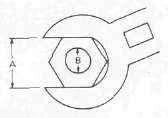
|
A (Nut) |
B (Bolt) |
General torque specifications |
||
|
Nm |
m-kg |
ft-lb |
||
|
10 mm |
6 mm |
6 |
0.6 |
4.3 |
|
12 mm |
8 mm |
15 |
1.5 |
11 |
|
14 mm |
10 mm |
30 |
3.0 |
22 |
|
17 mm |
12 mm |
55 |
5.5 |
40 |
|
19 mm |
14 mm |
85 |
8.5 |
61 |
|
22 mm |
16 mm |
130 |
13.0 |
94 |
DEFINITION OF UNITS
|
Unit |
Read |
Definition |
Measure |
|
mm cm |
millimeter centimeter |
10"3 meter 10-2 meter |
Length Length |
|
kg |
kilogram |
103 gram |
Weight |
|
N |
Newton |
1 kg x m/sec2 |
Force |
|
Nm |
Newton meter |
N x m |
Torque |
|
Pa N/mm |
Pascal Newton per millimeter |
N/m2 N/mm |
Pressure Spring rate |
|
L cm3 |
Liter Cubic centimeter |
|
Volume or Capacity |
|
r/min |
Rotation per minute |
|
Engine Speed |





